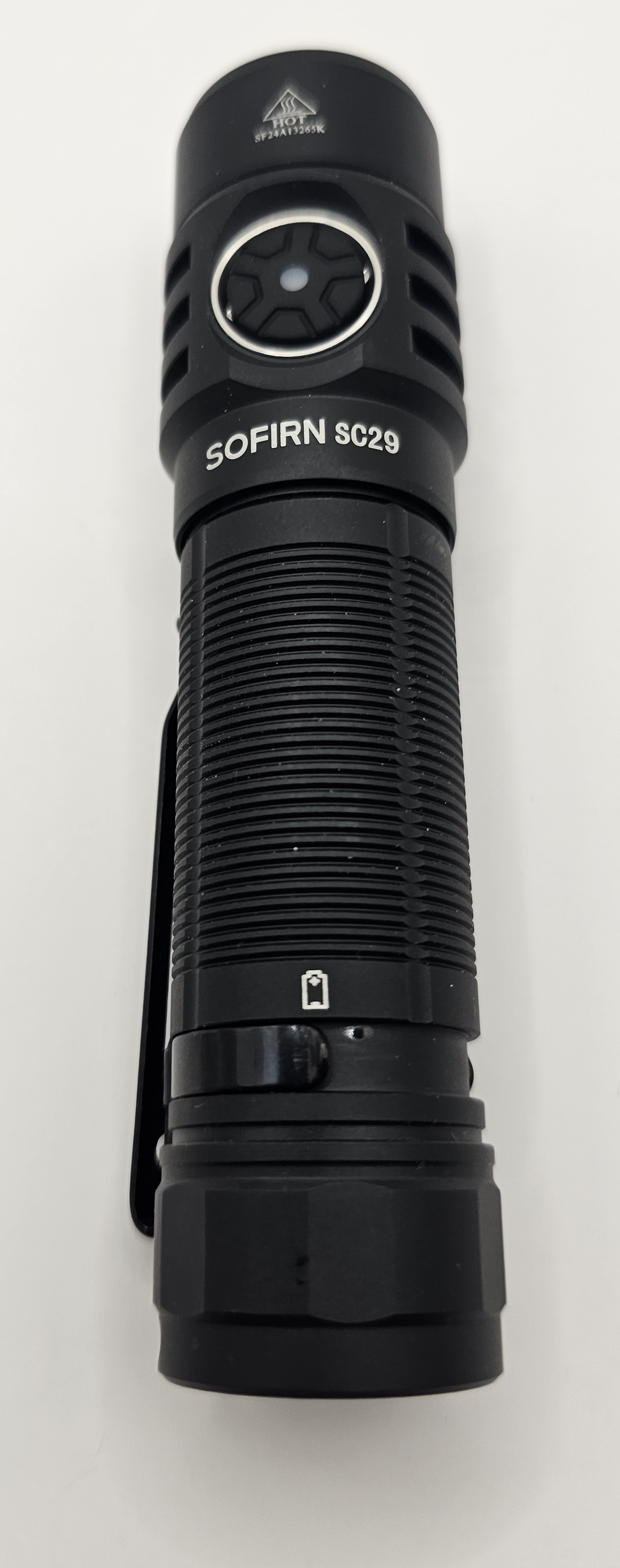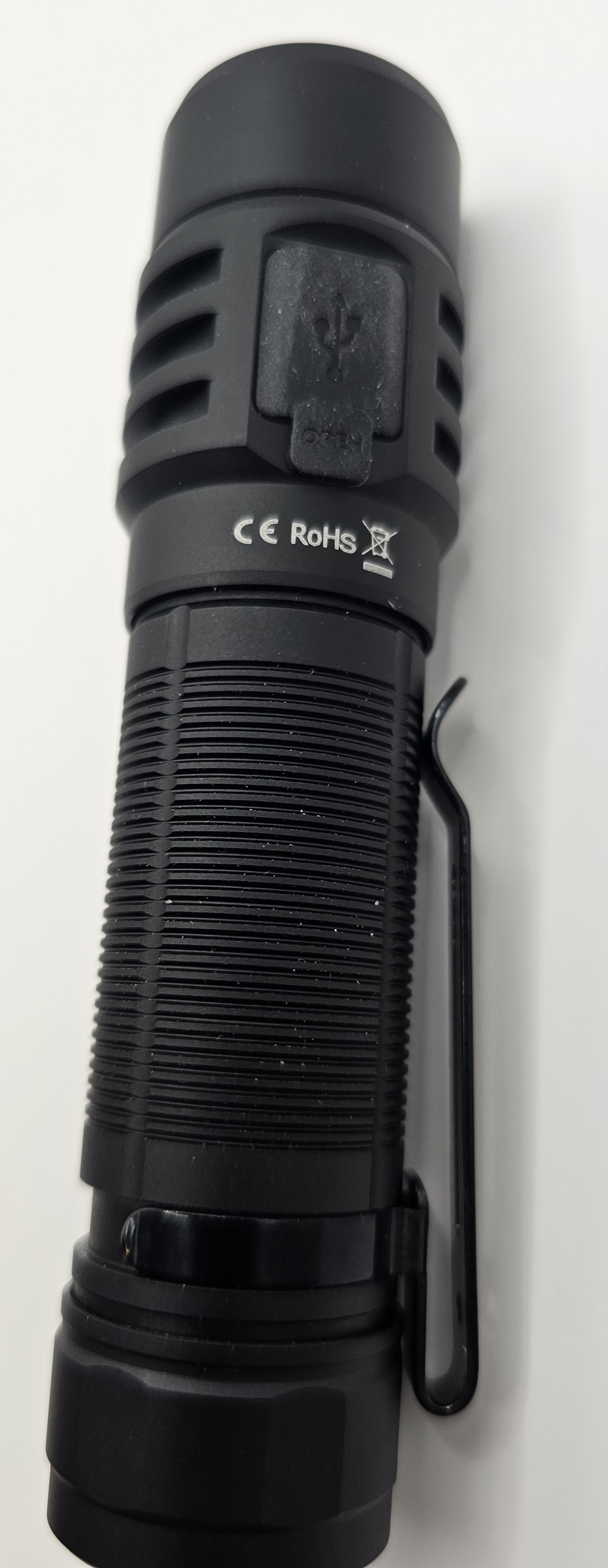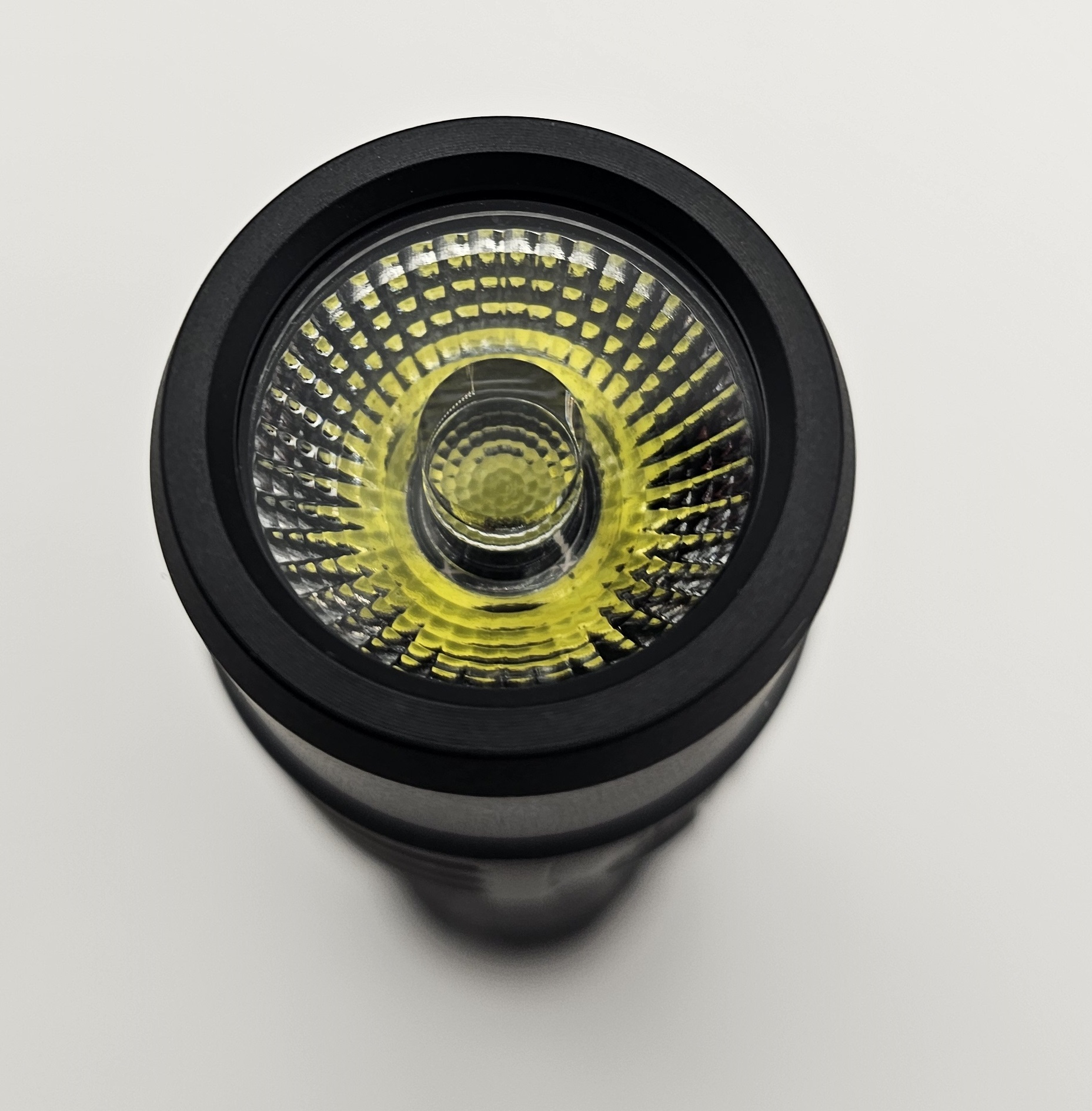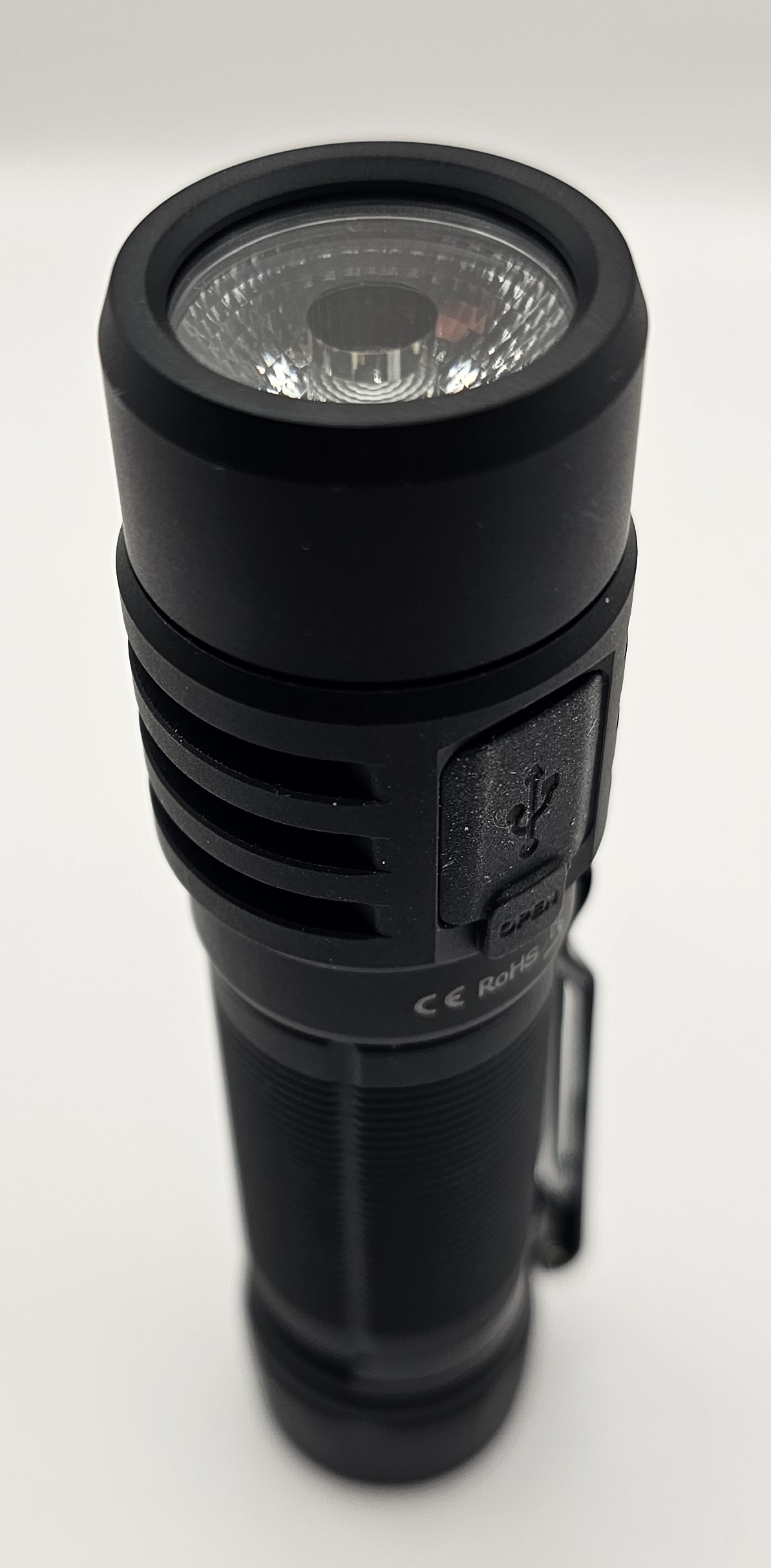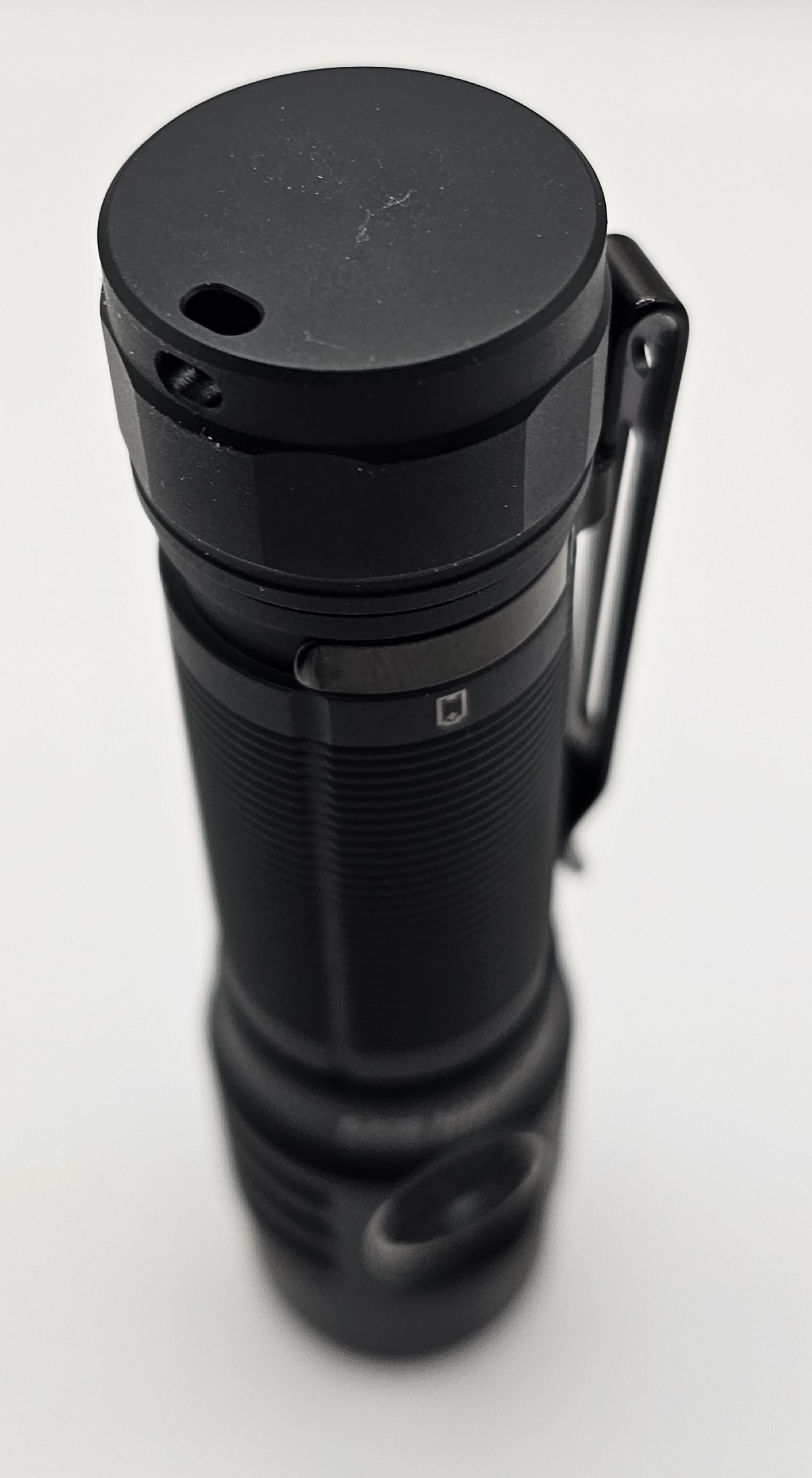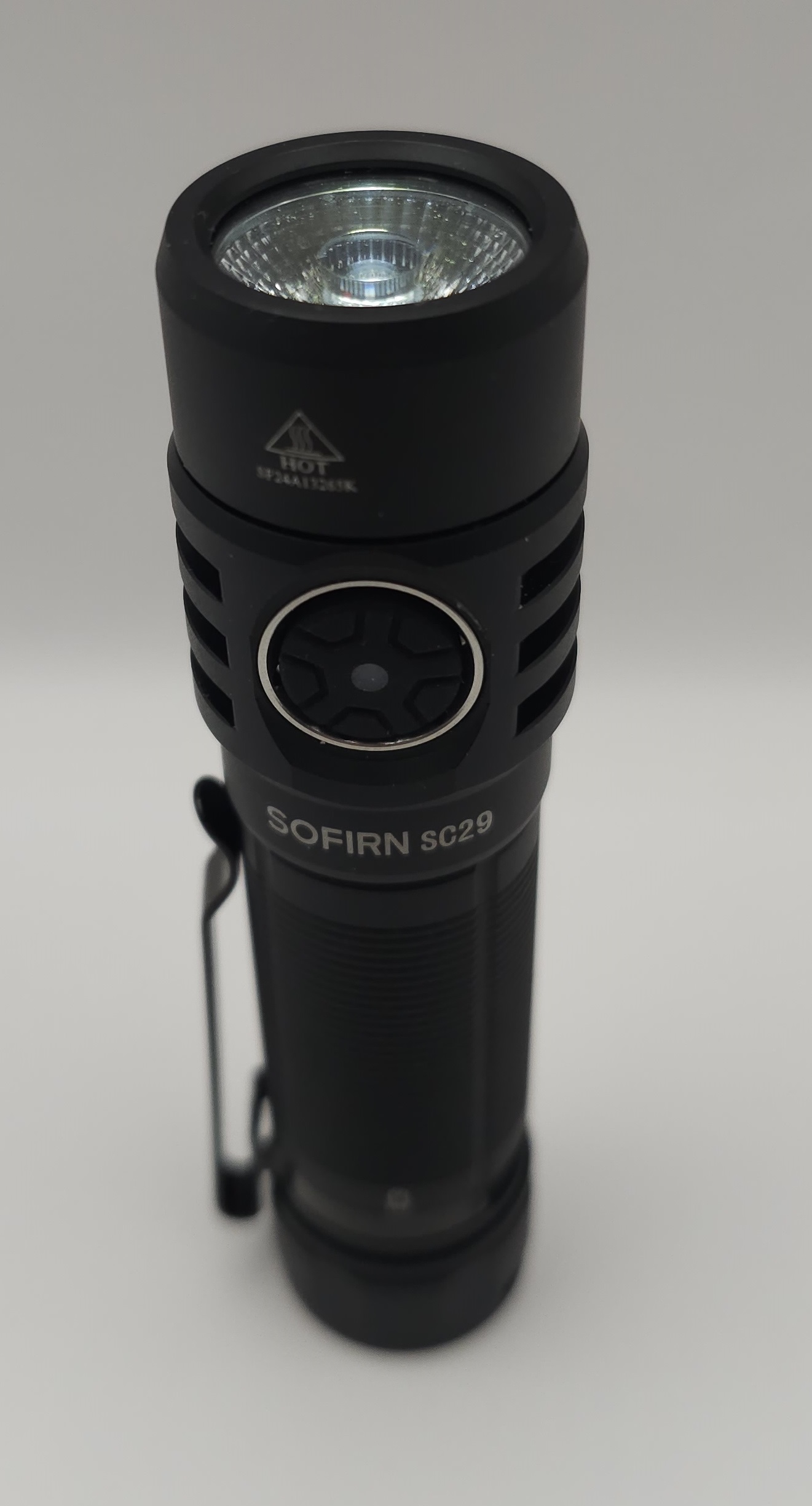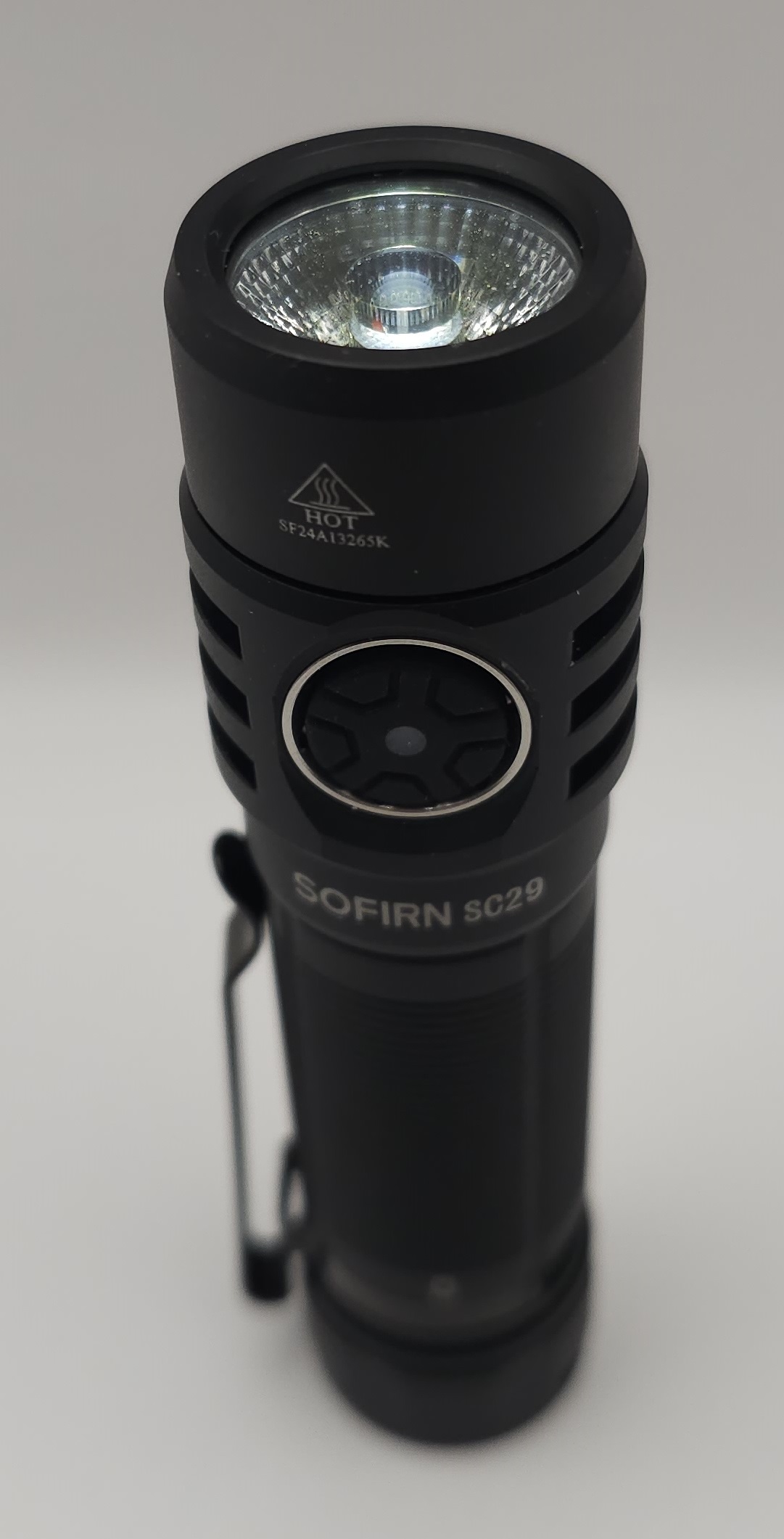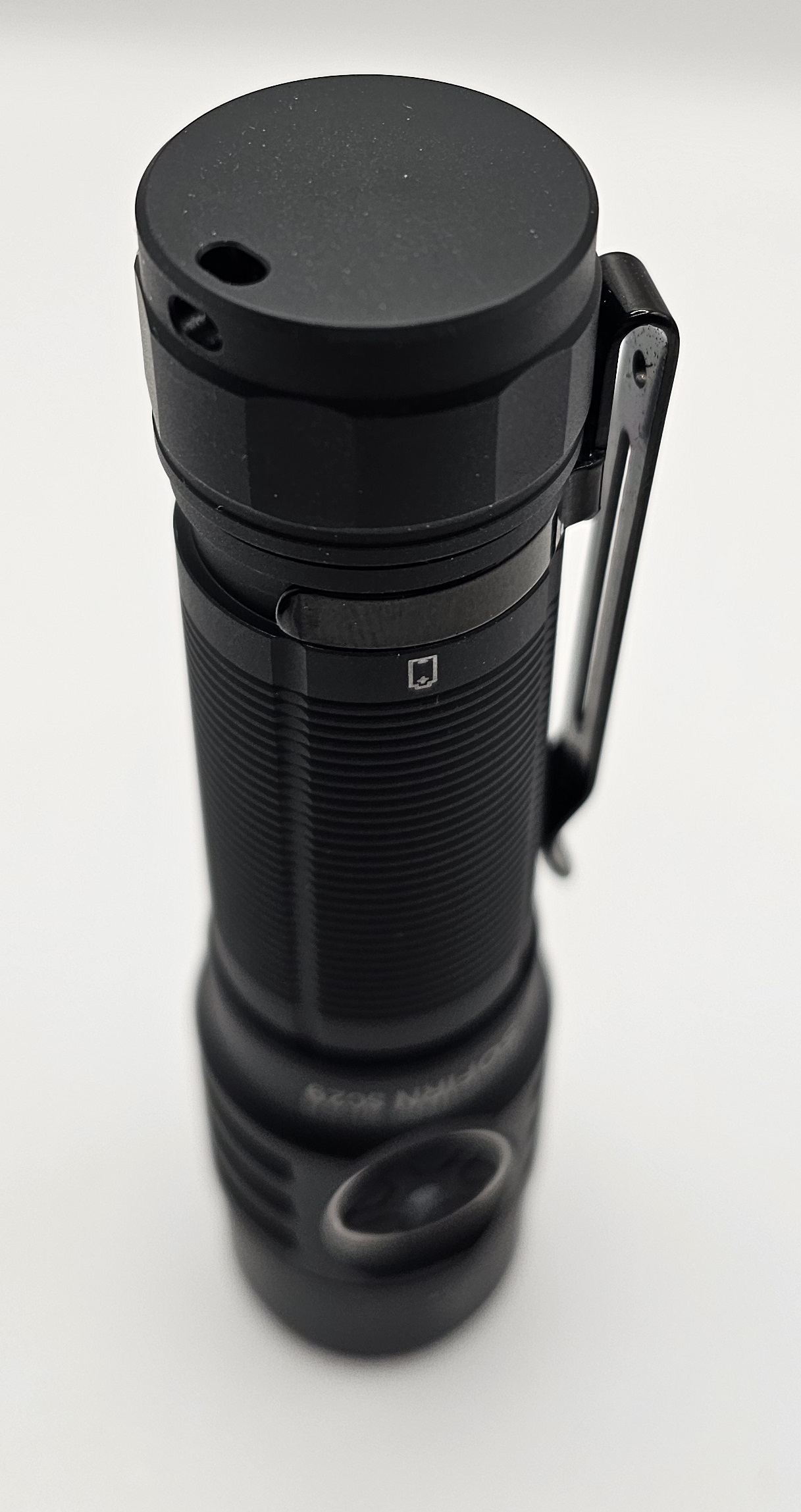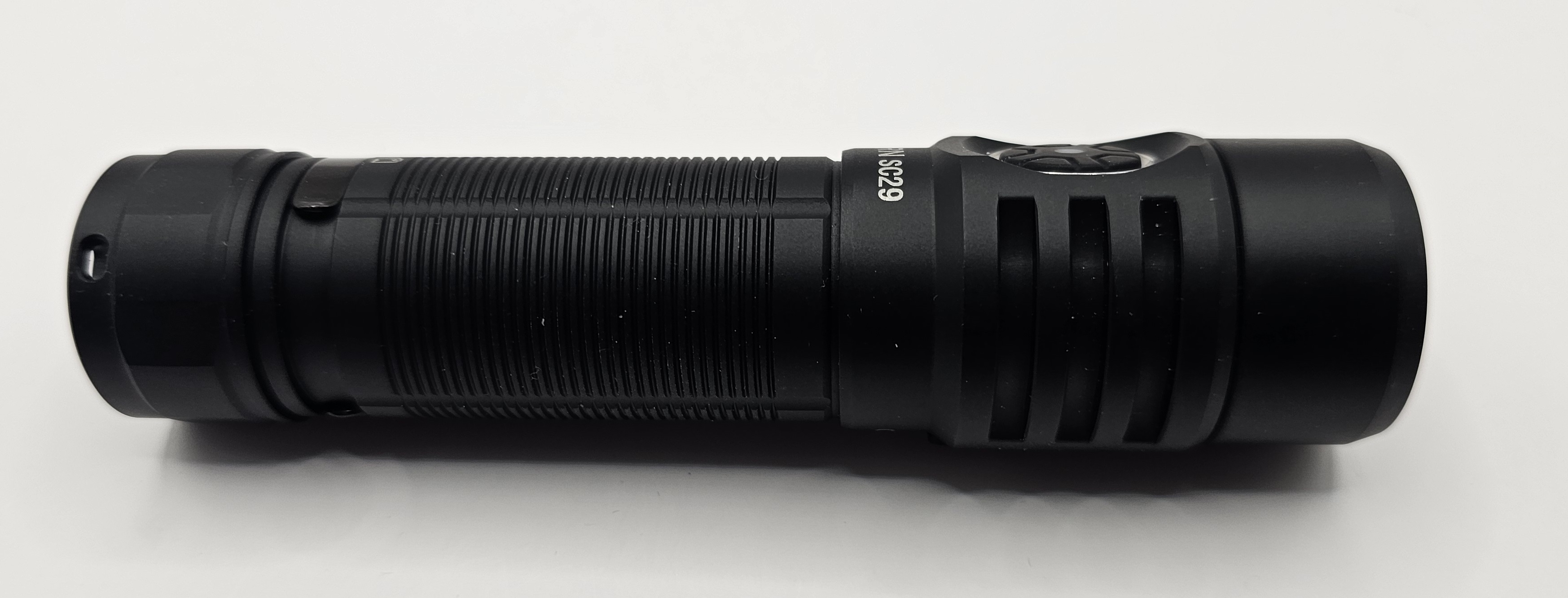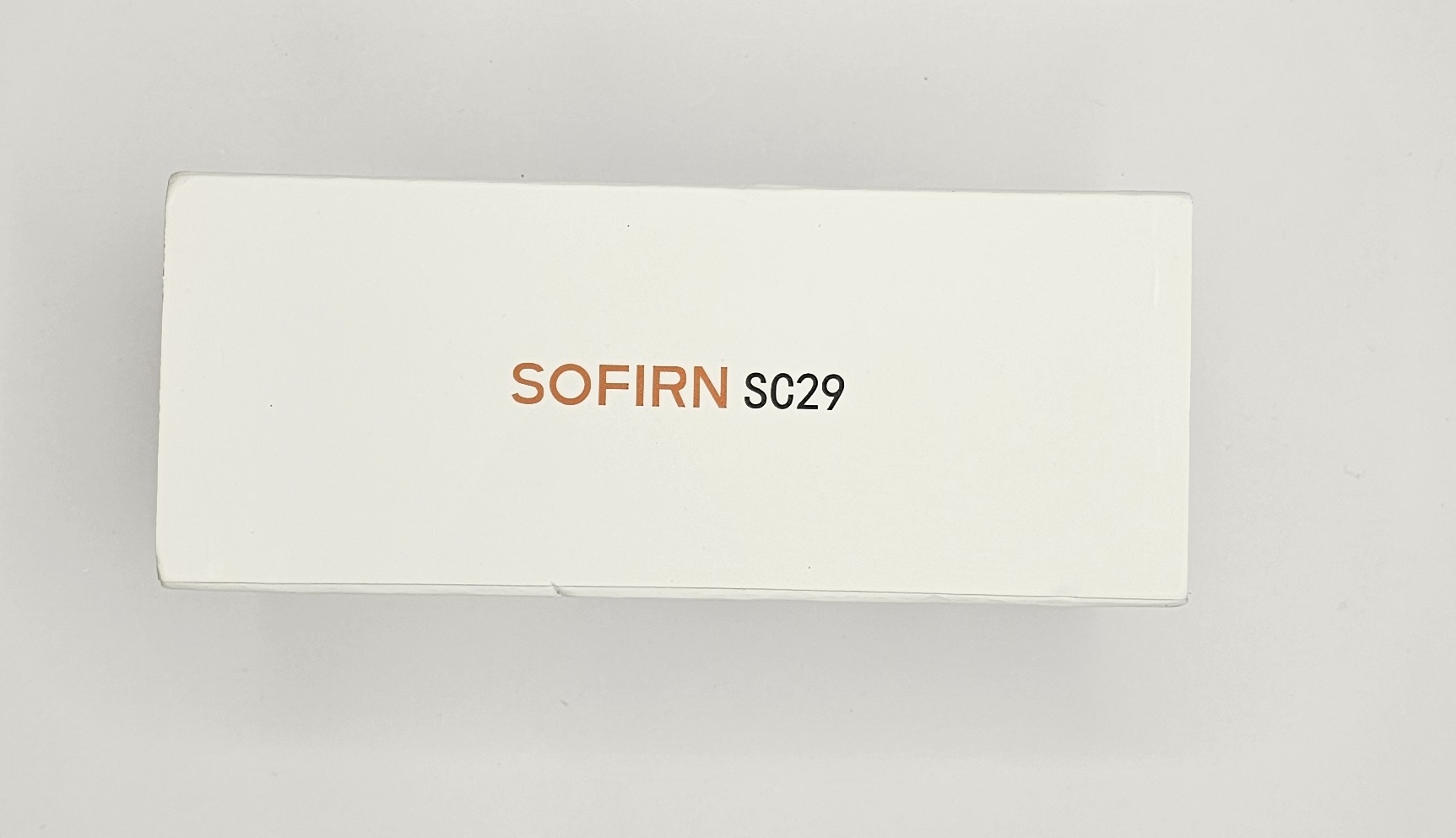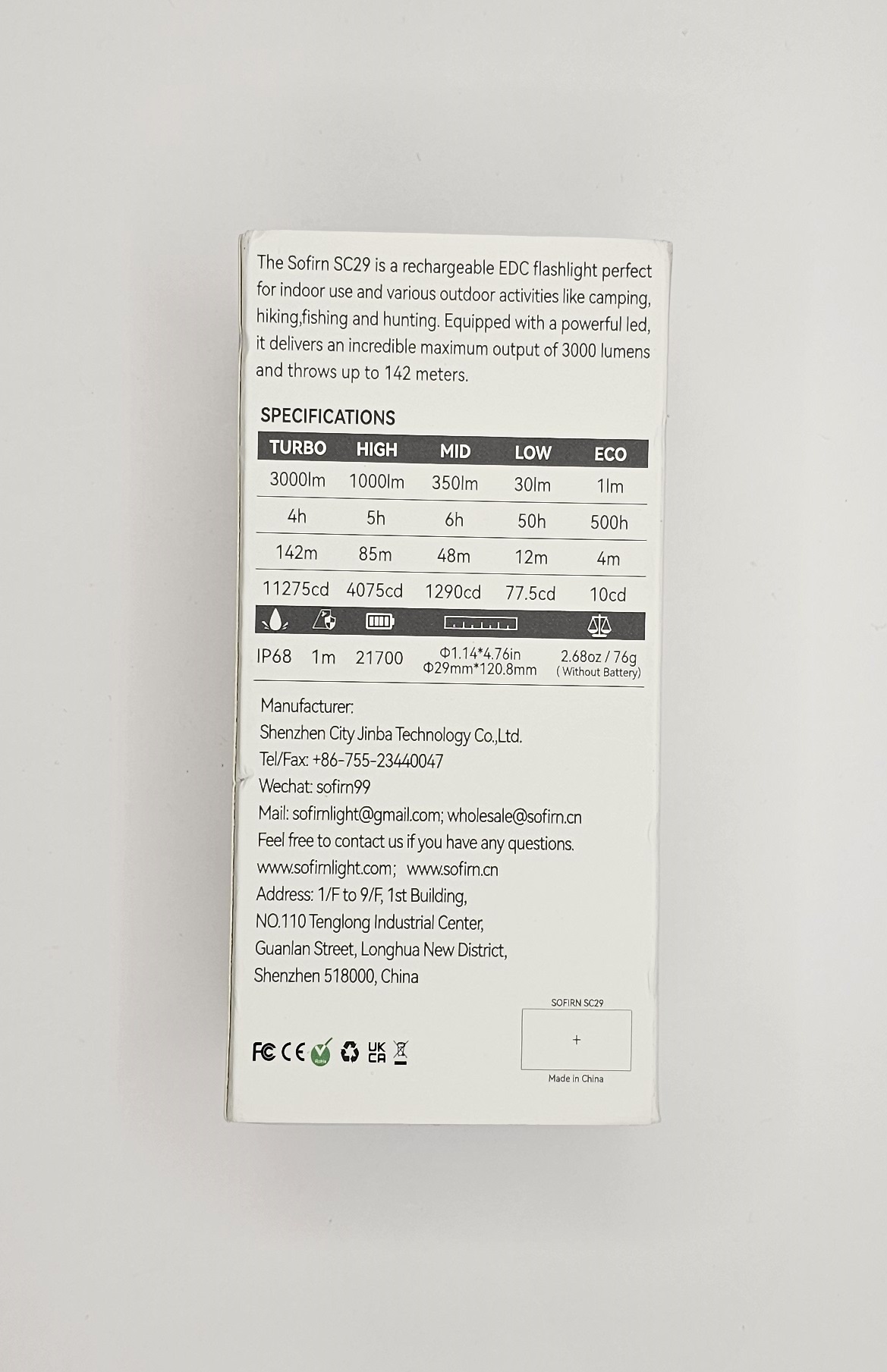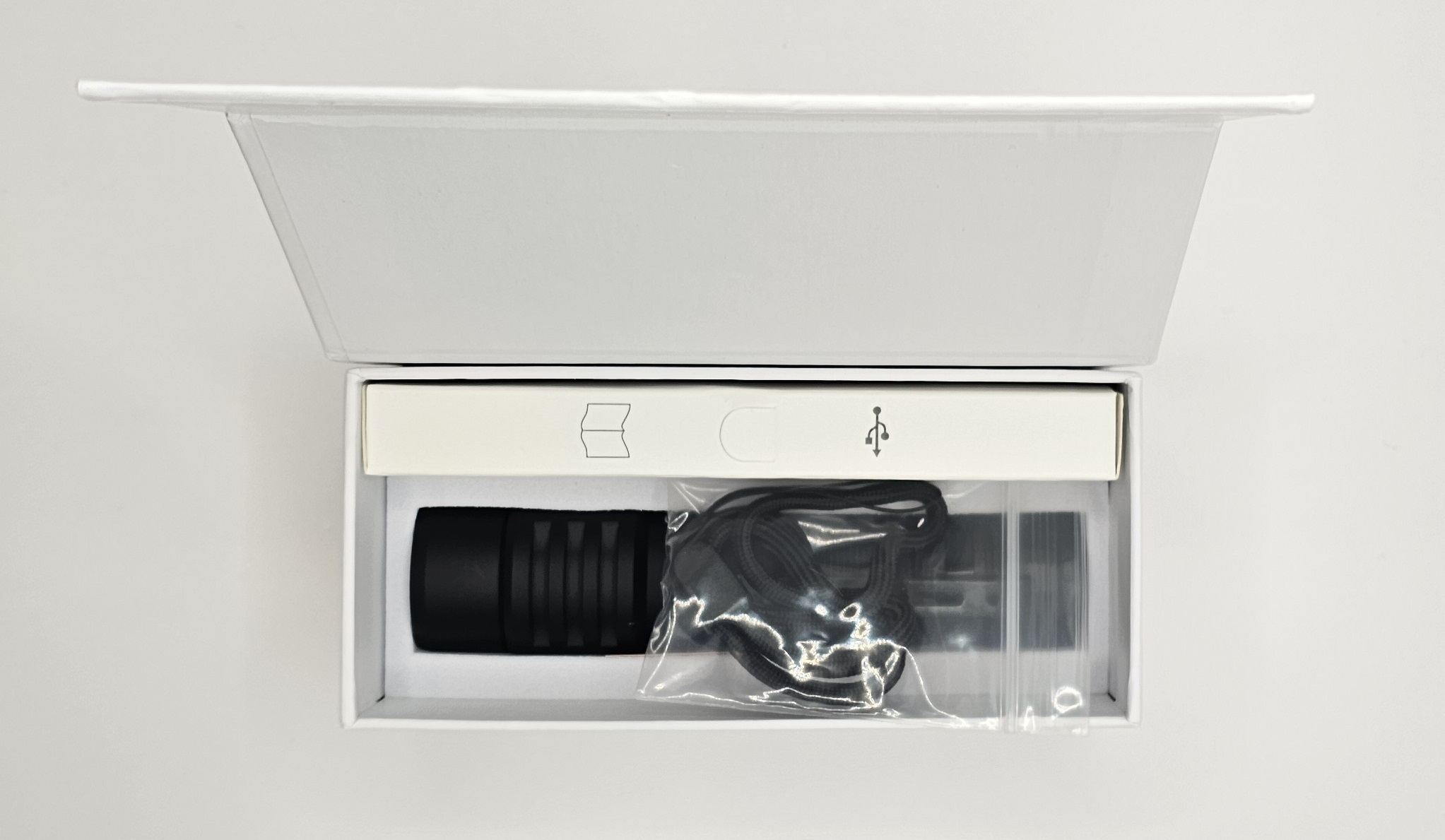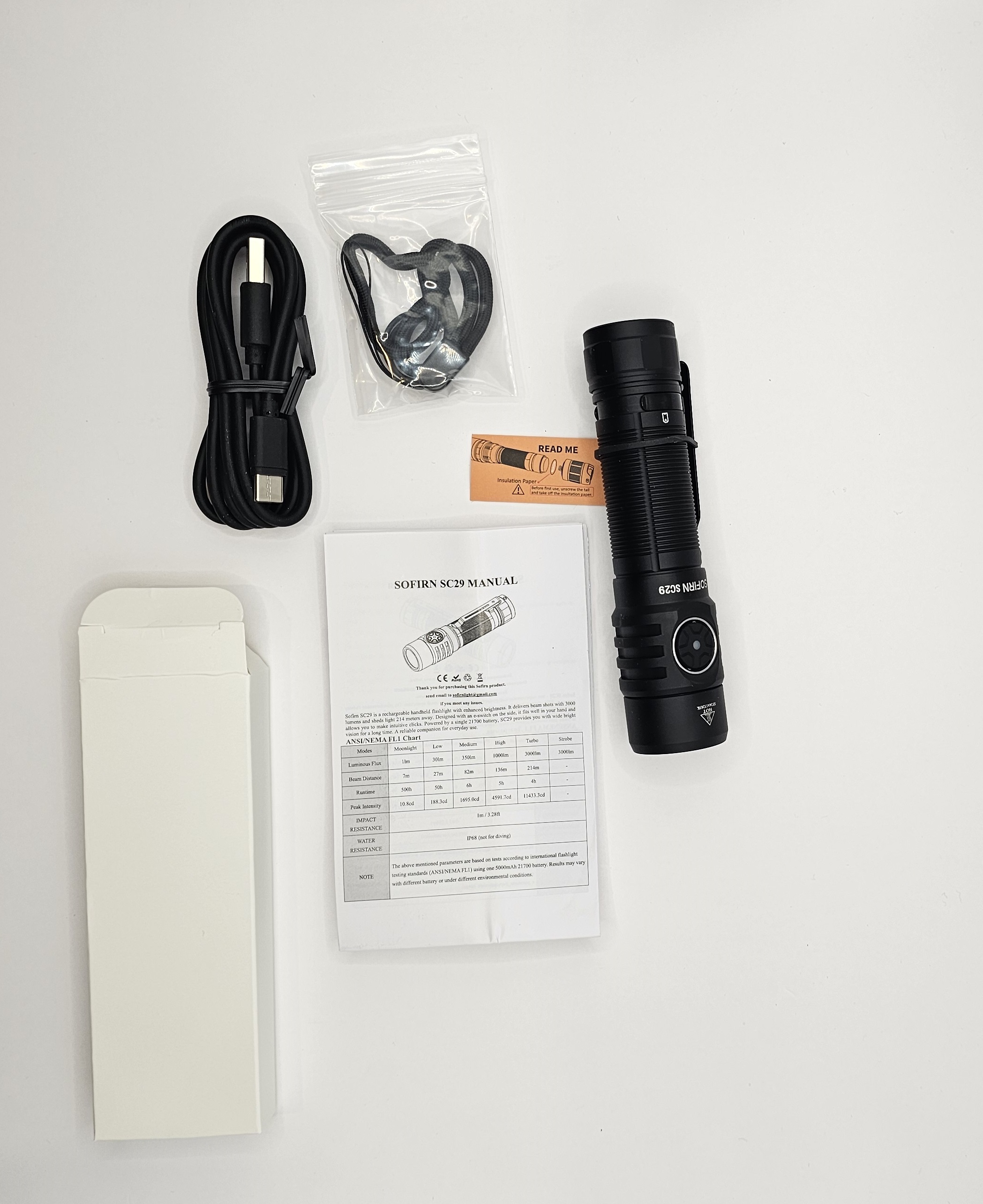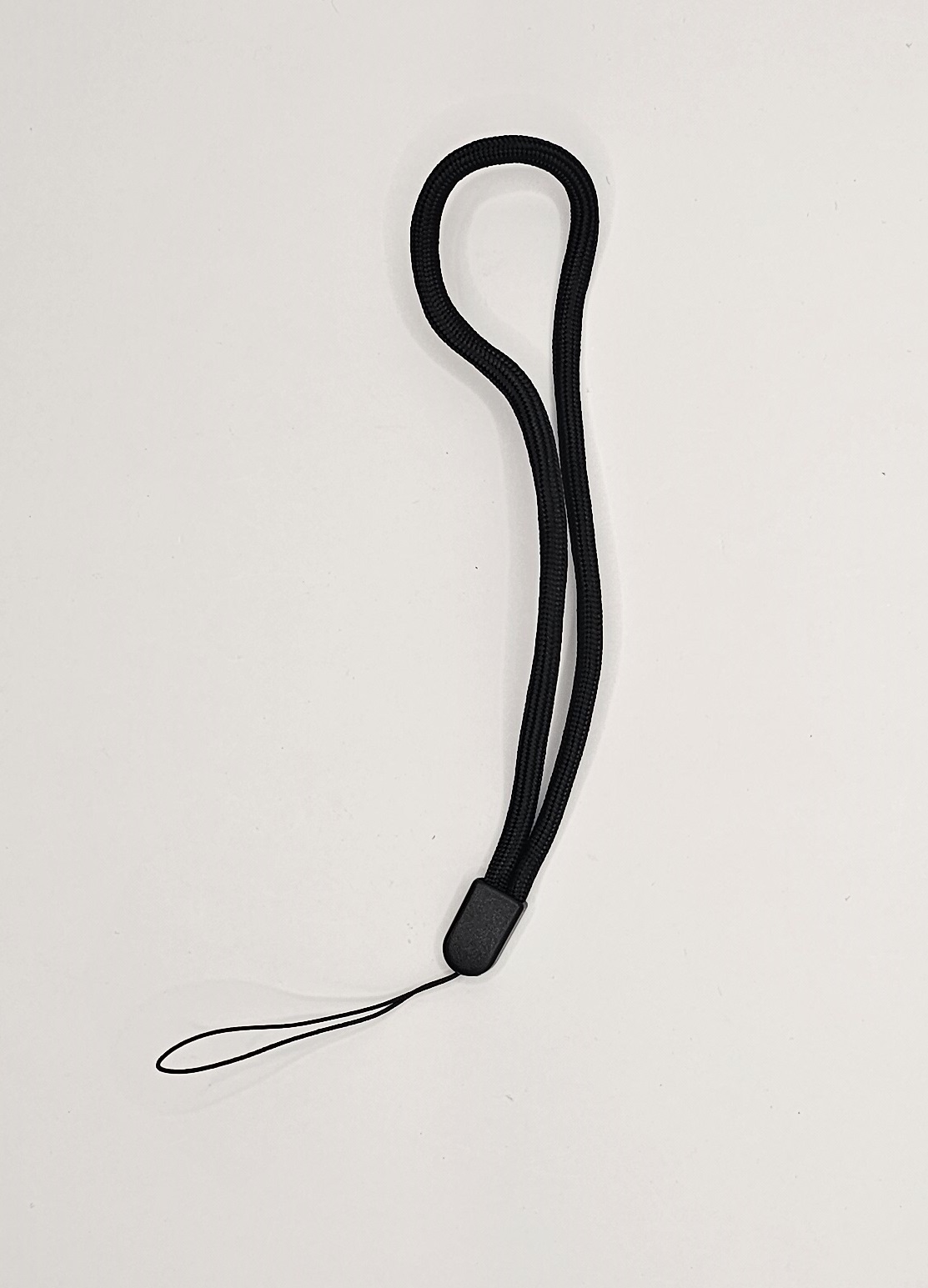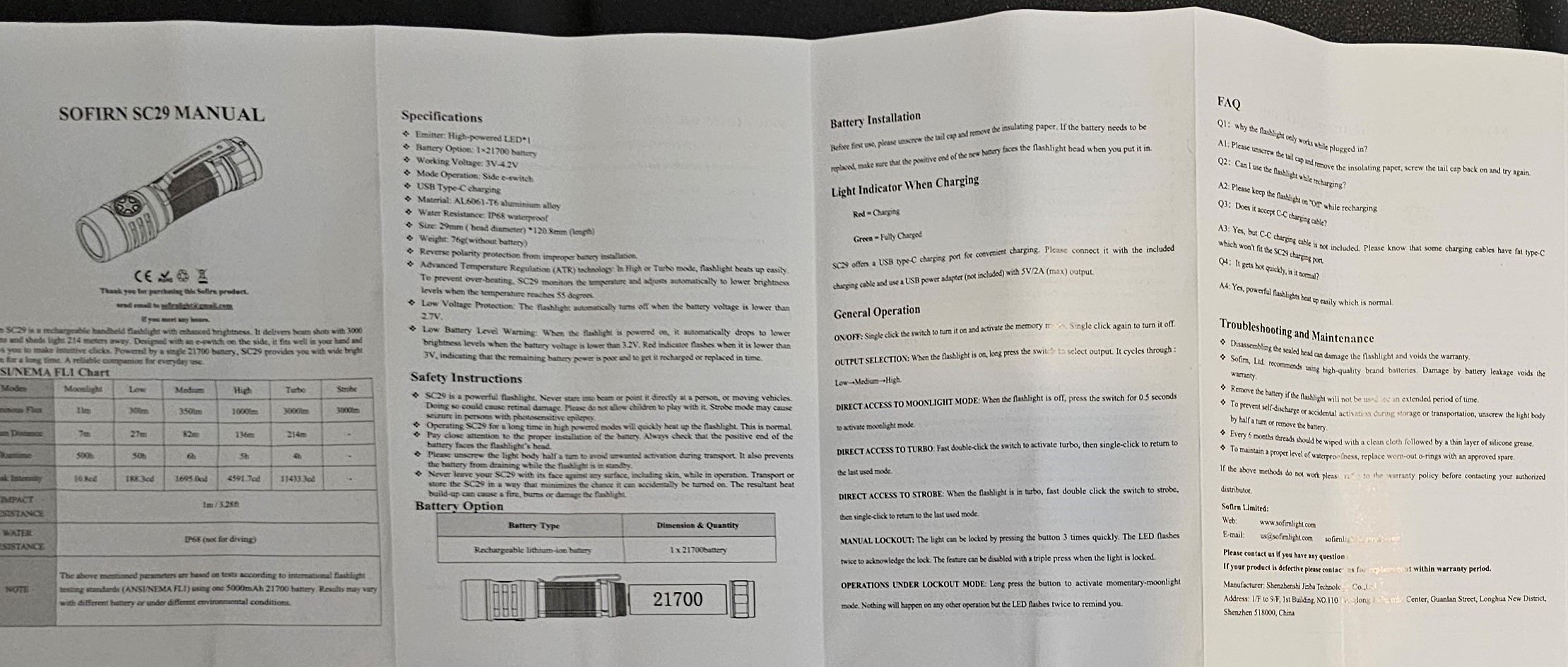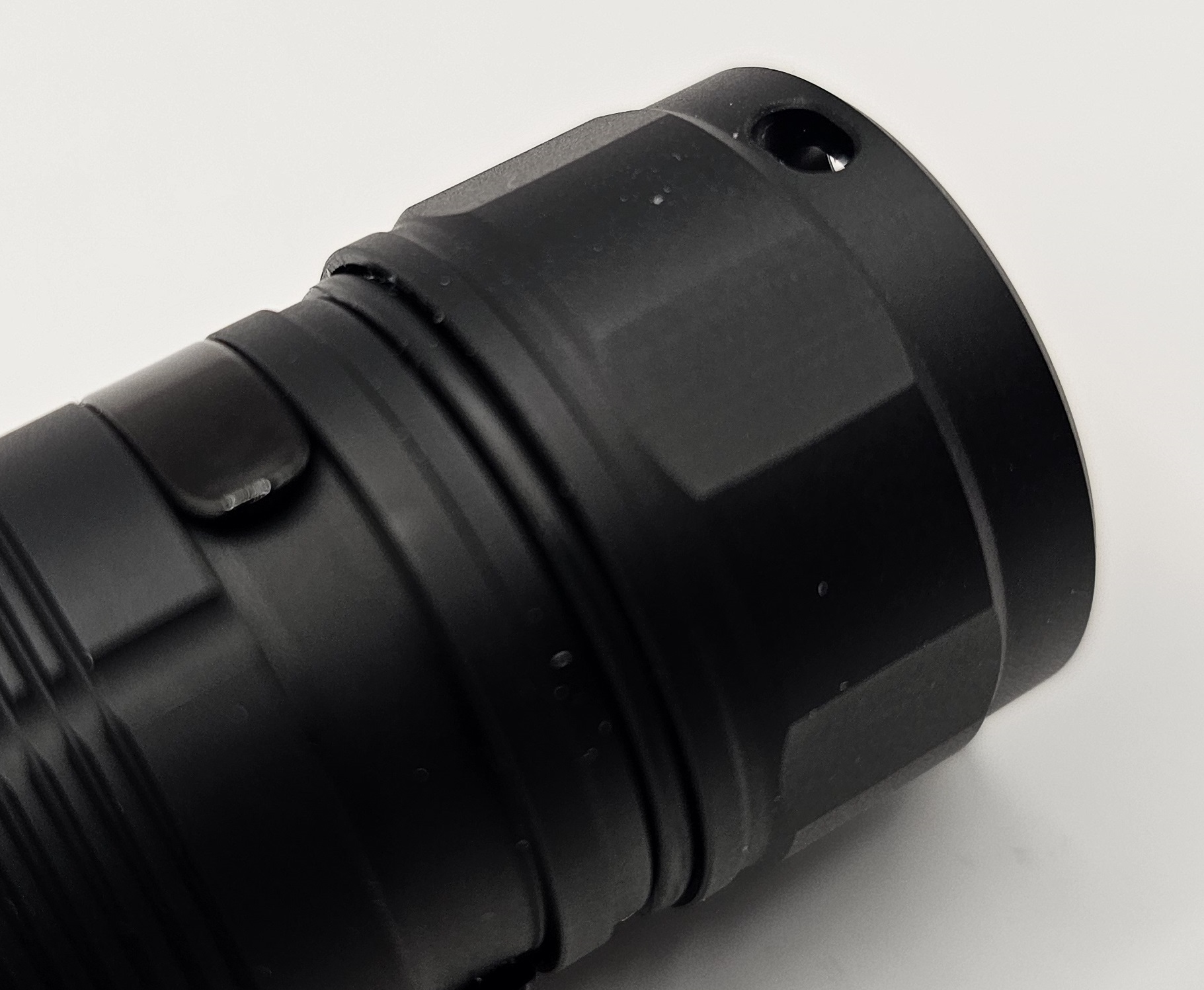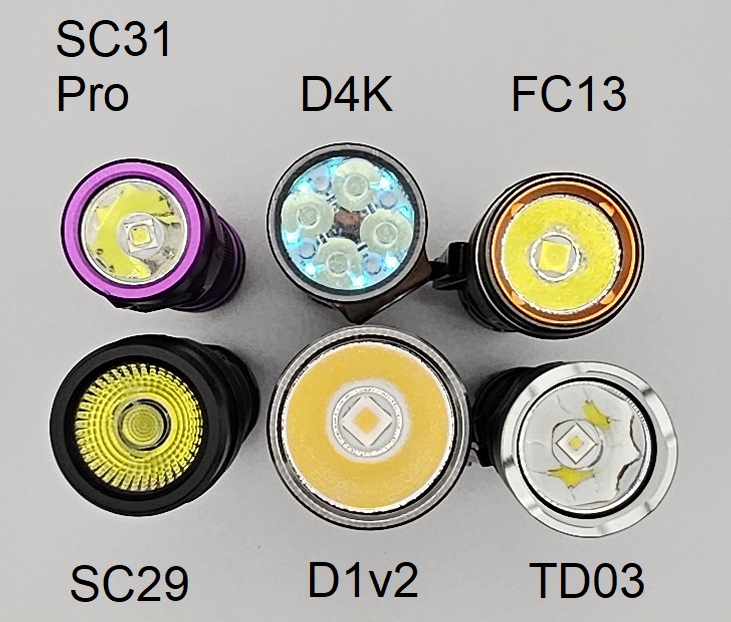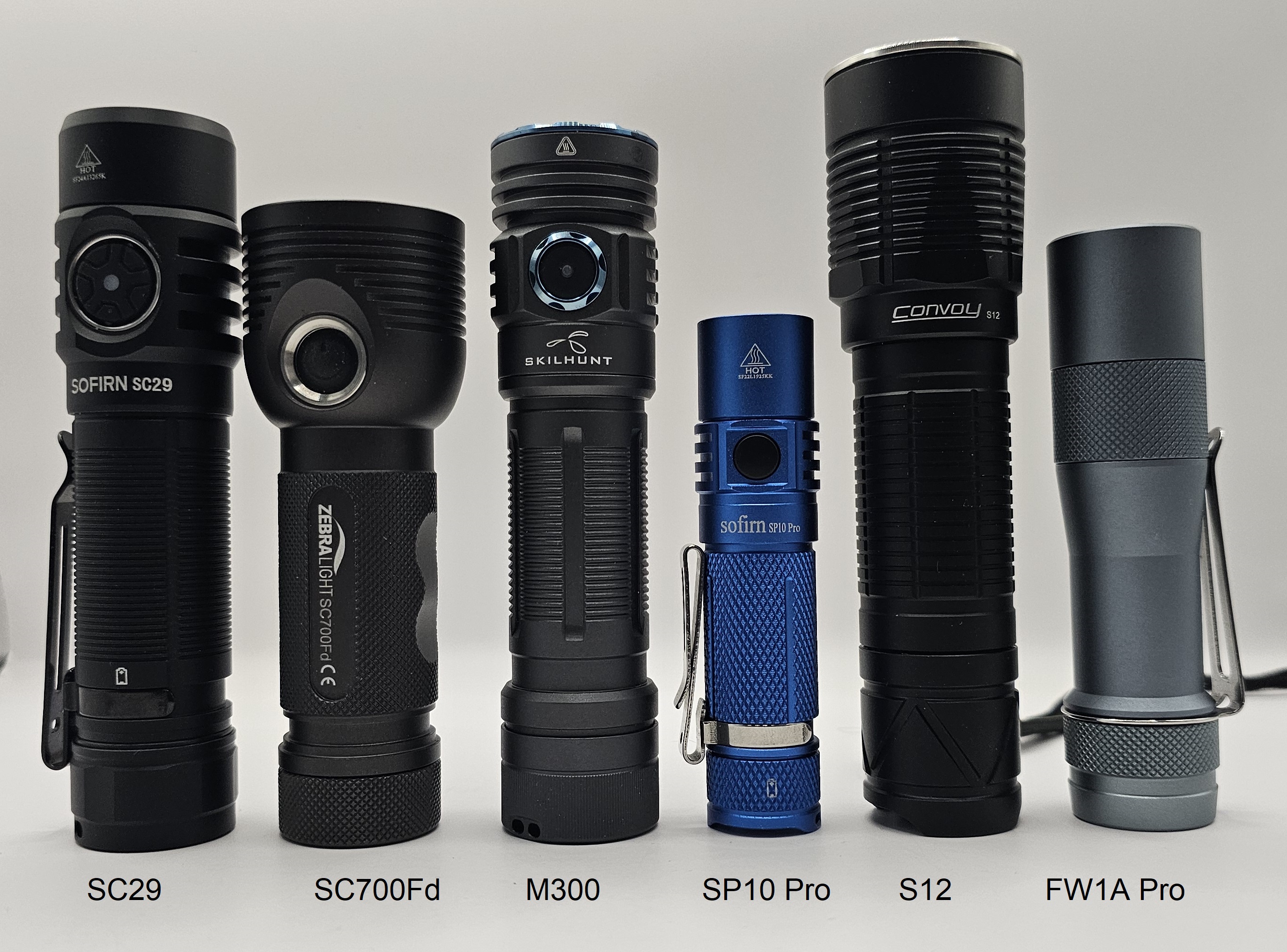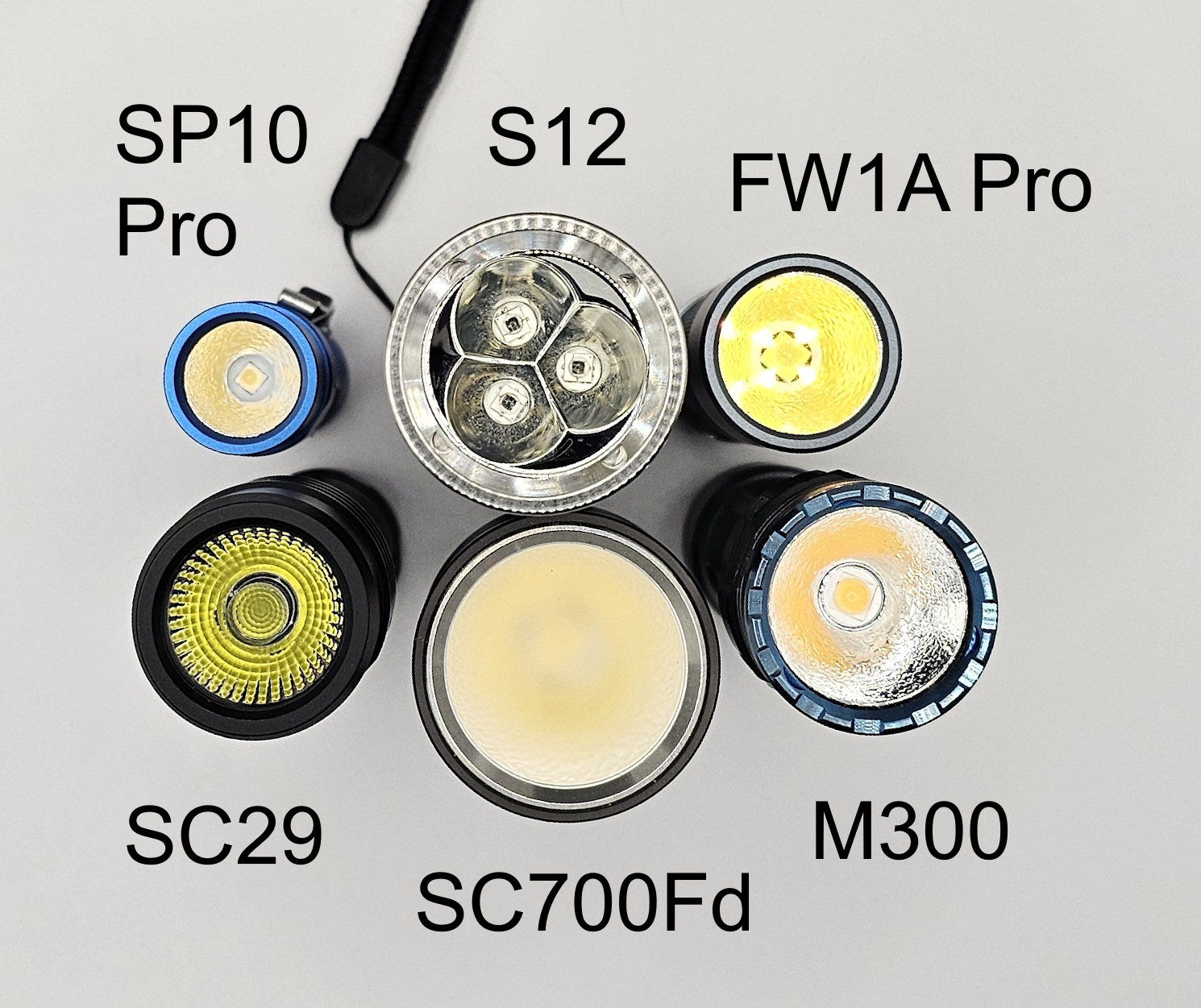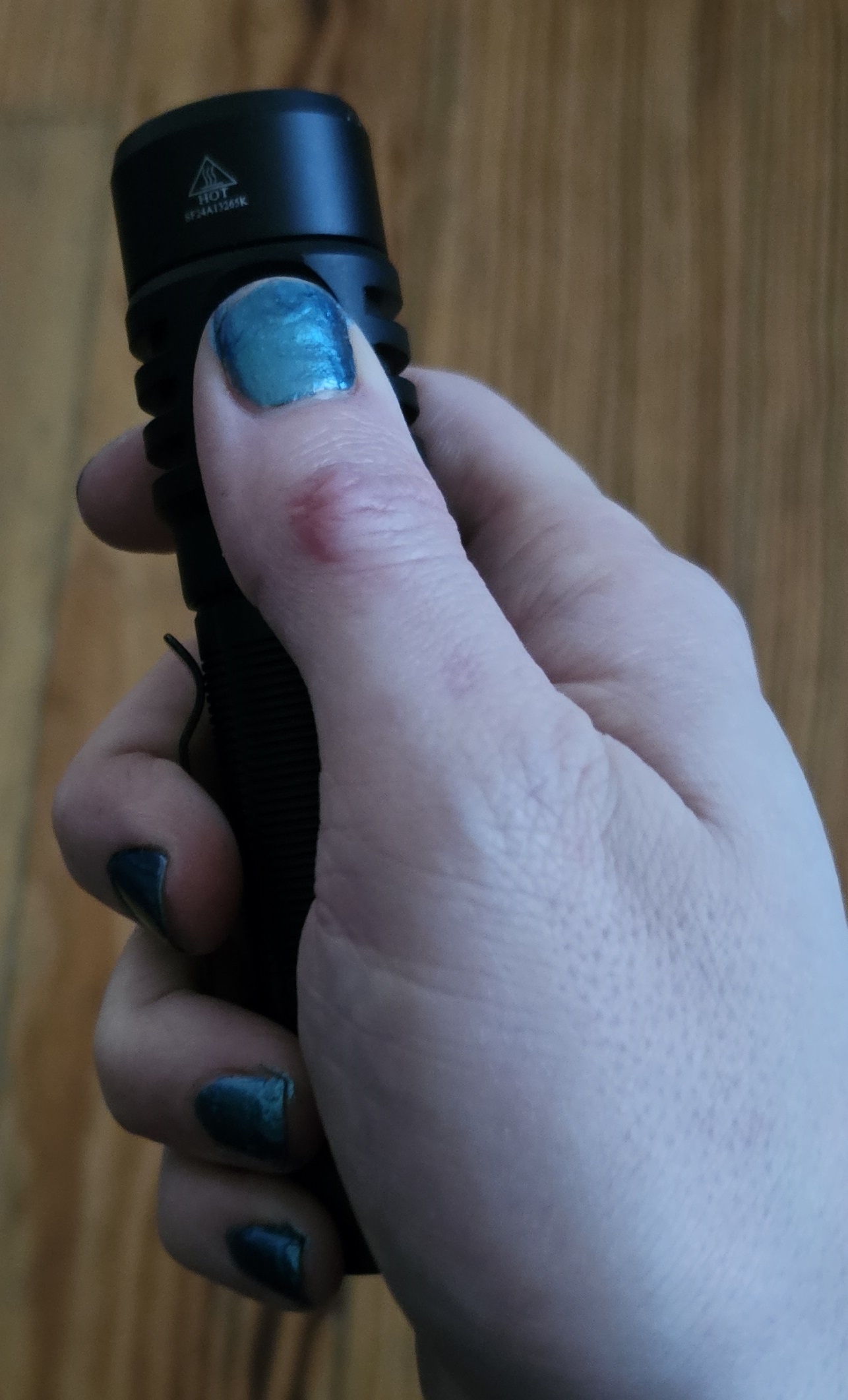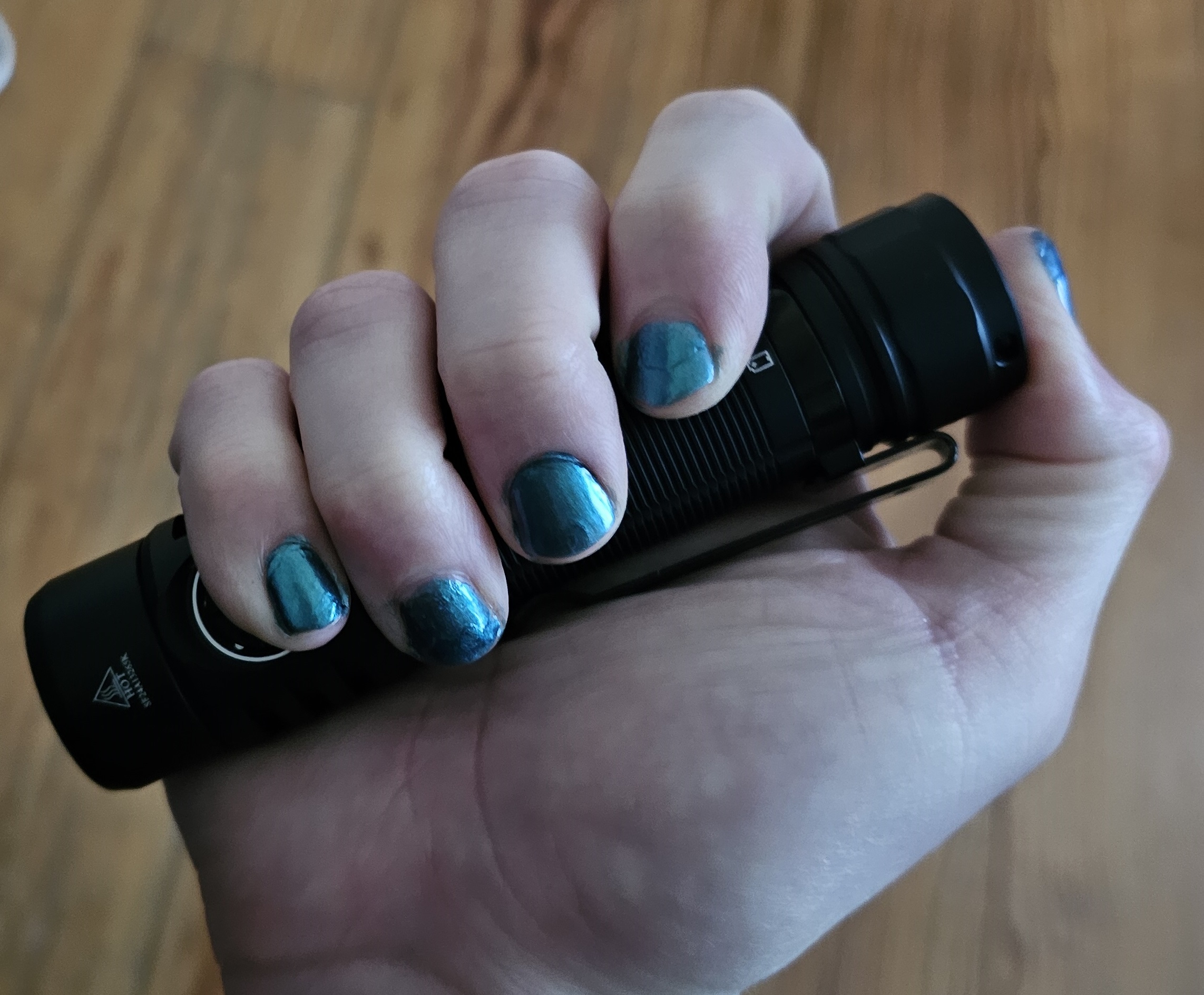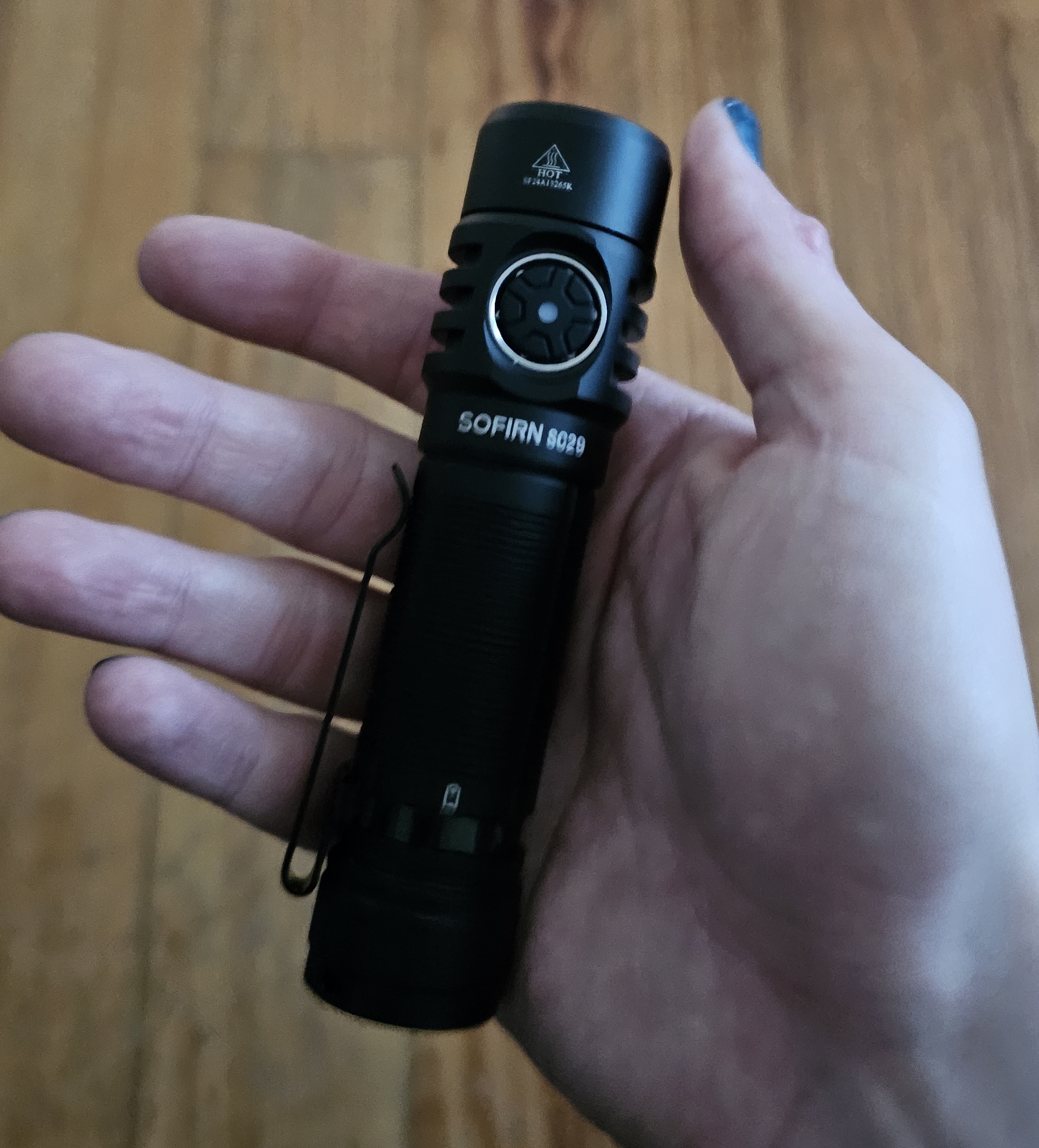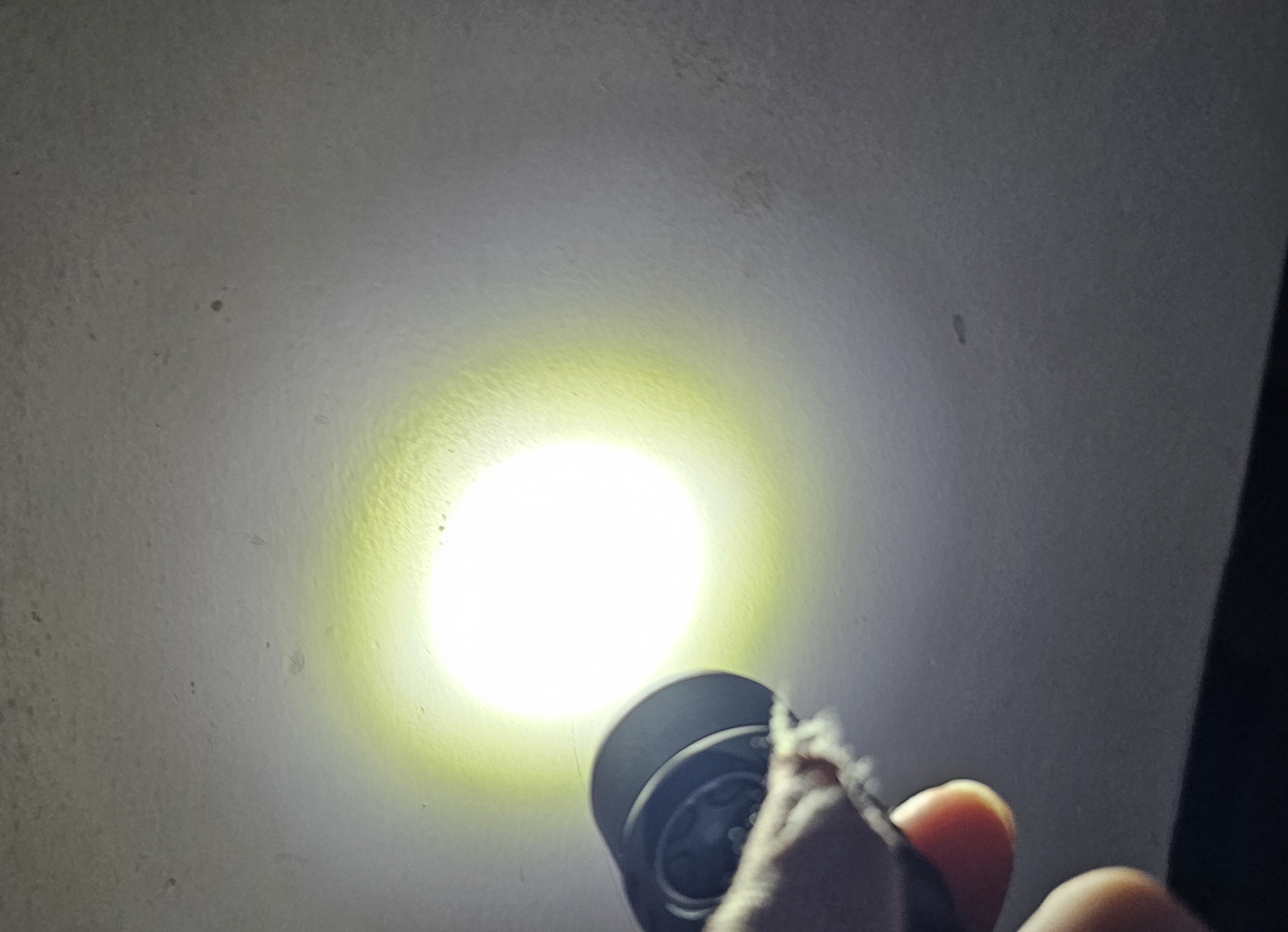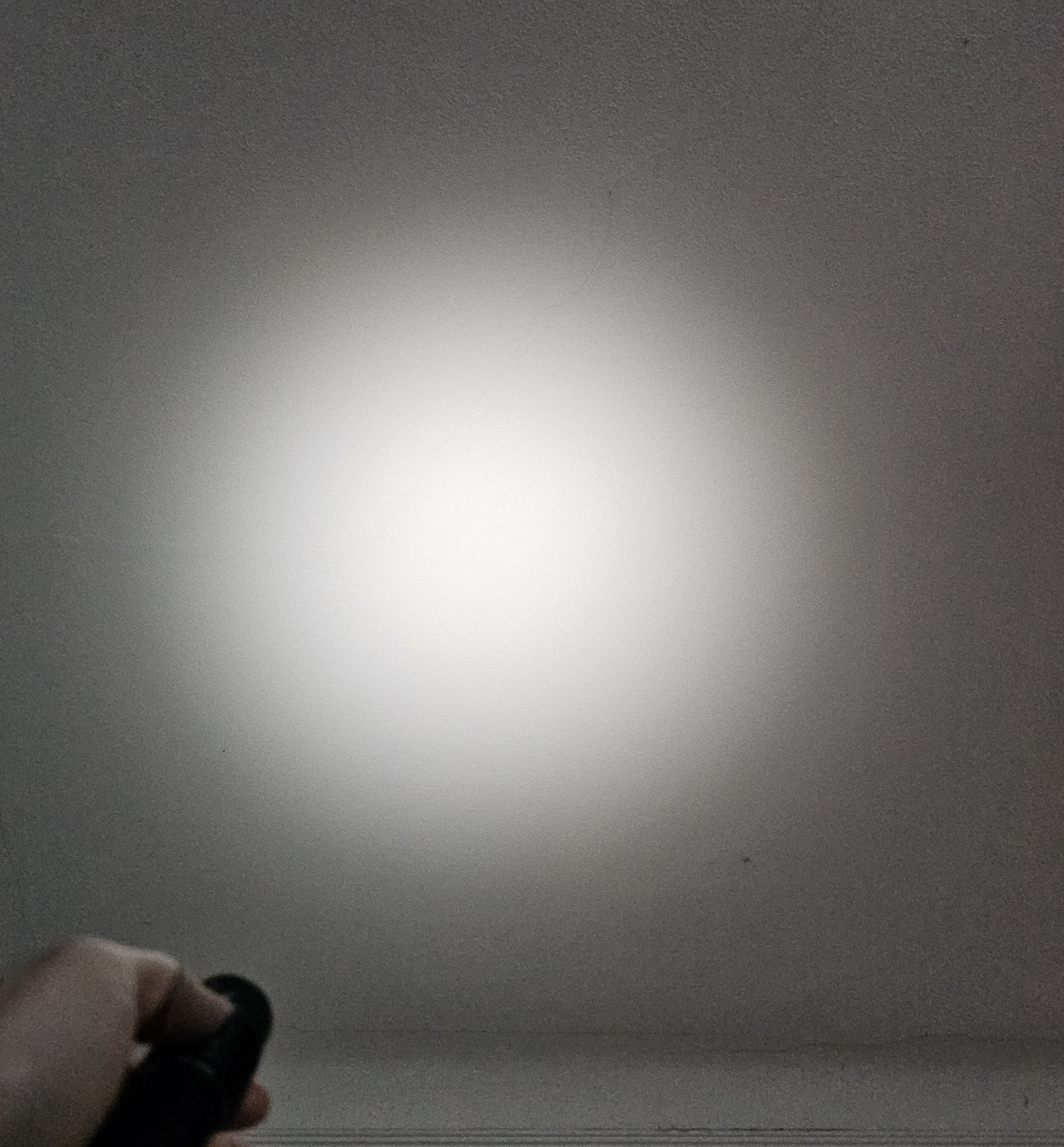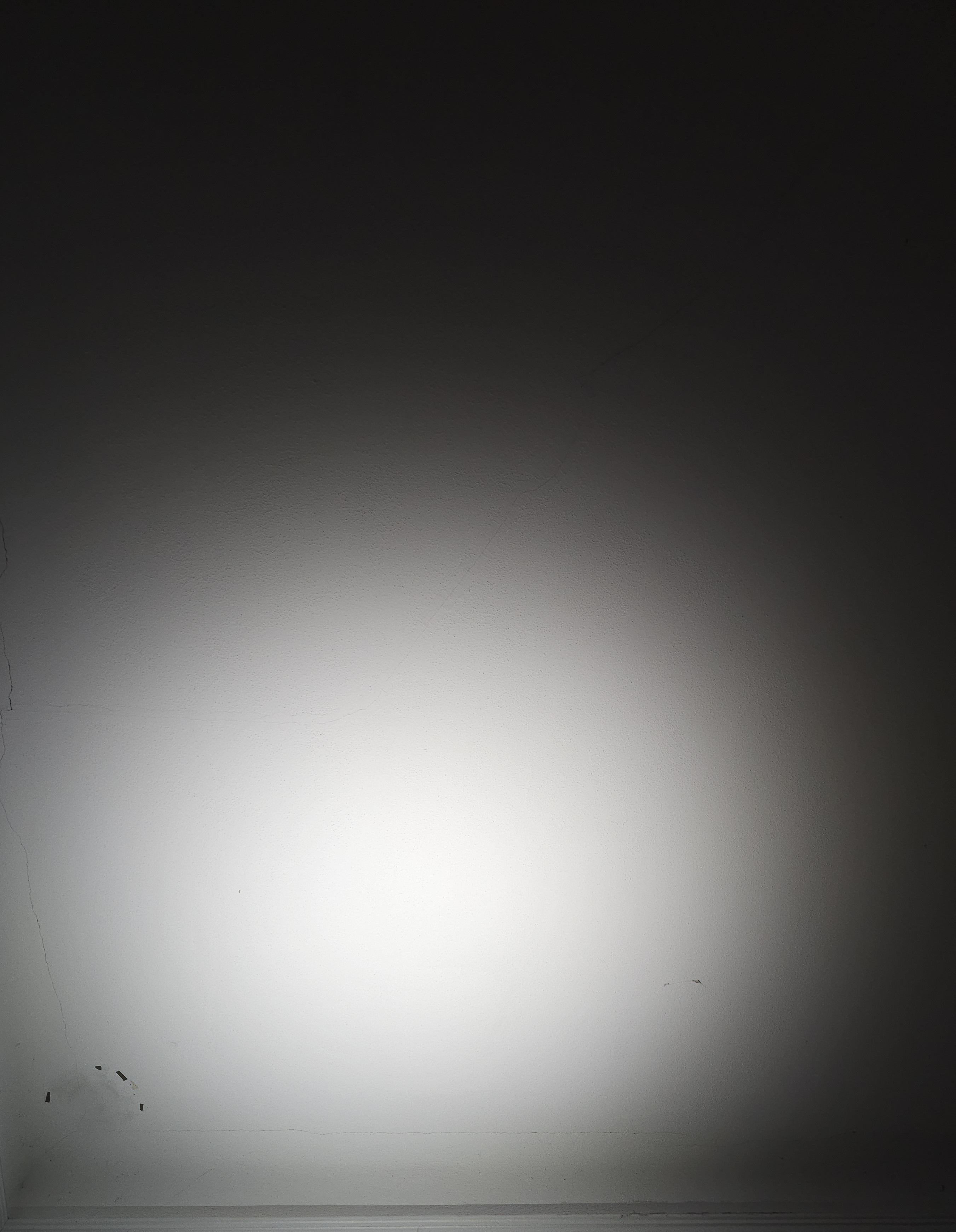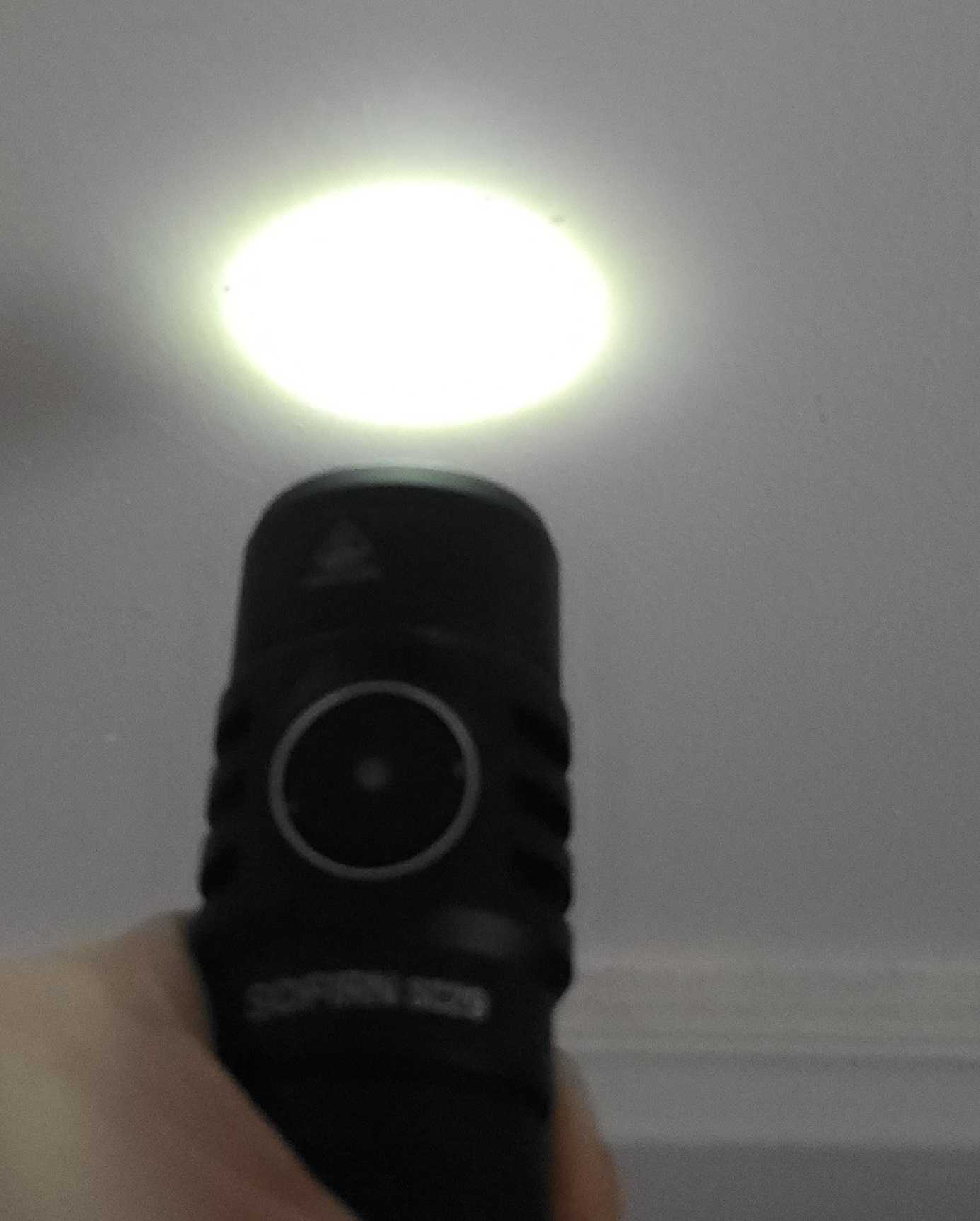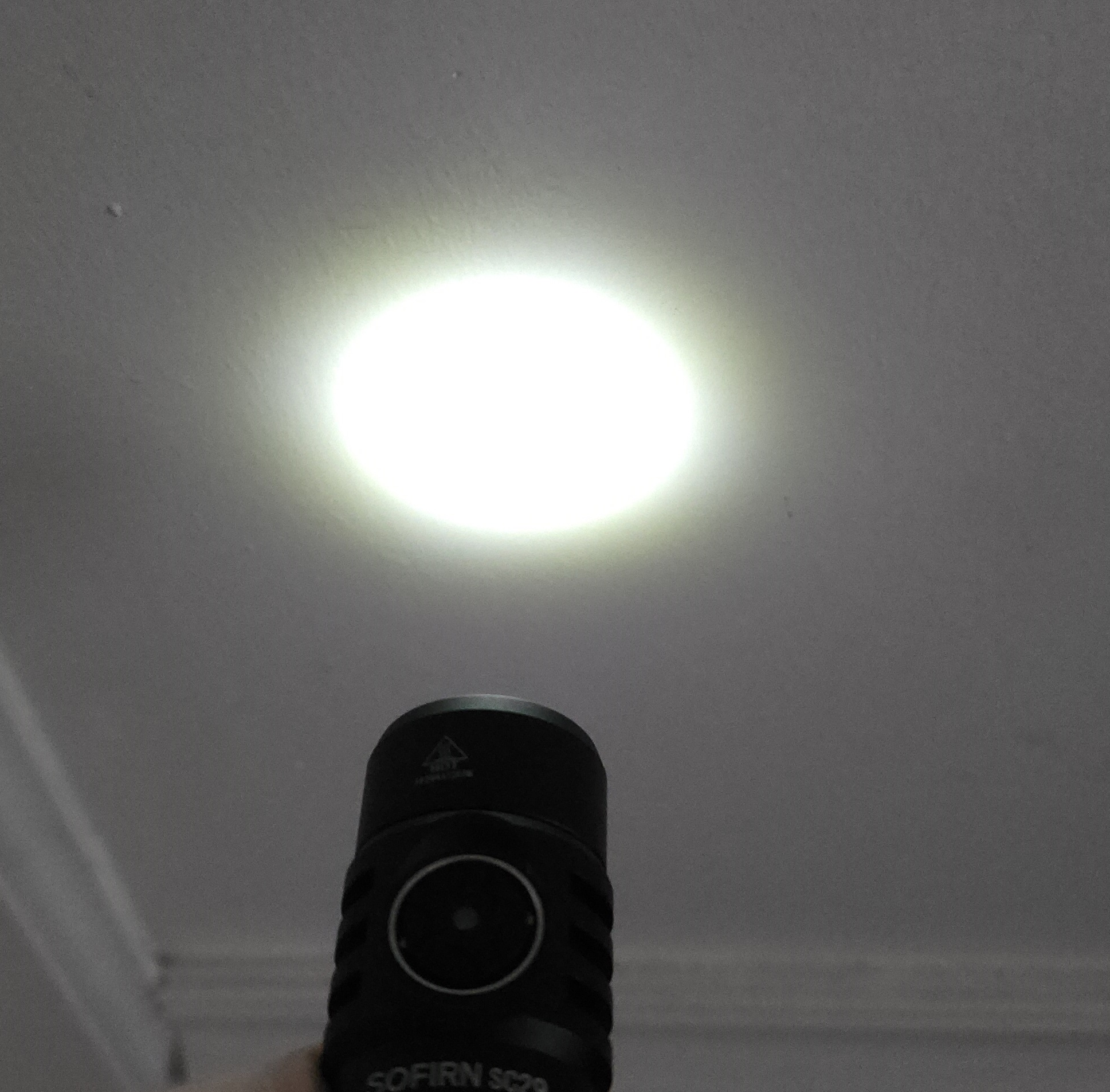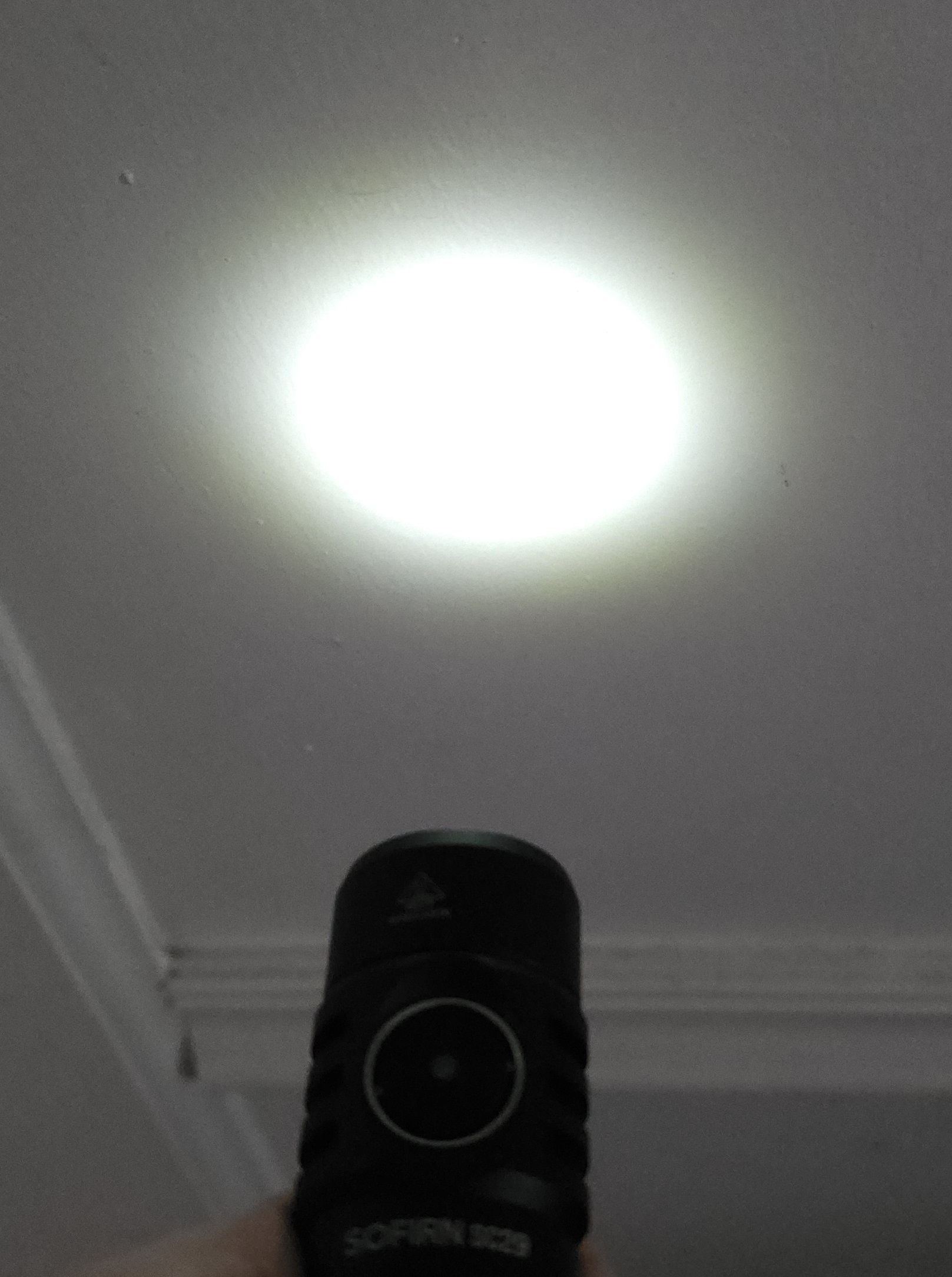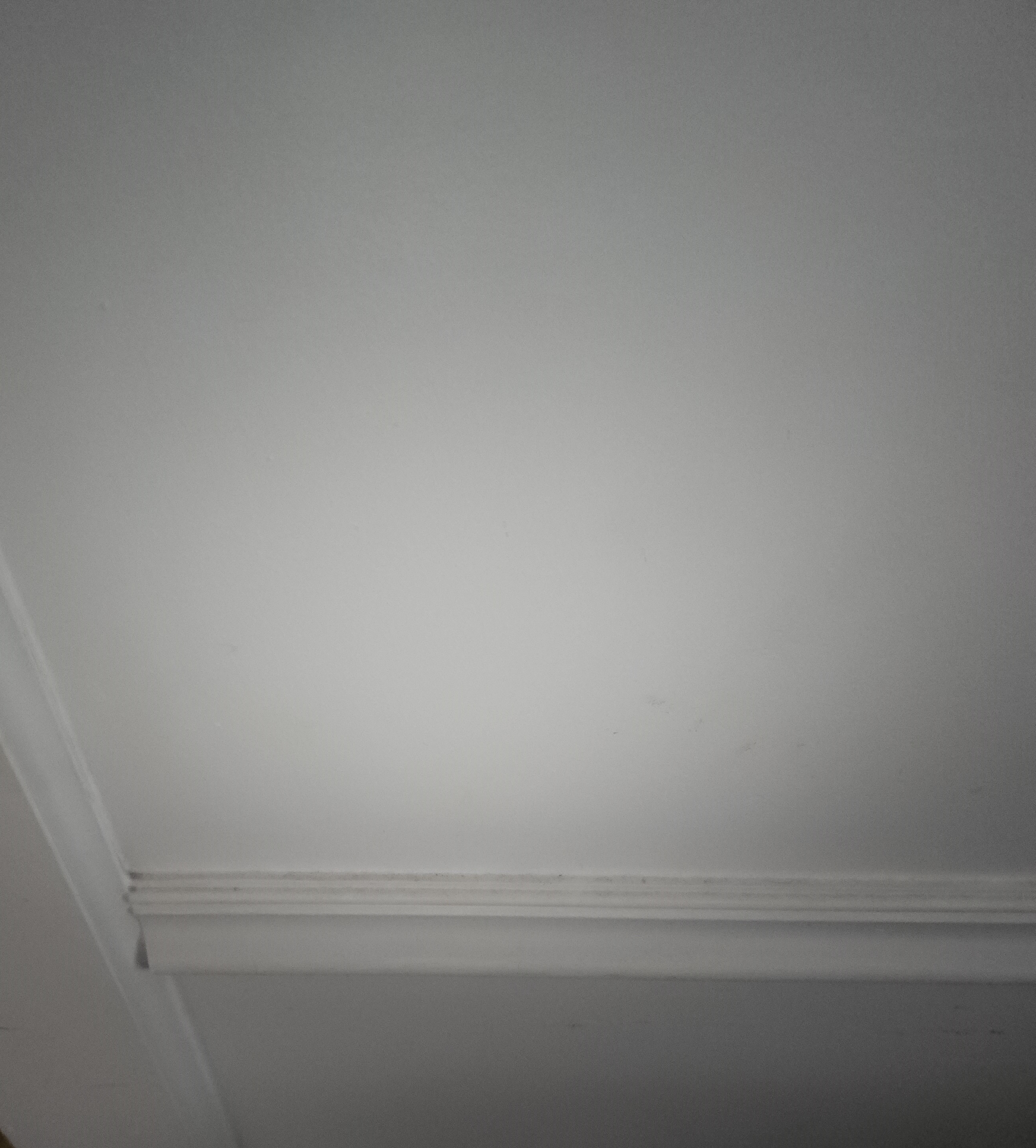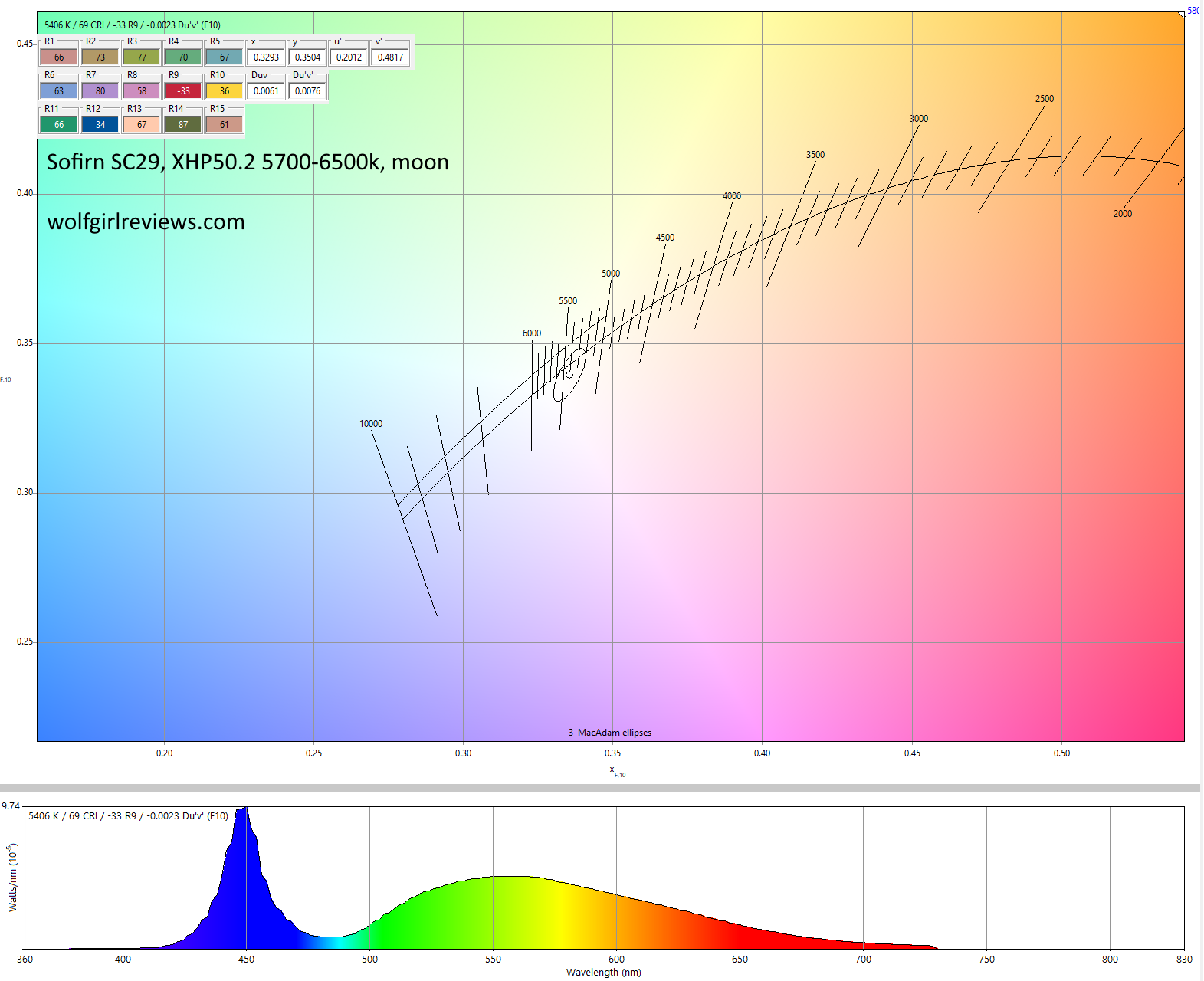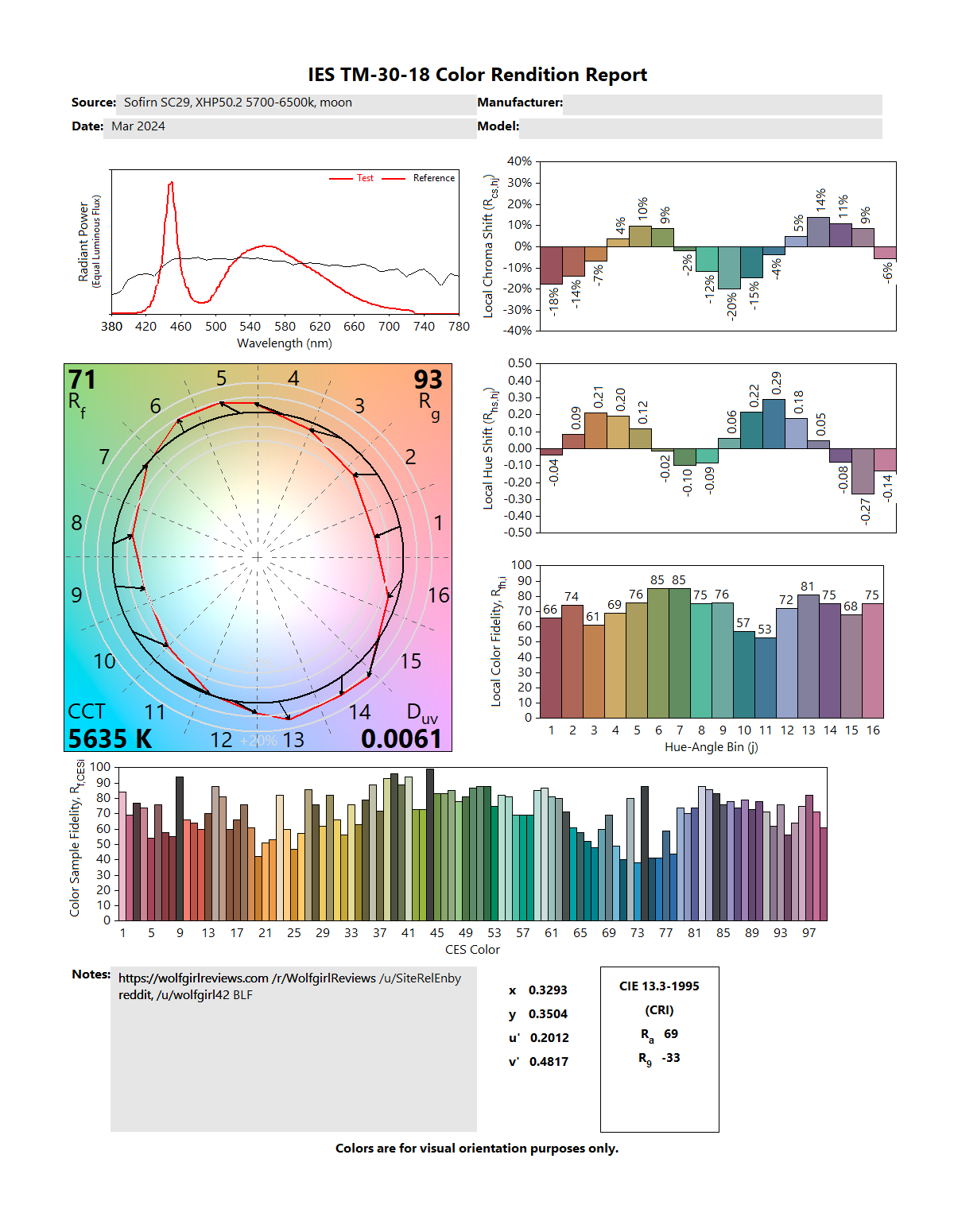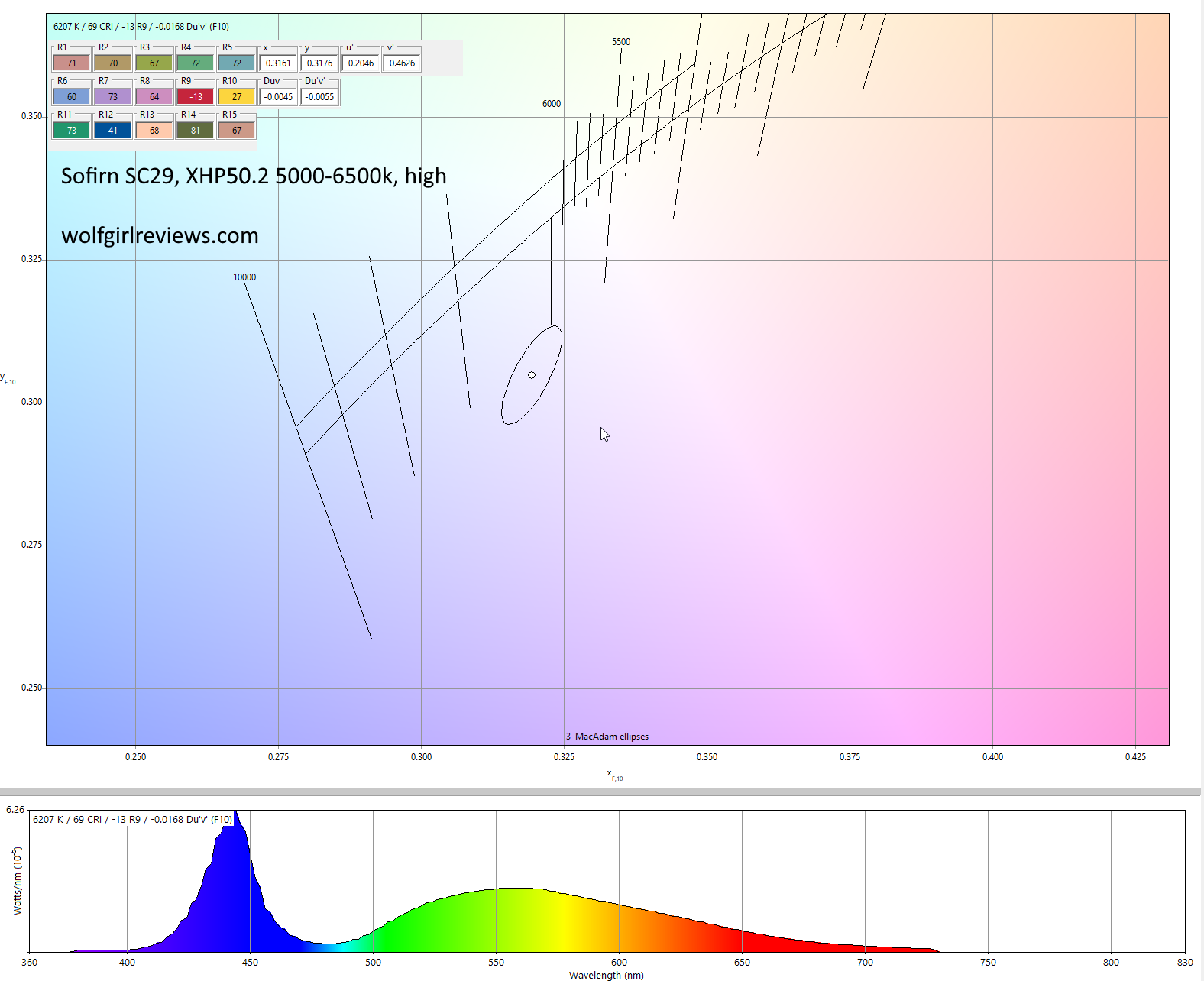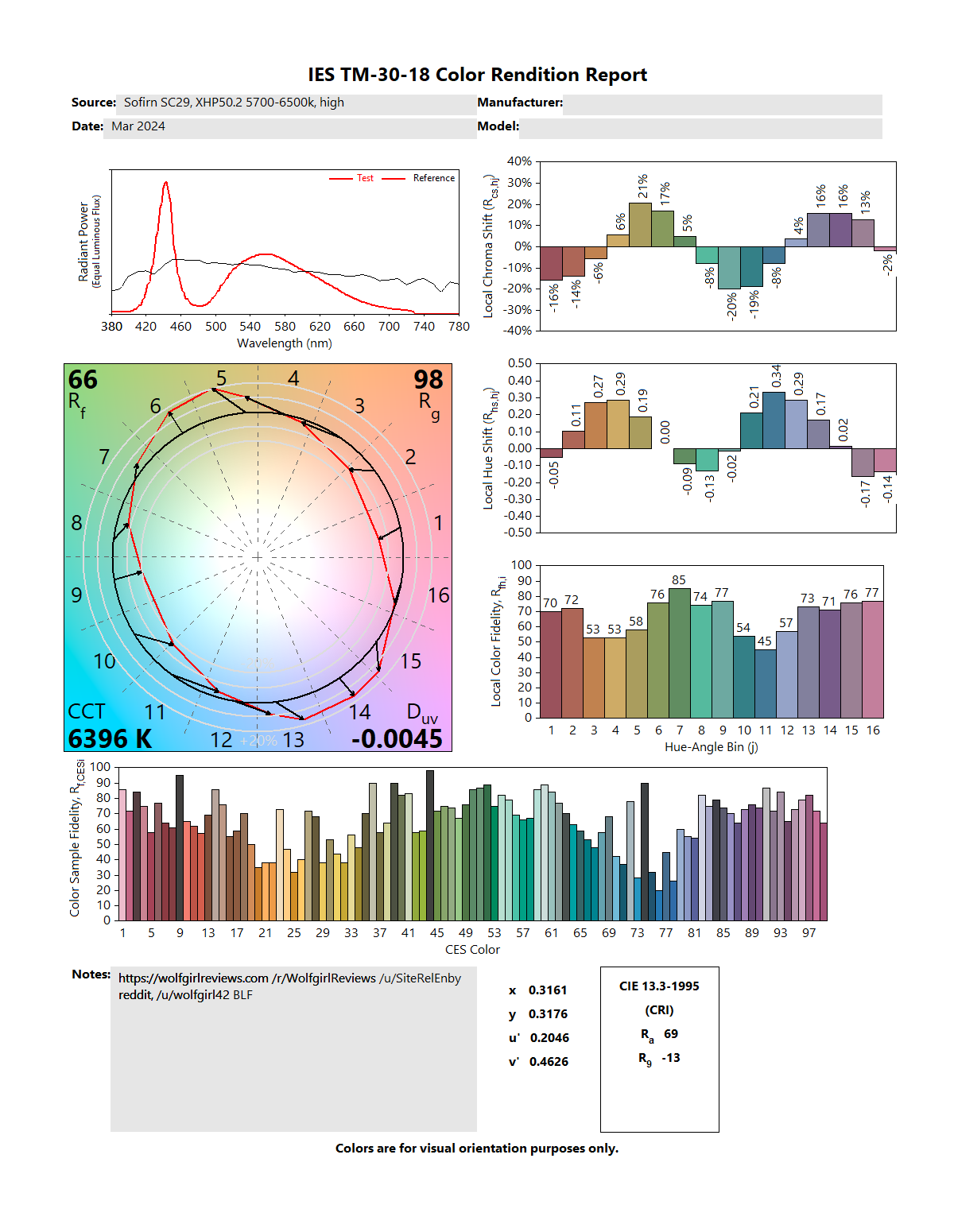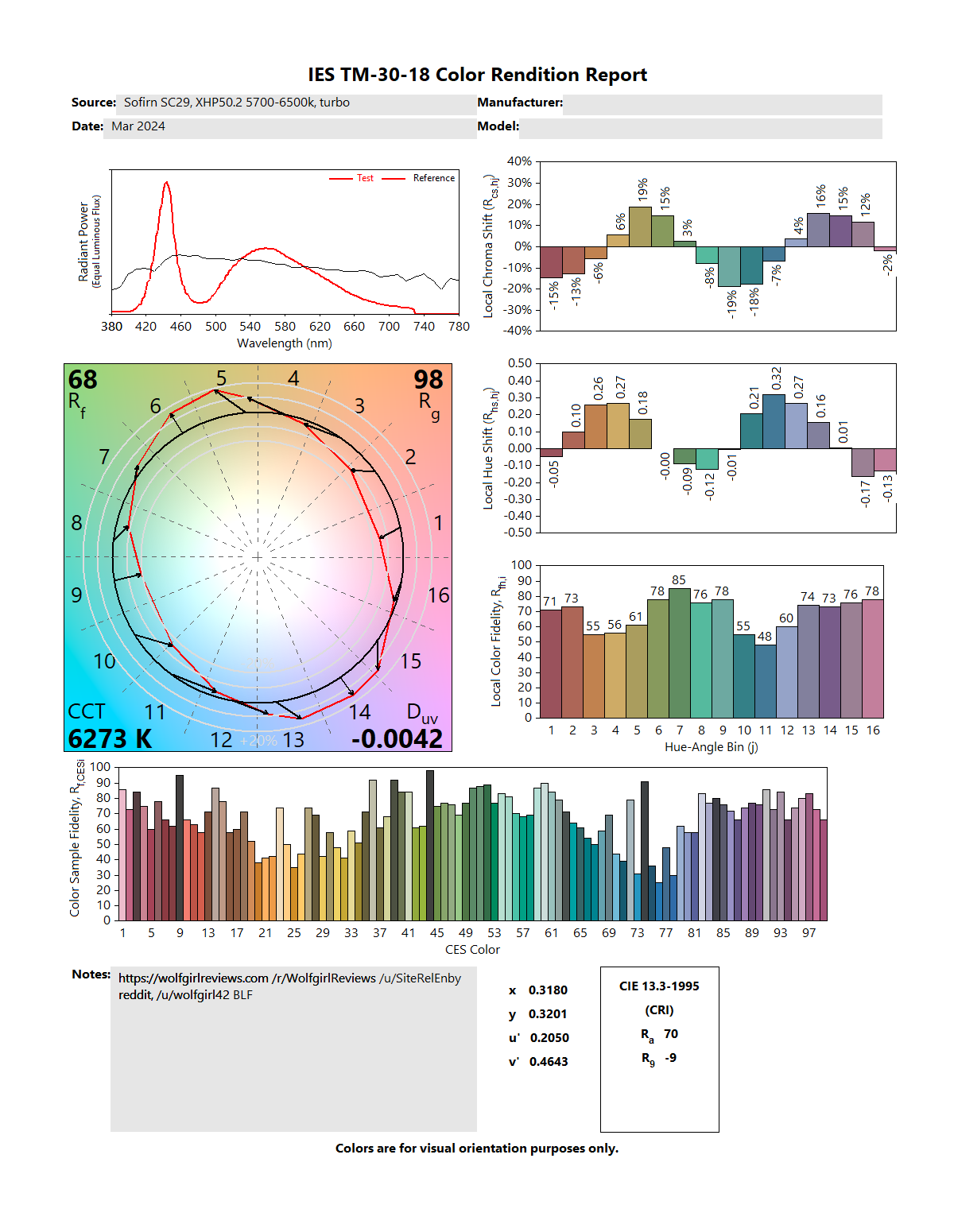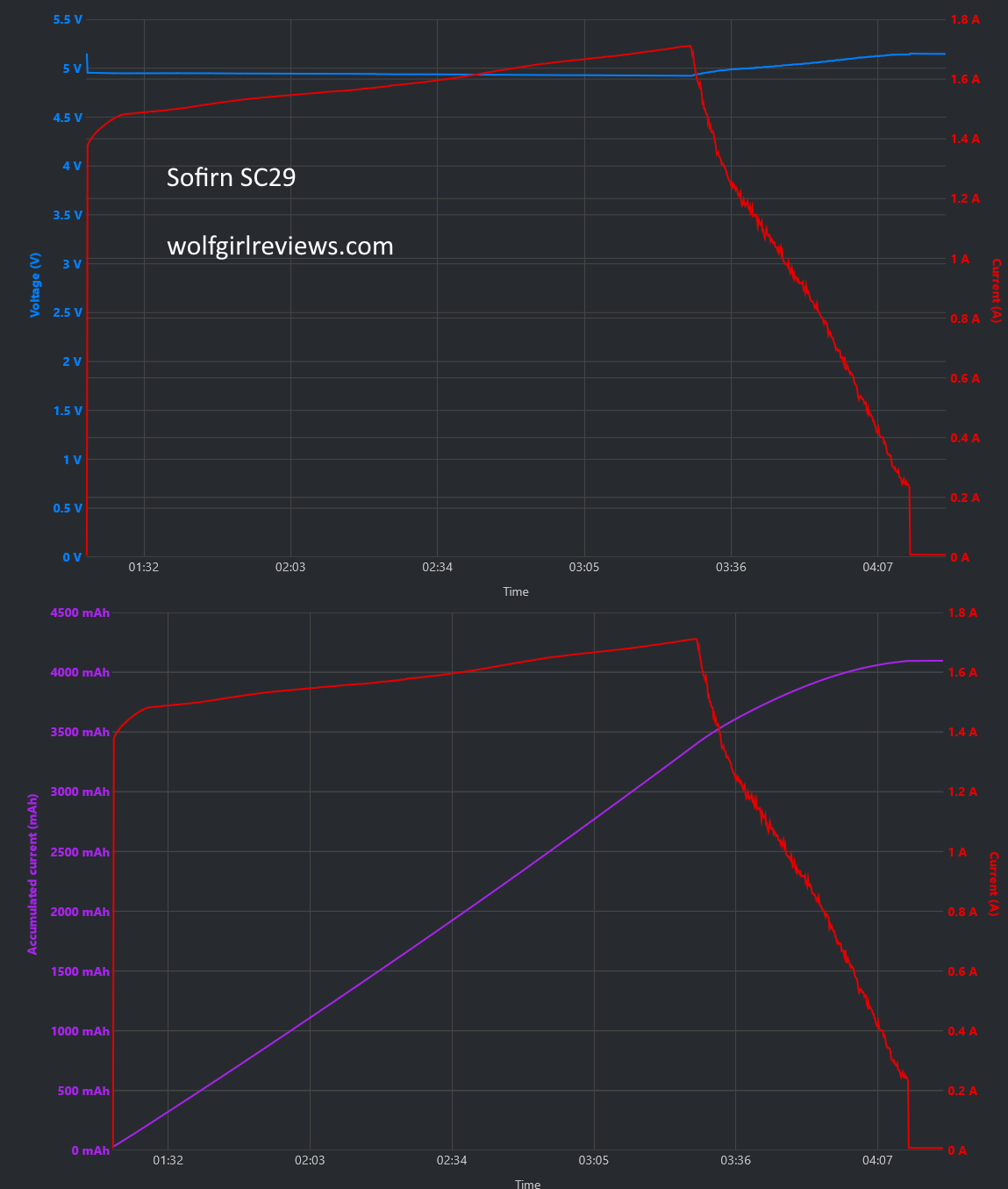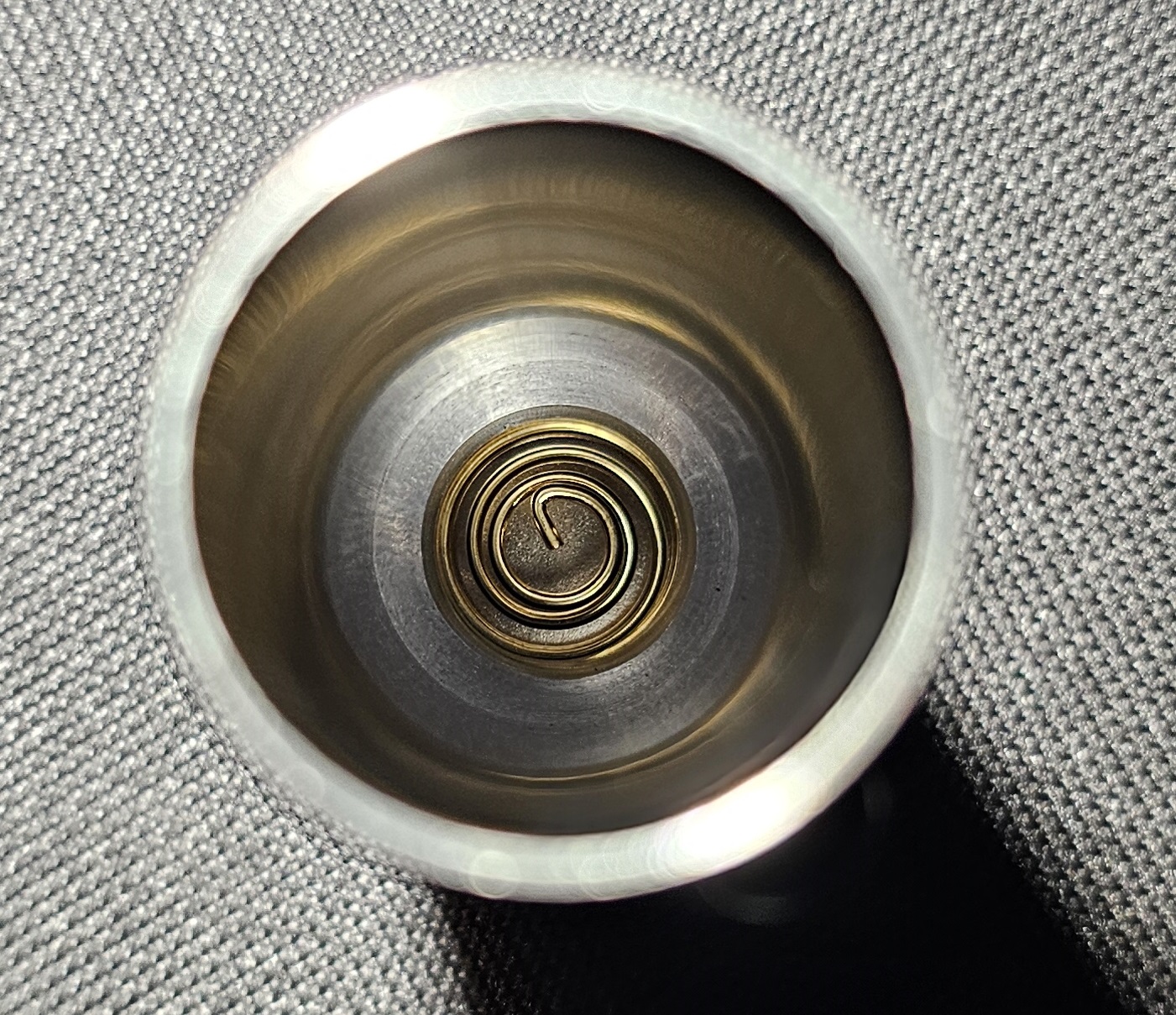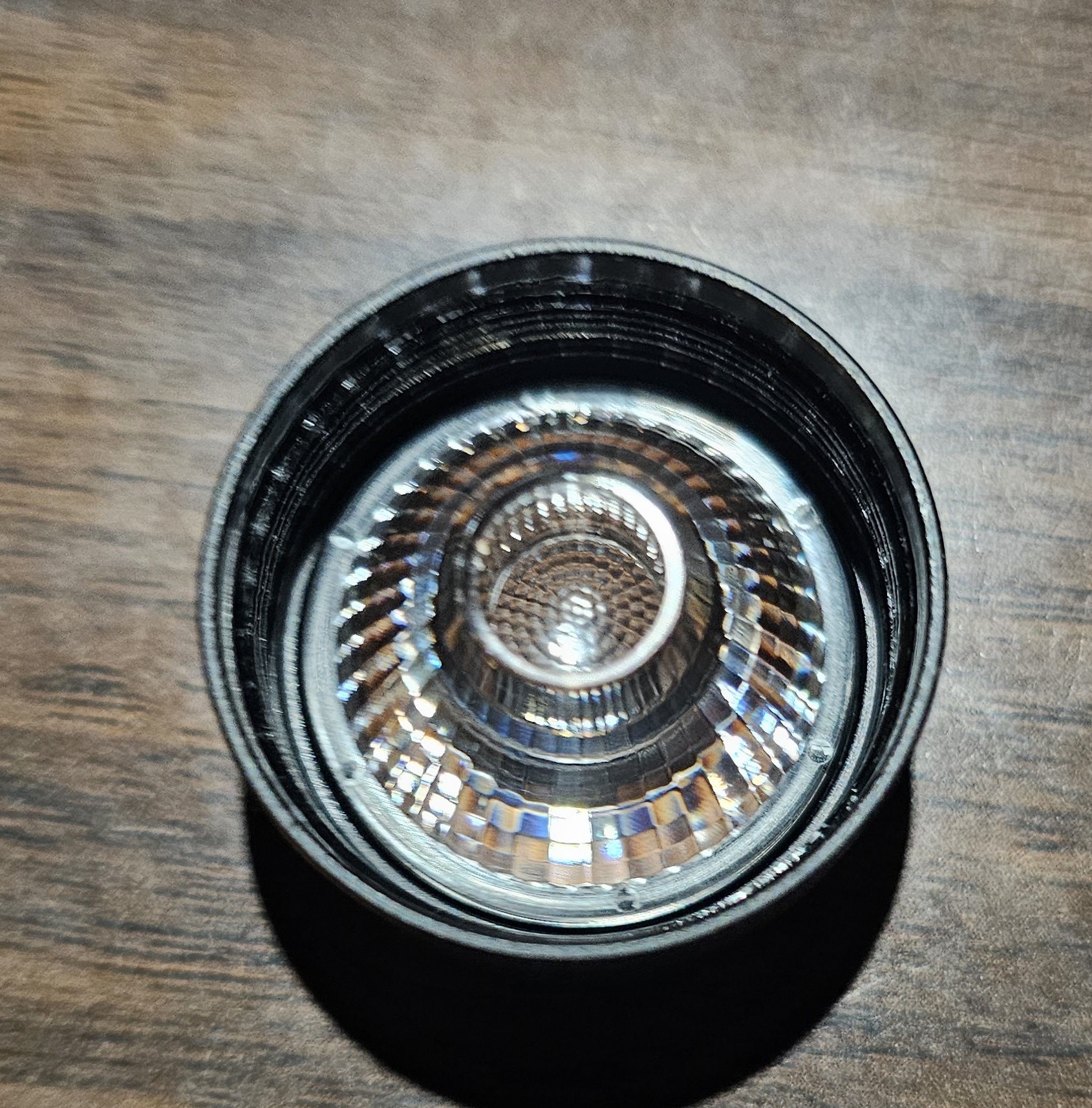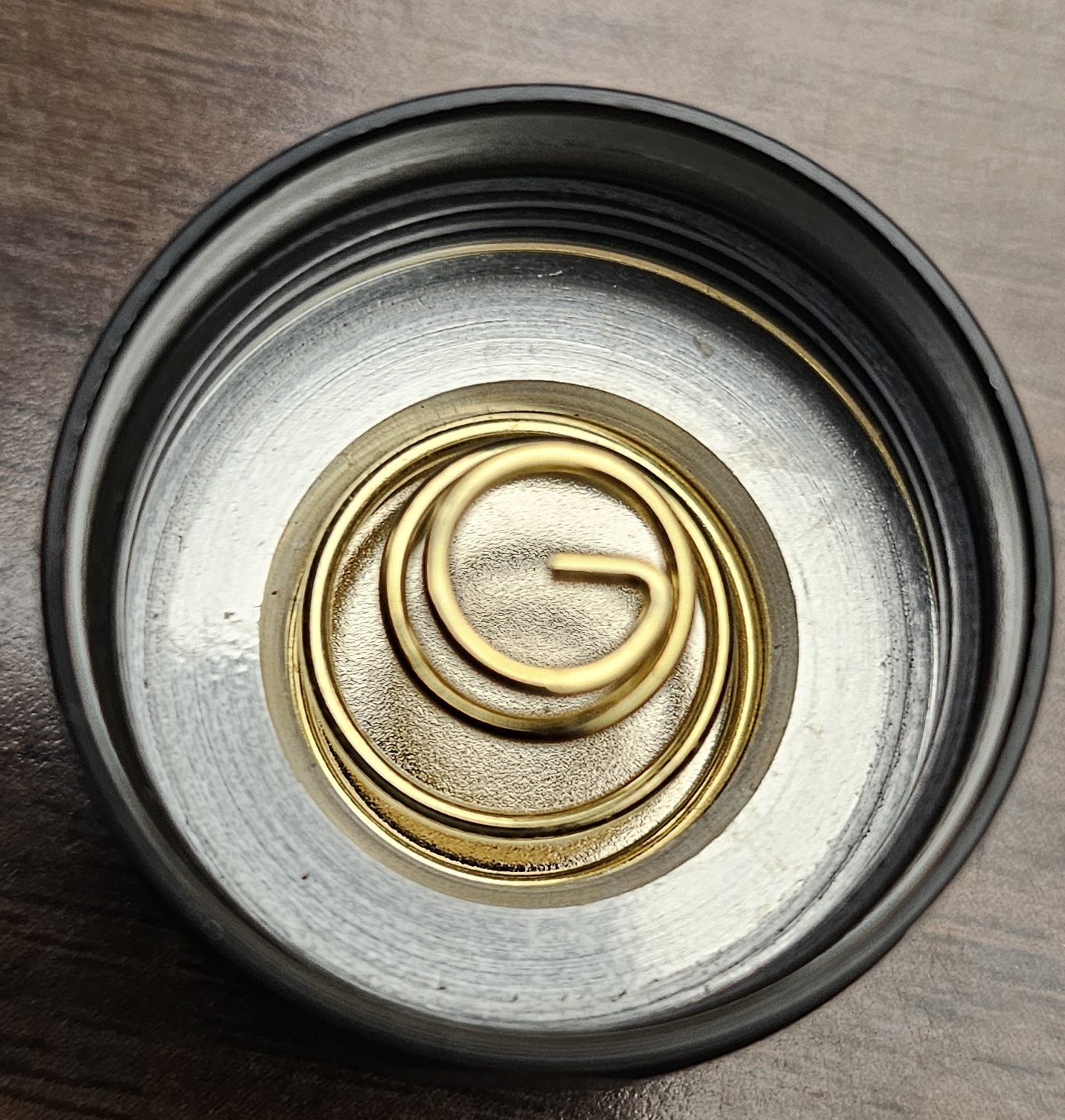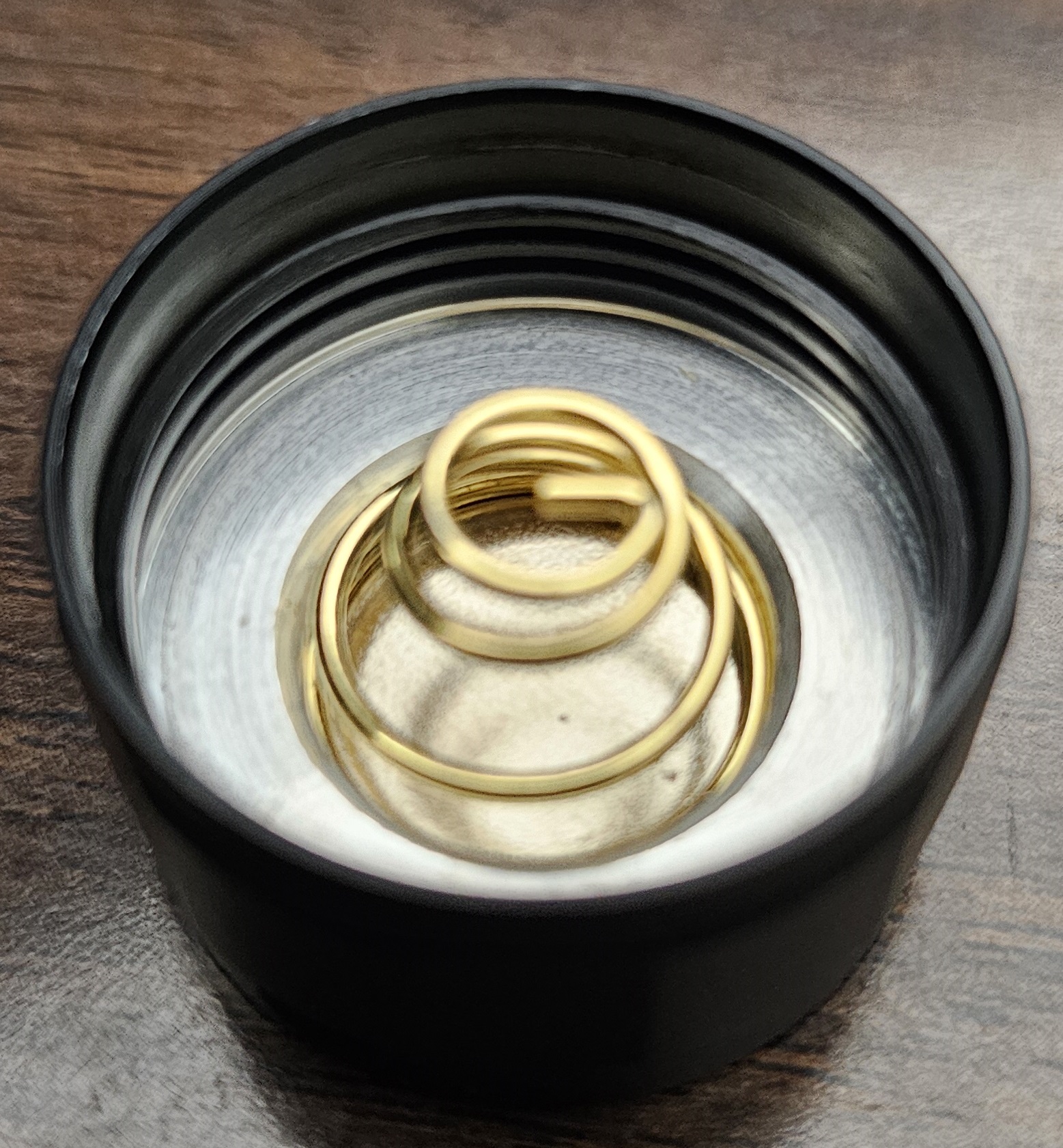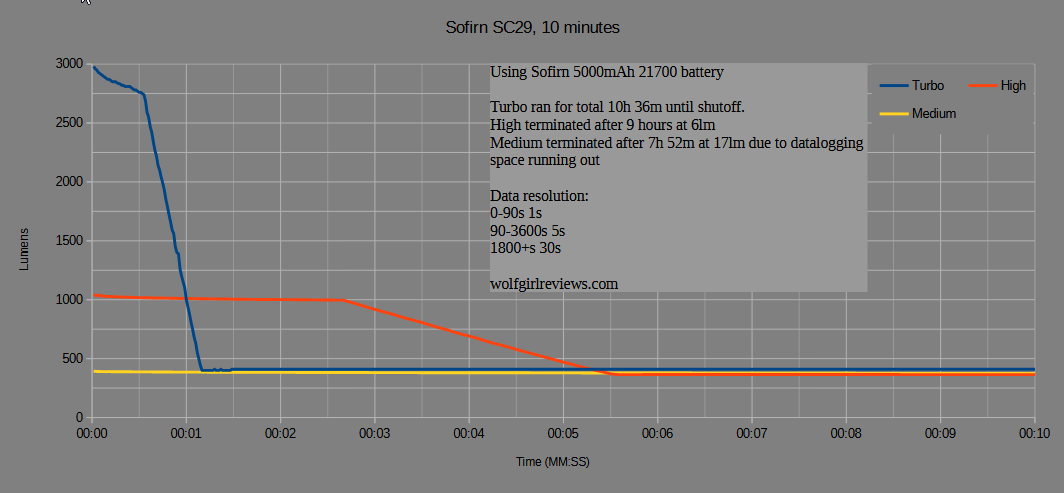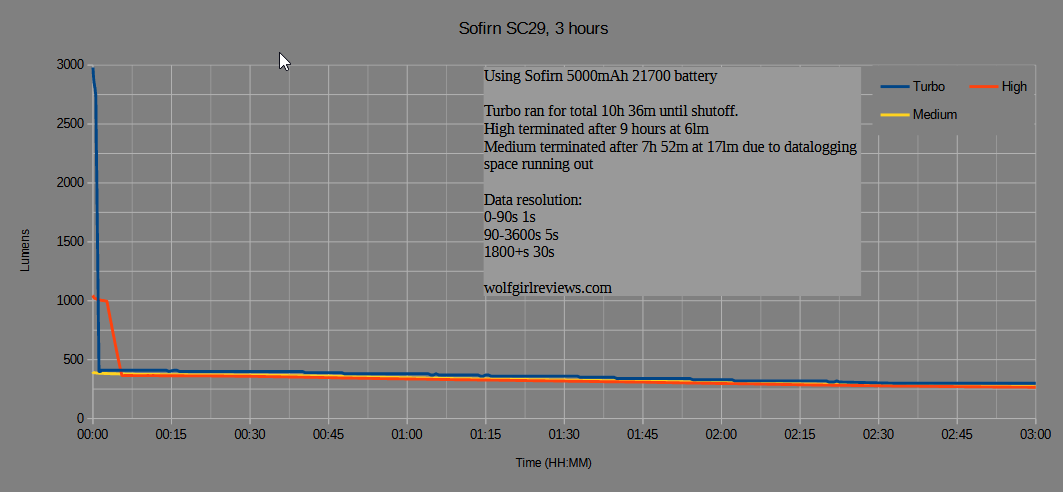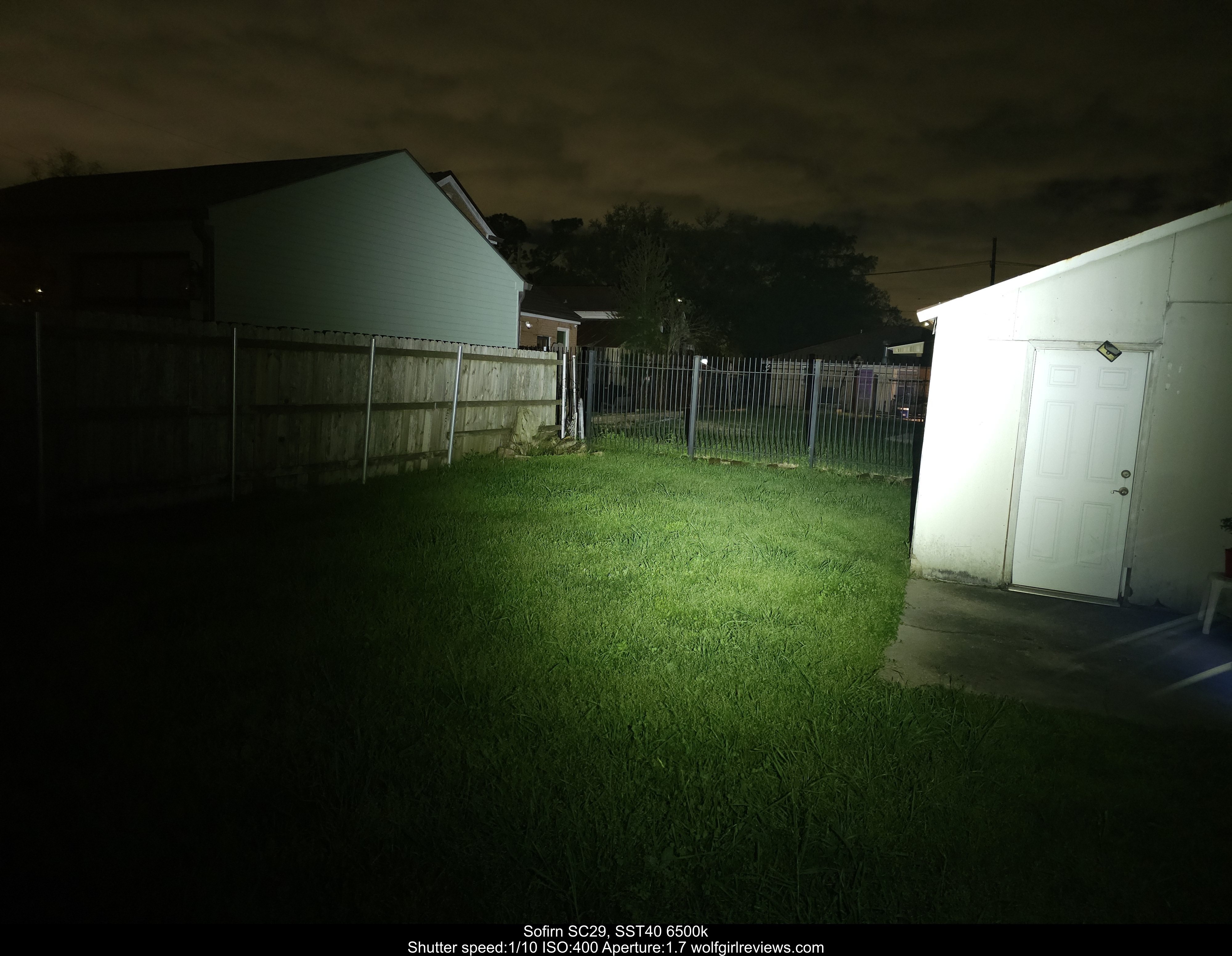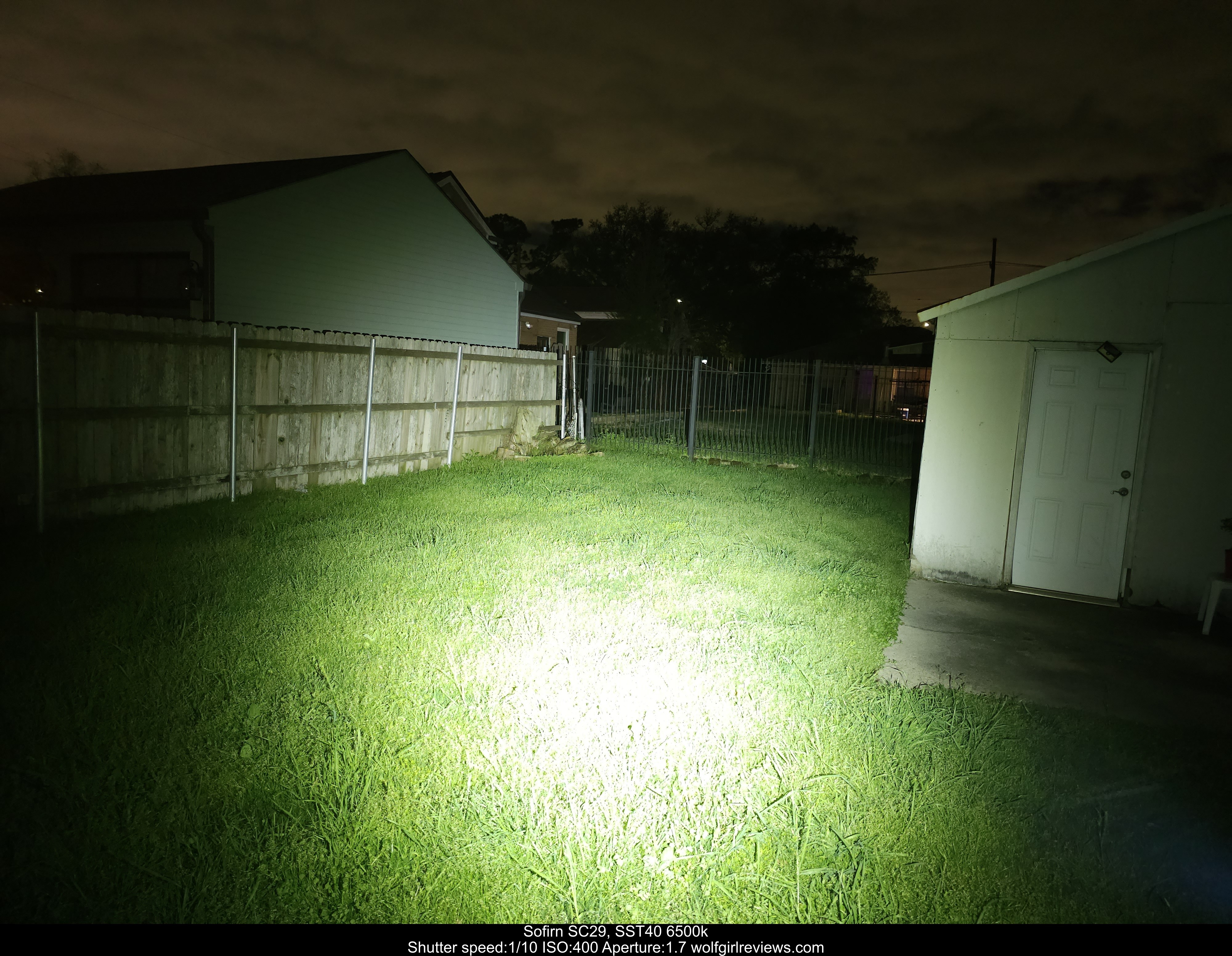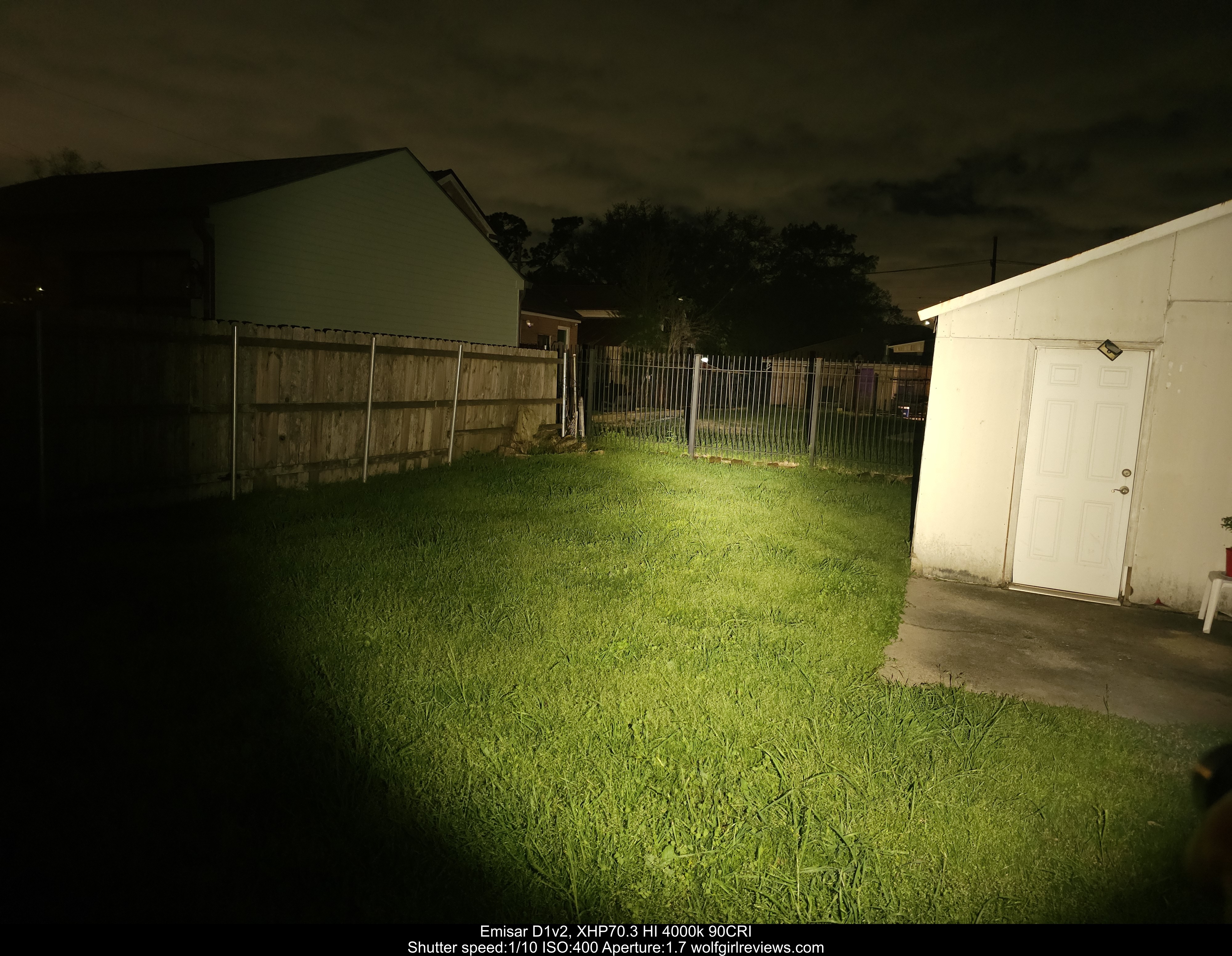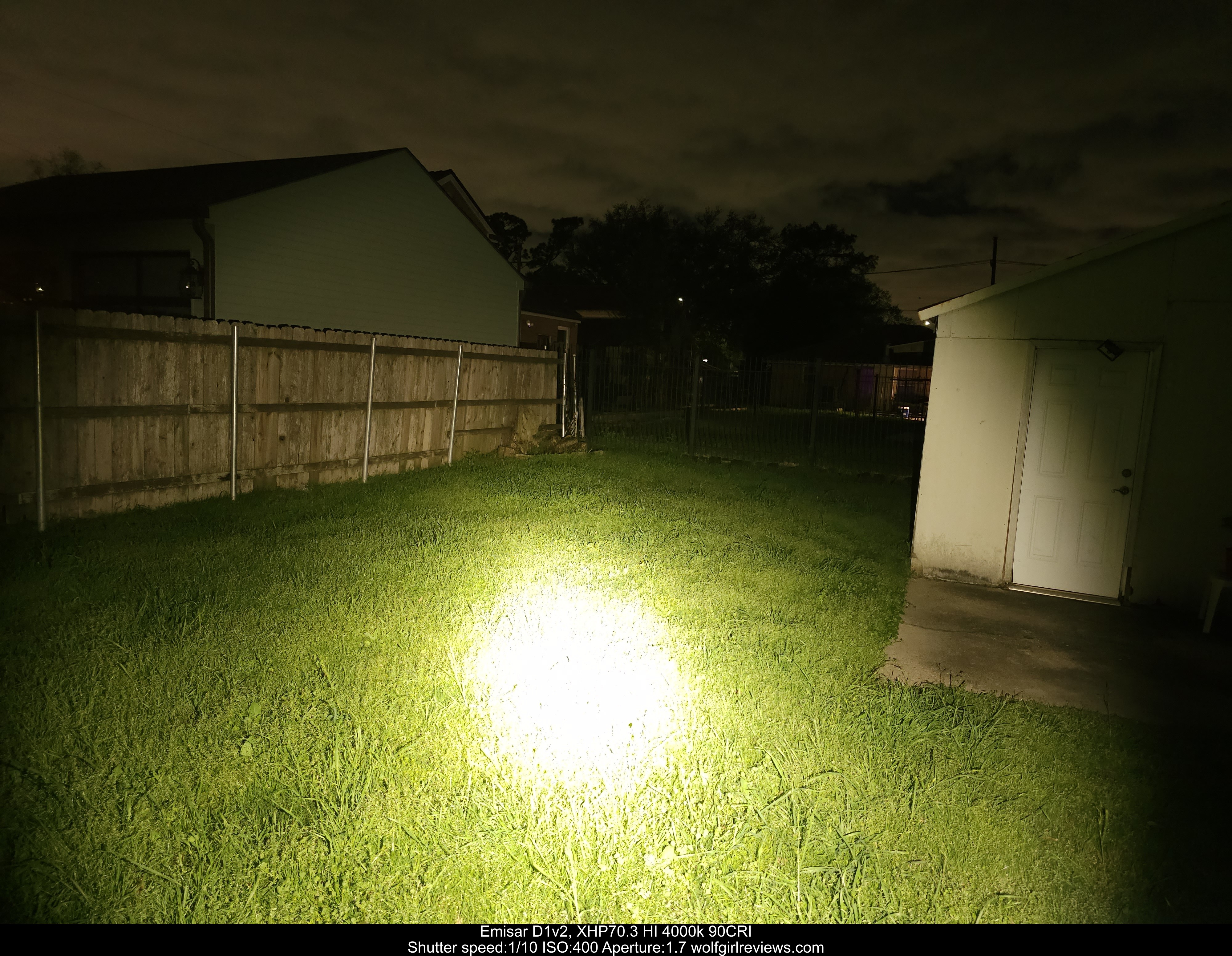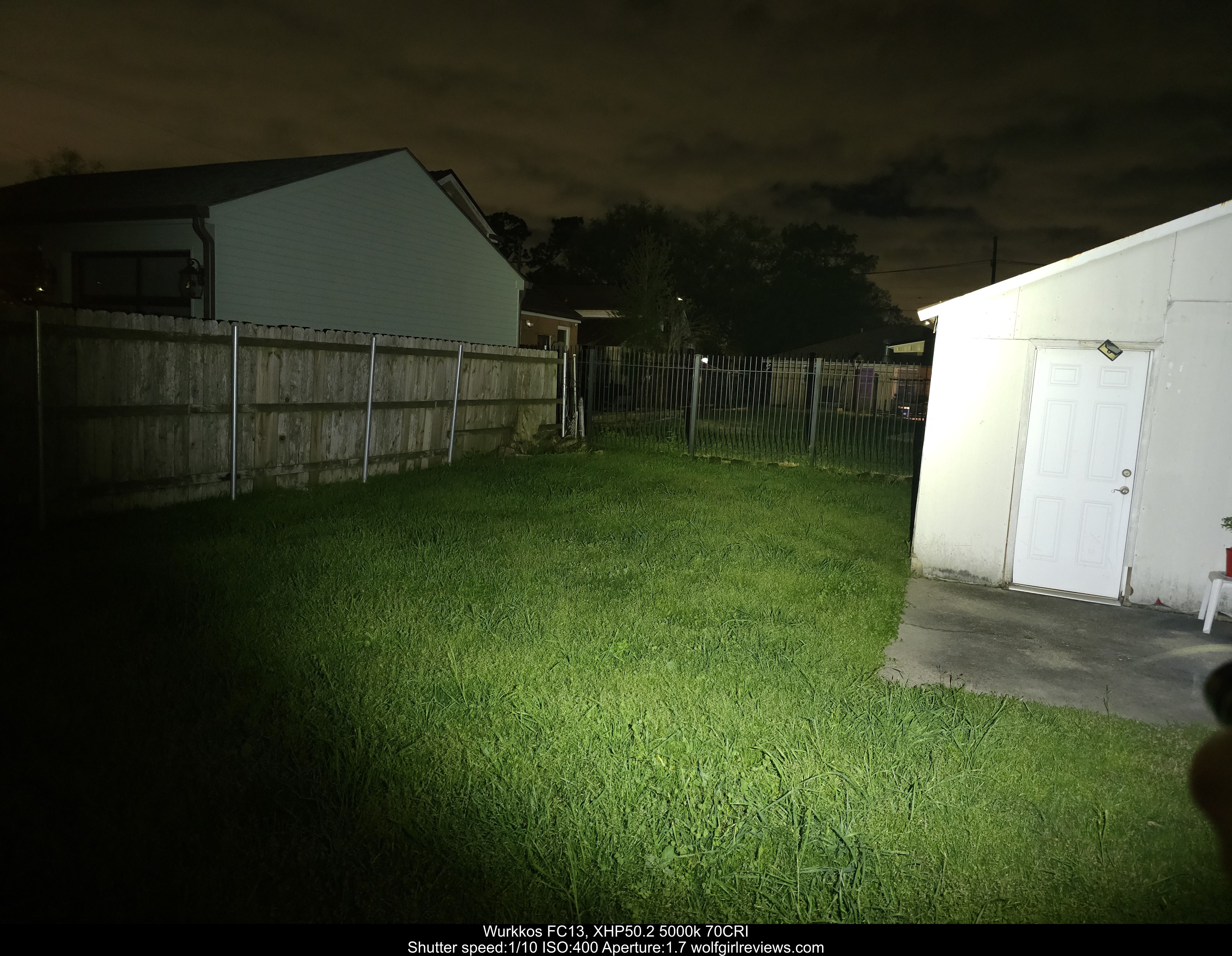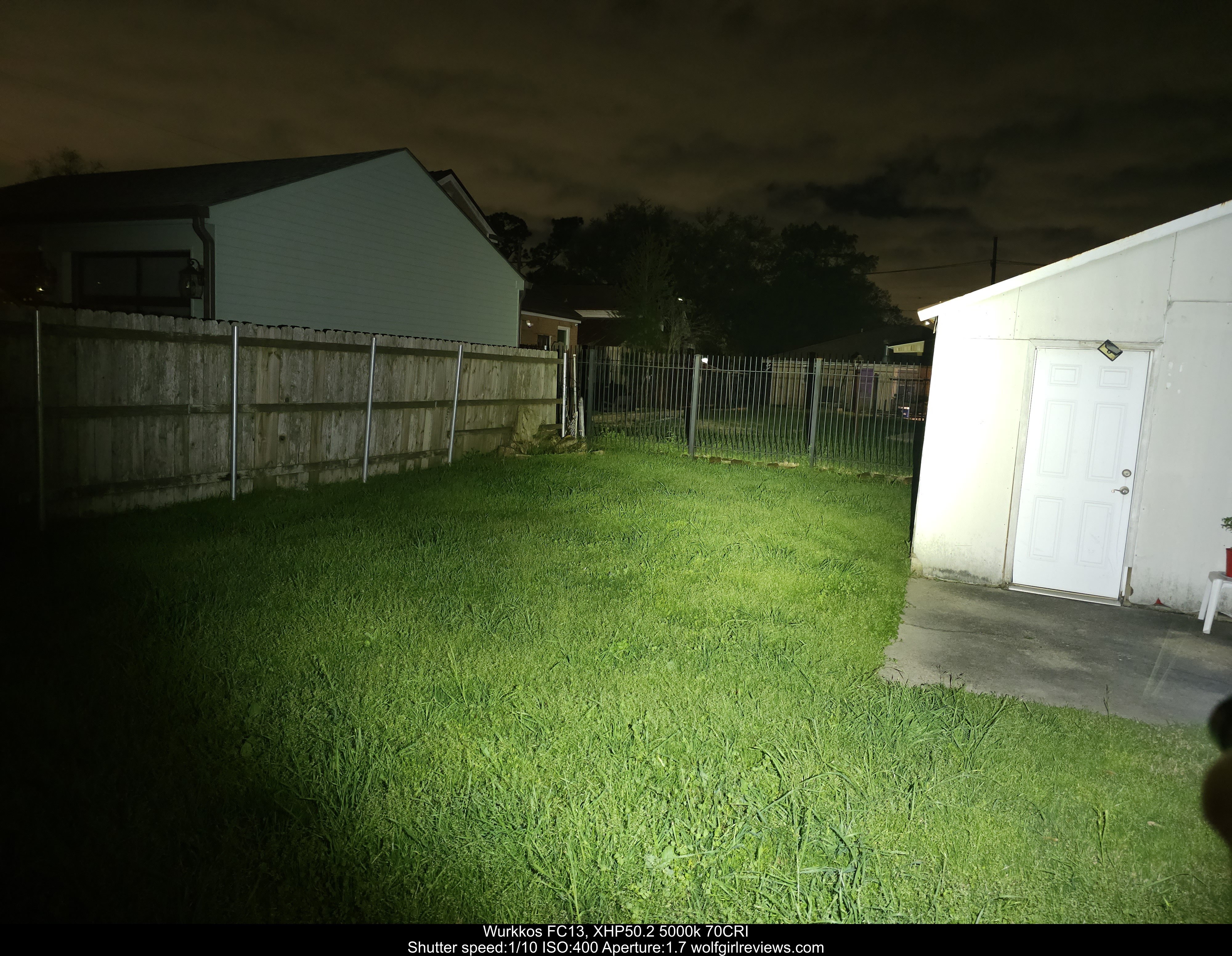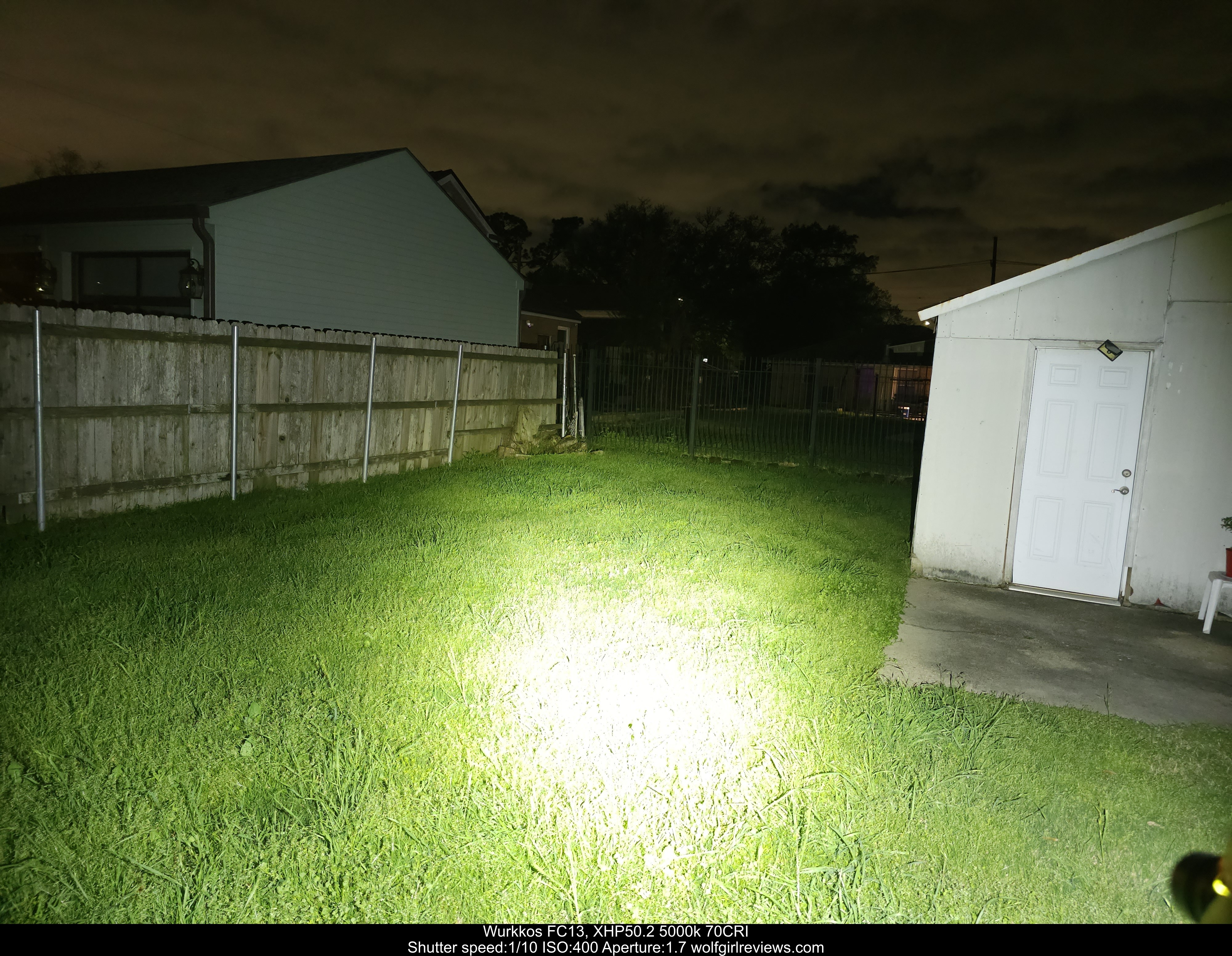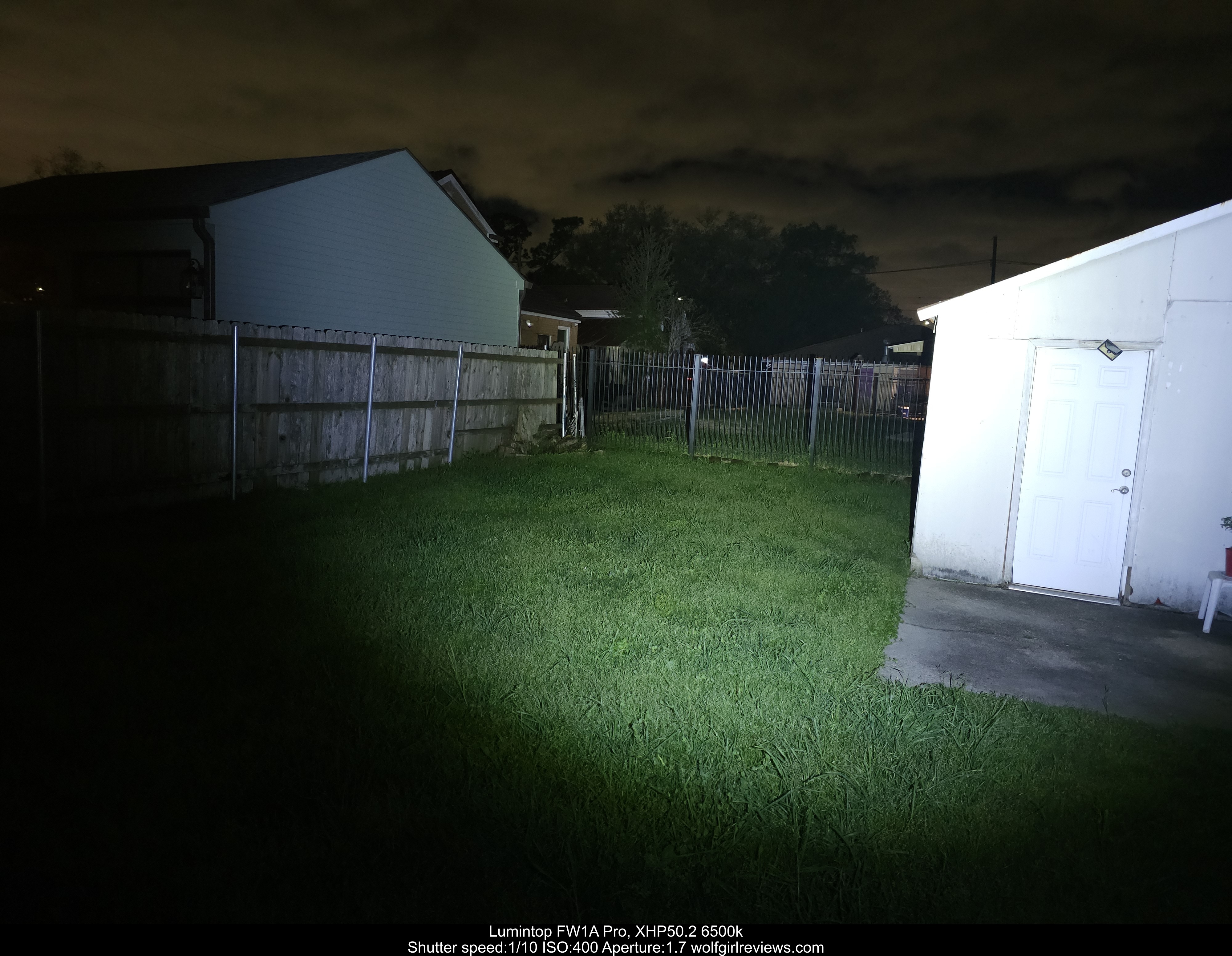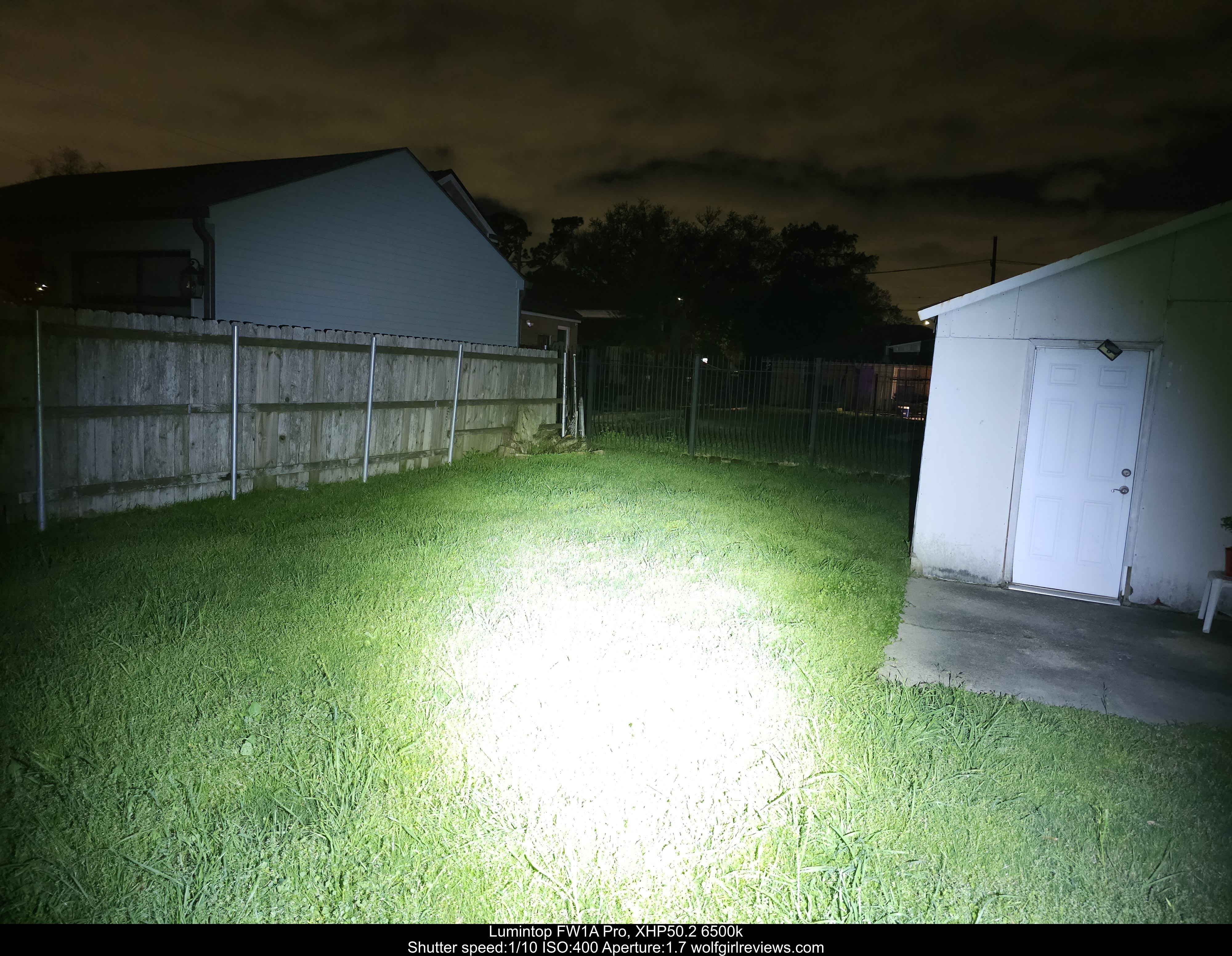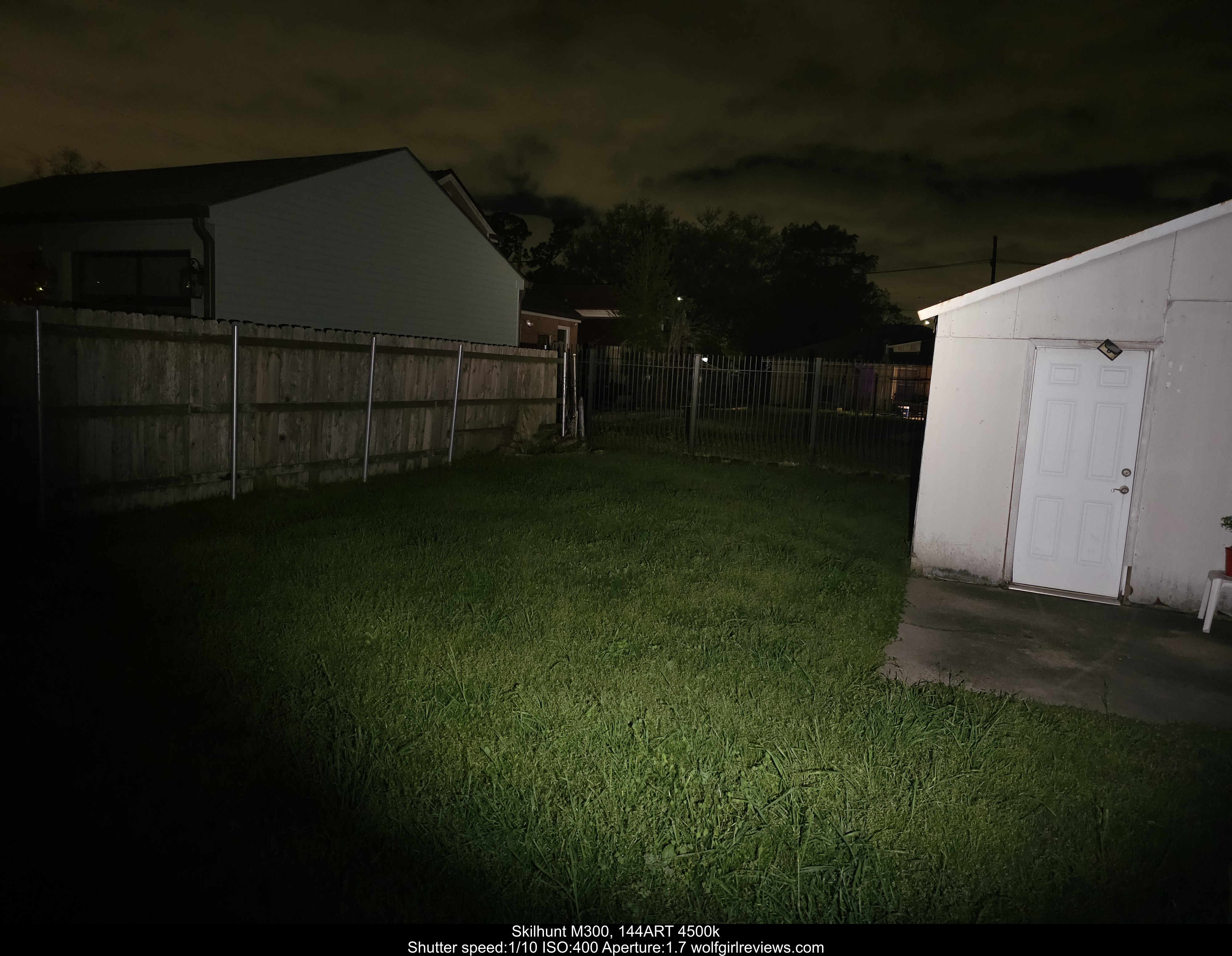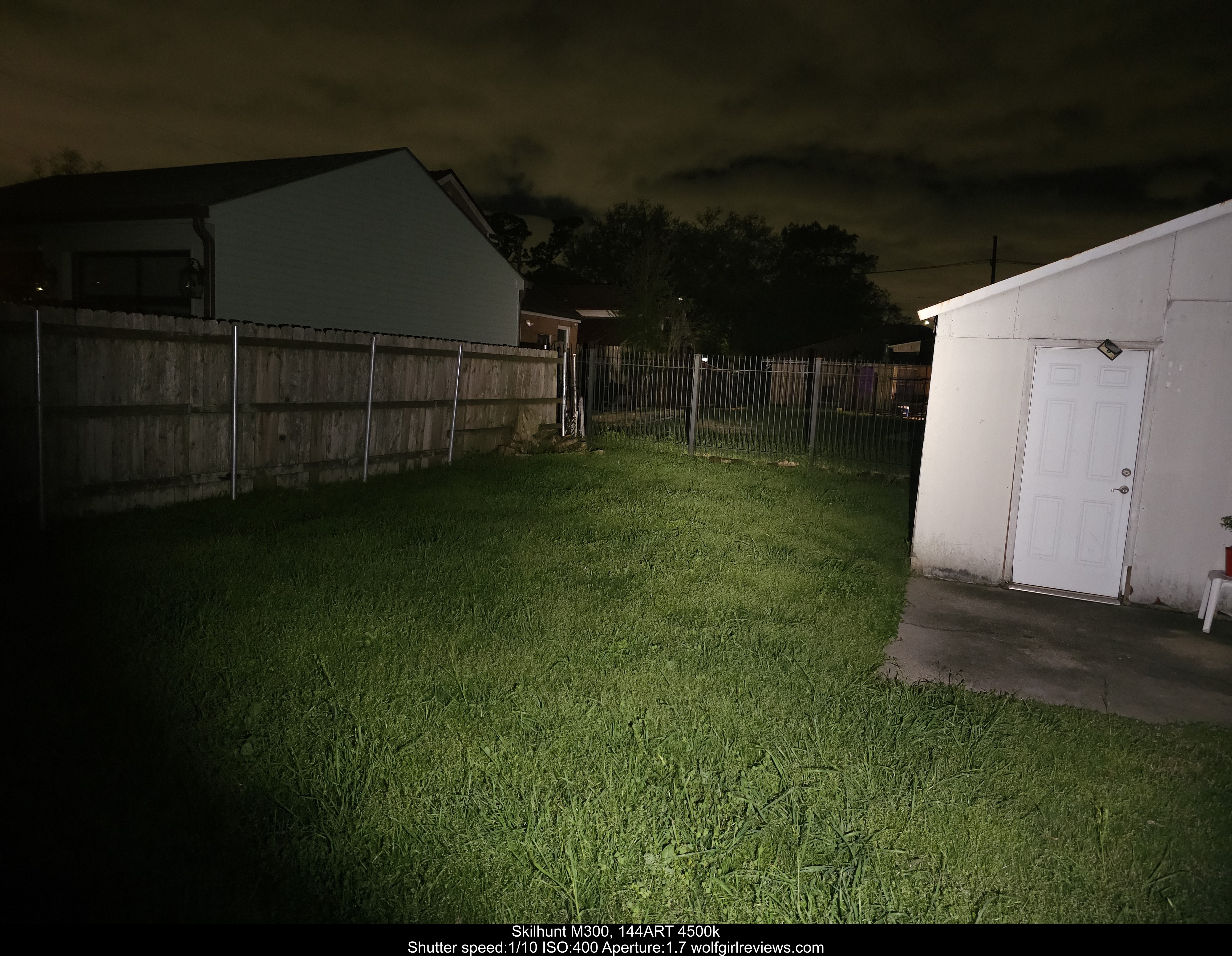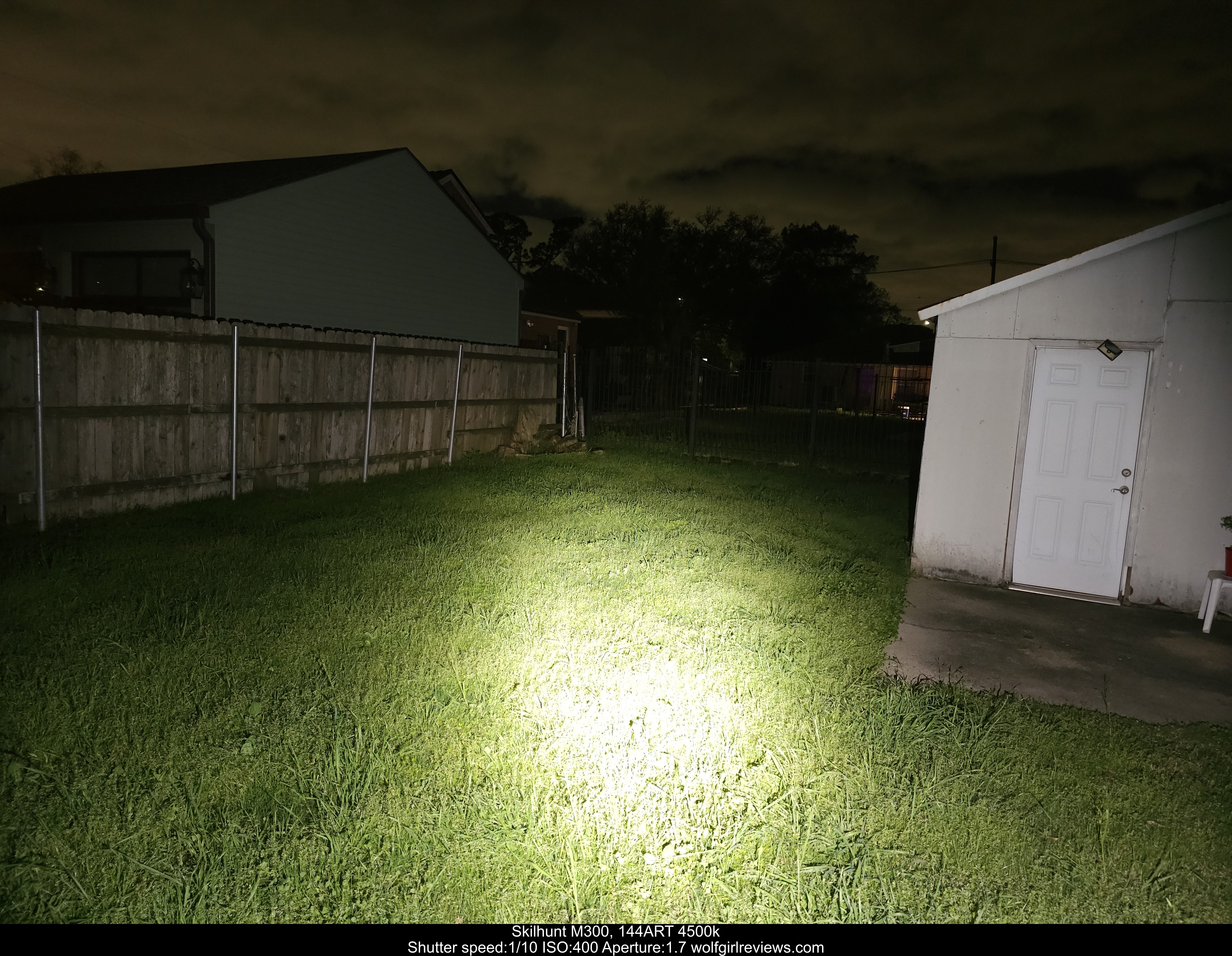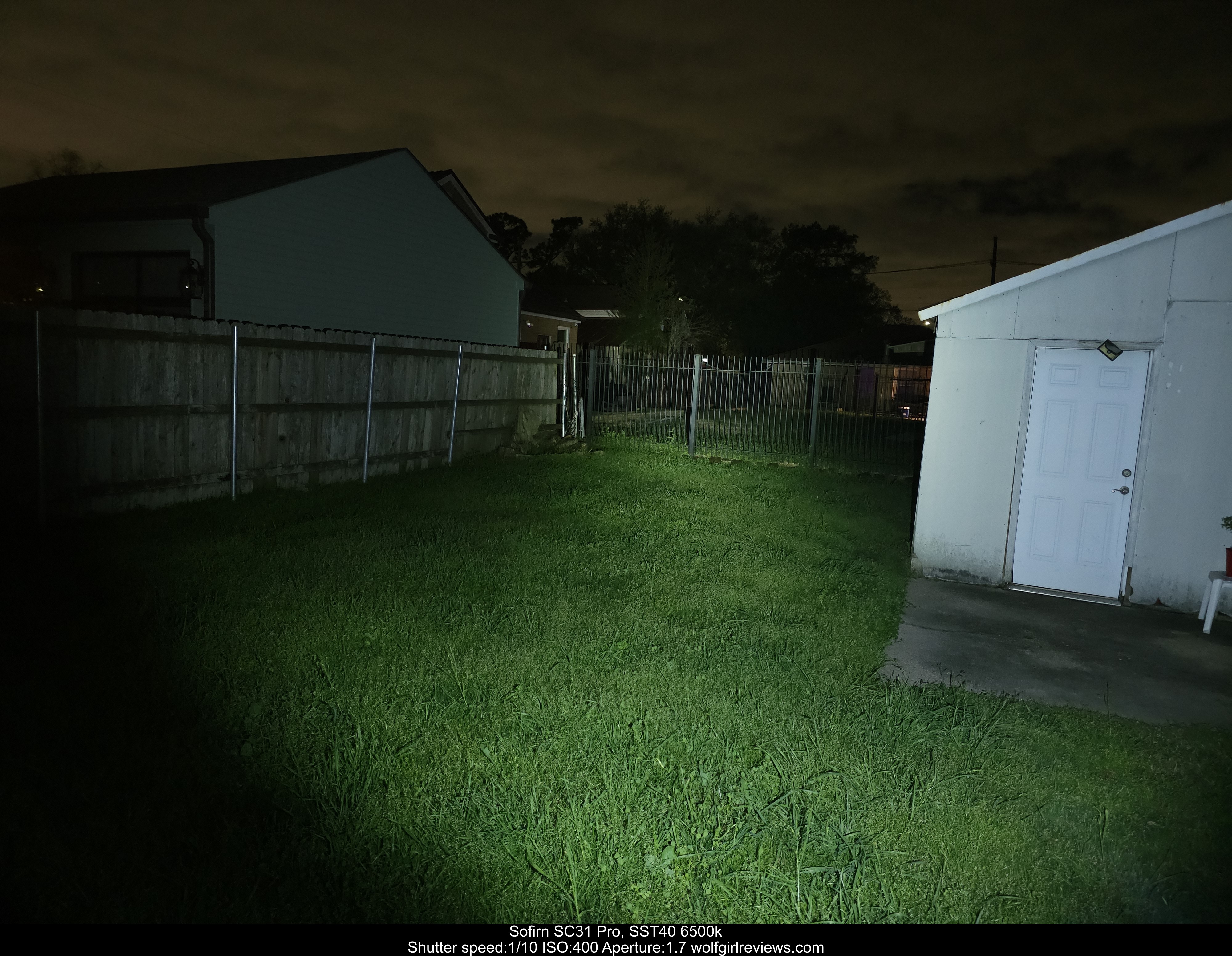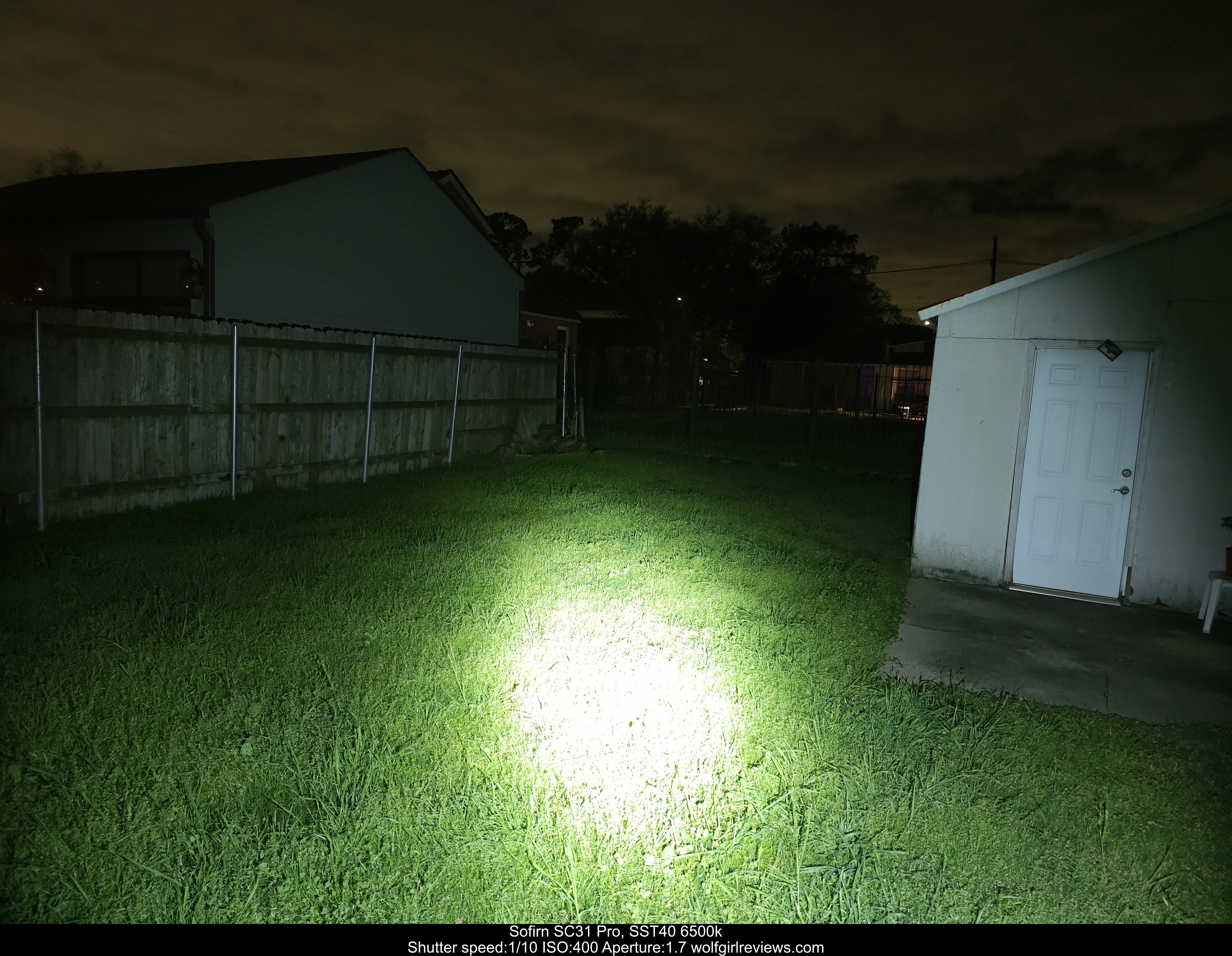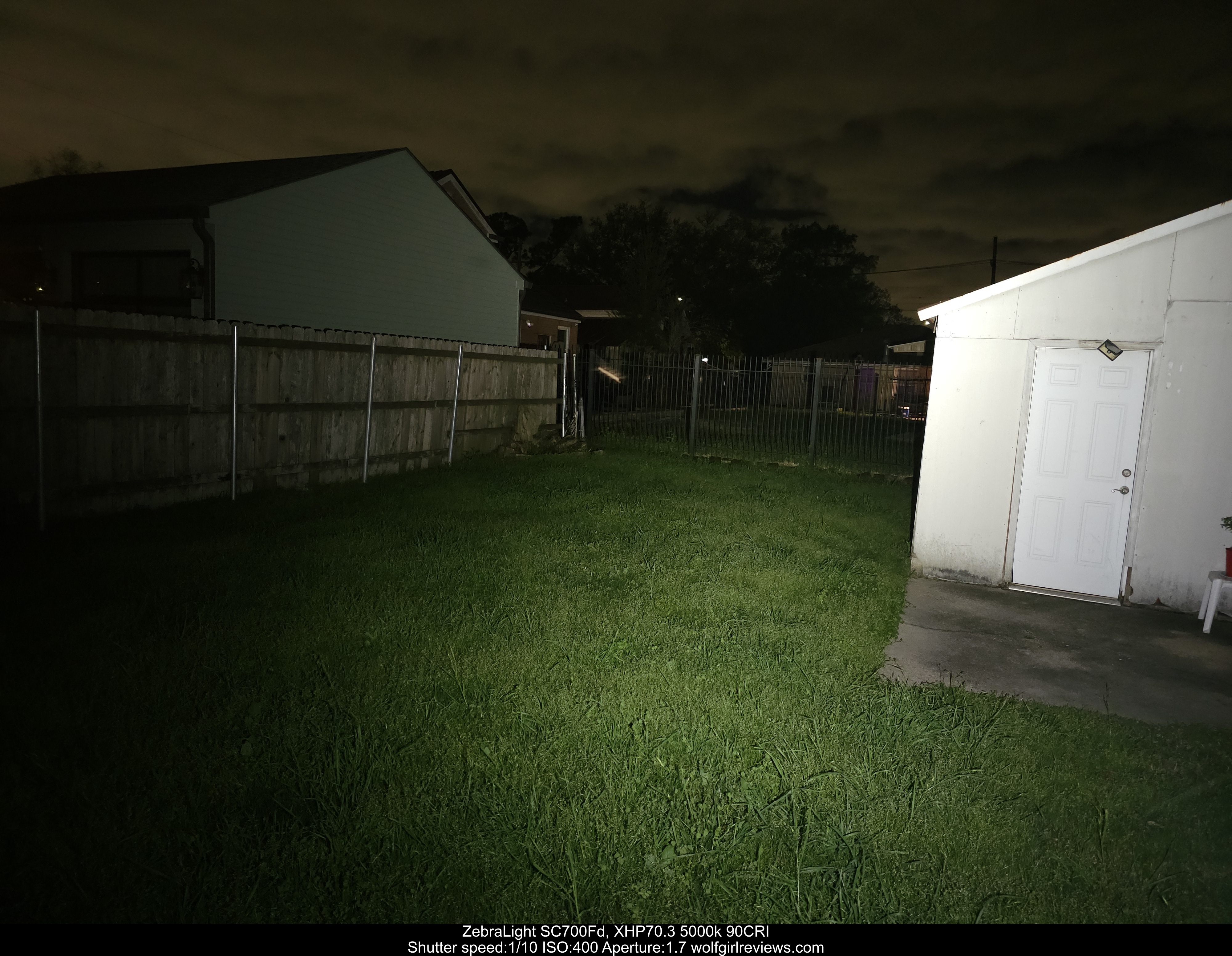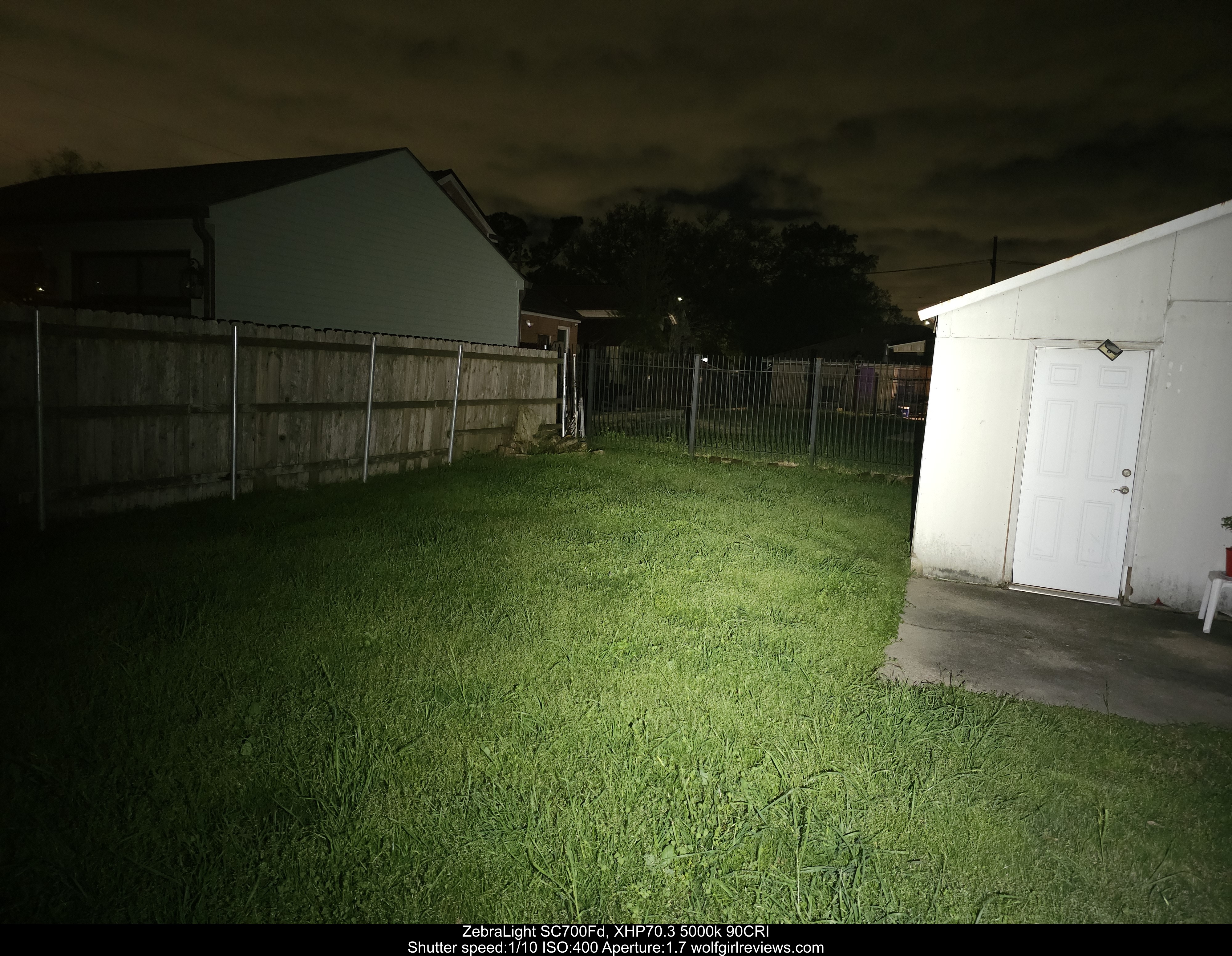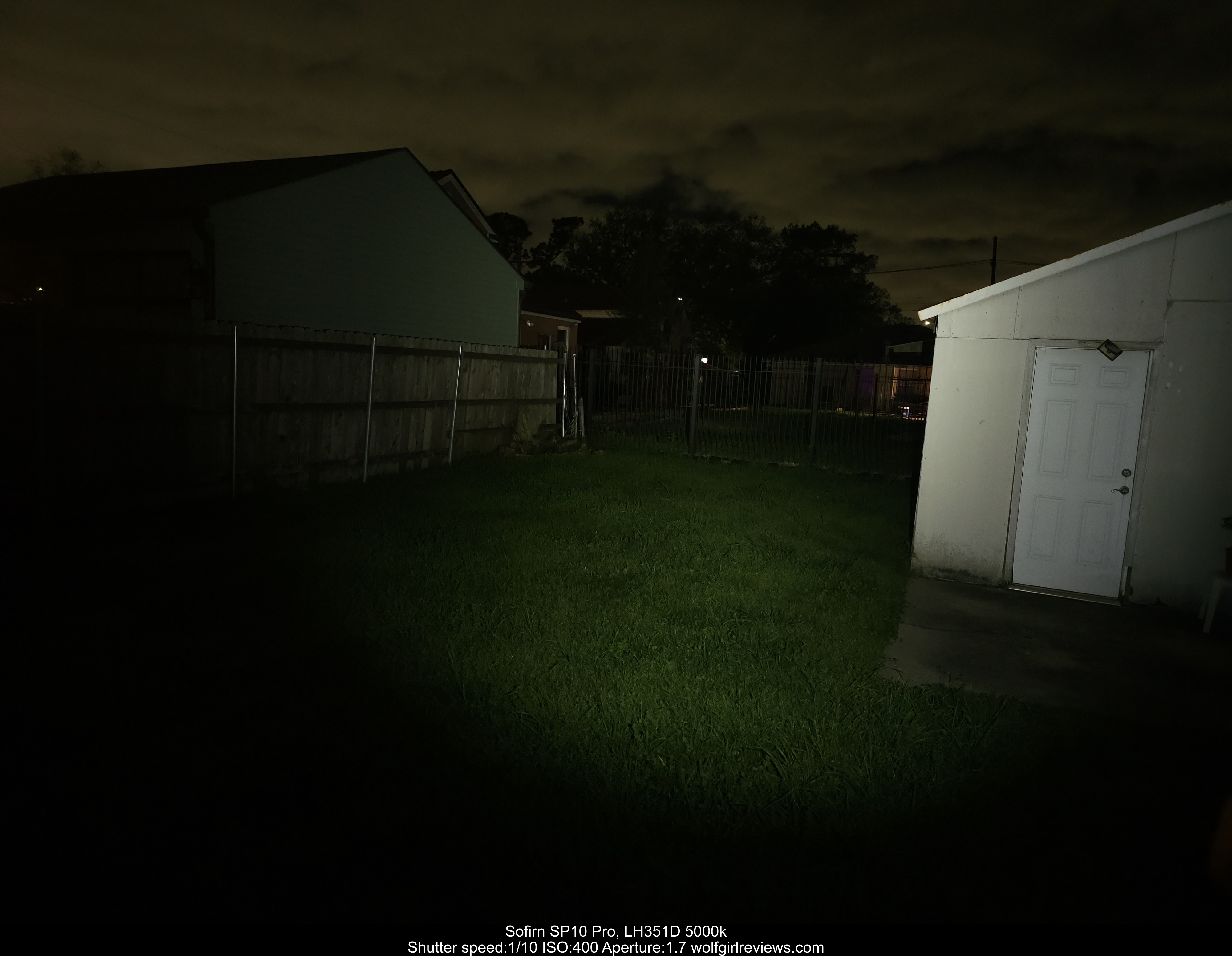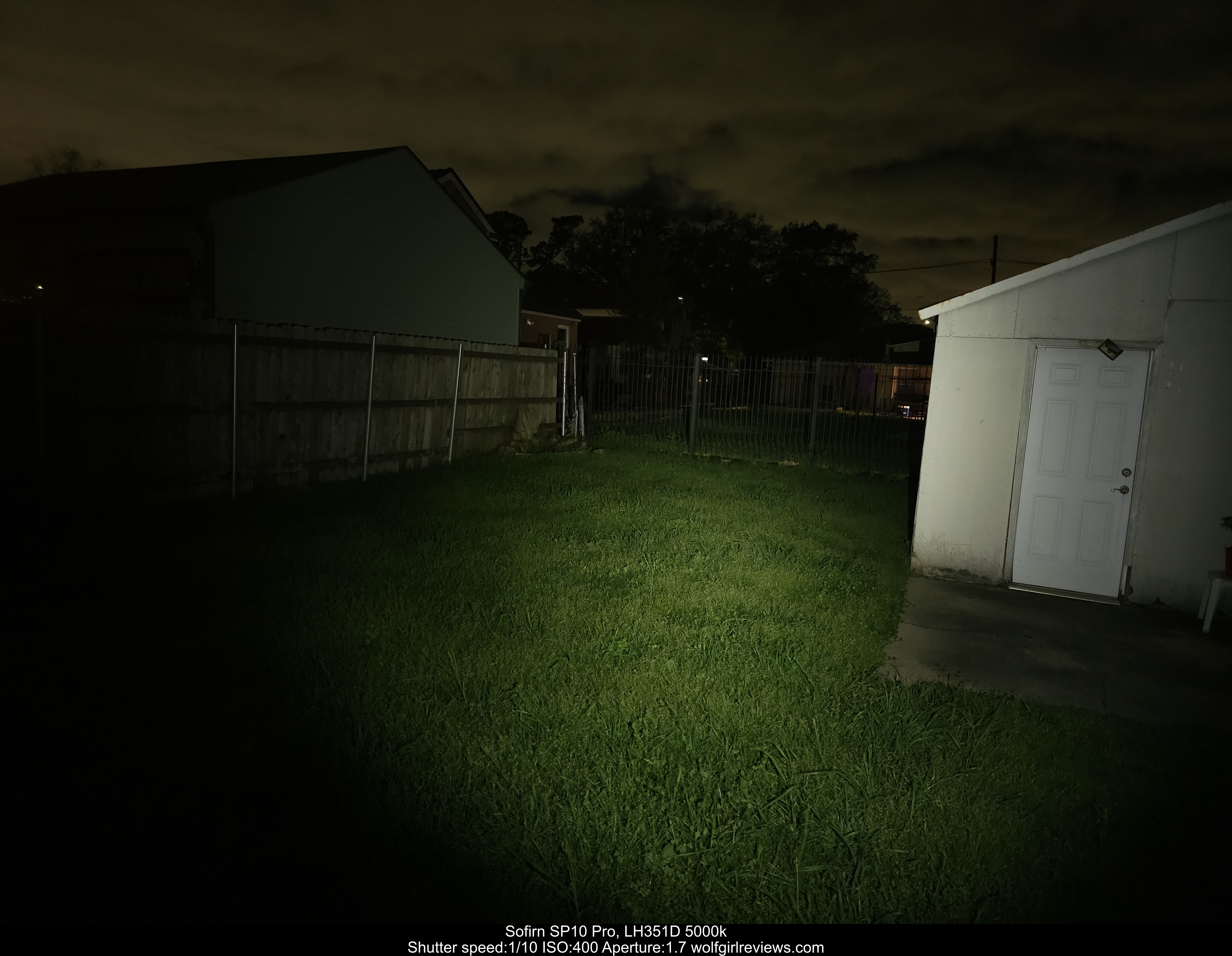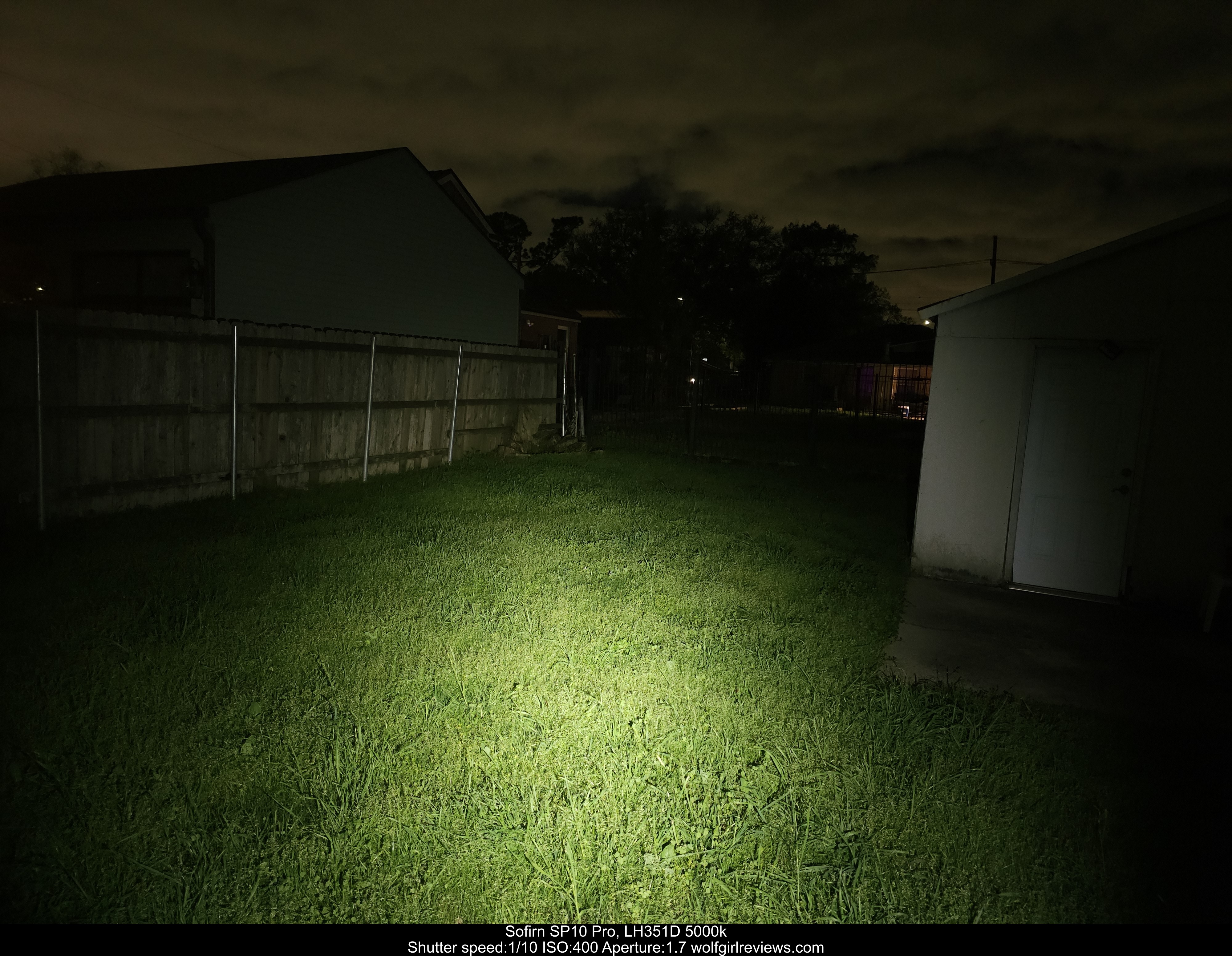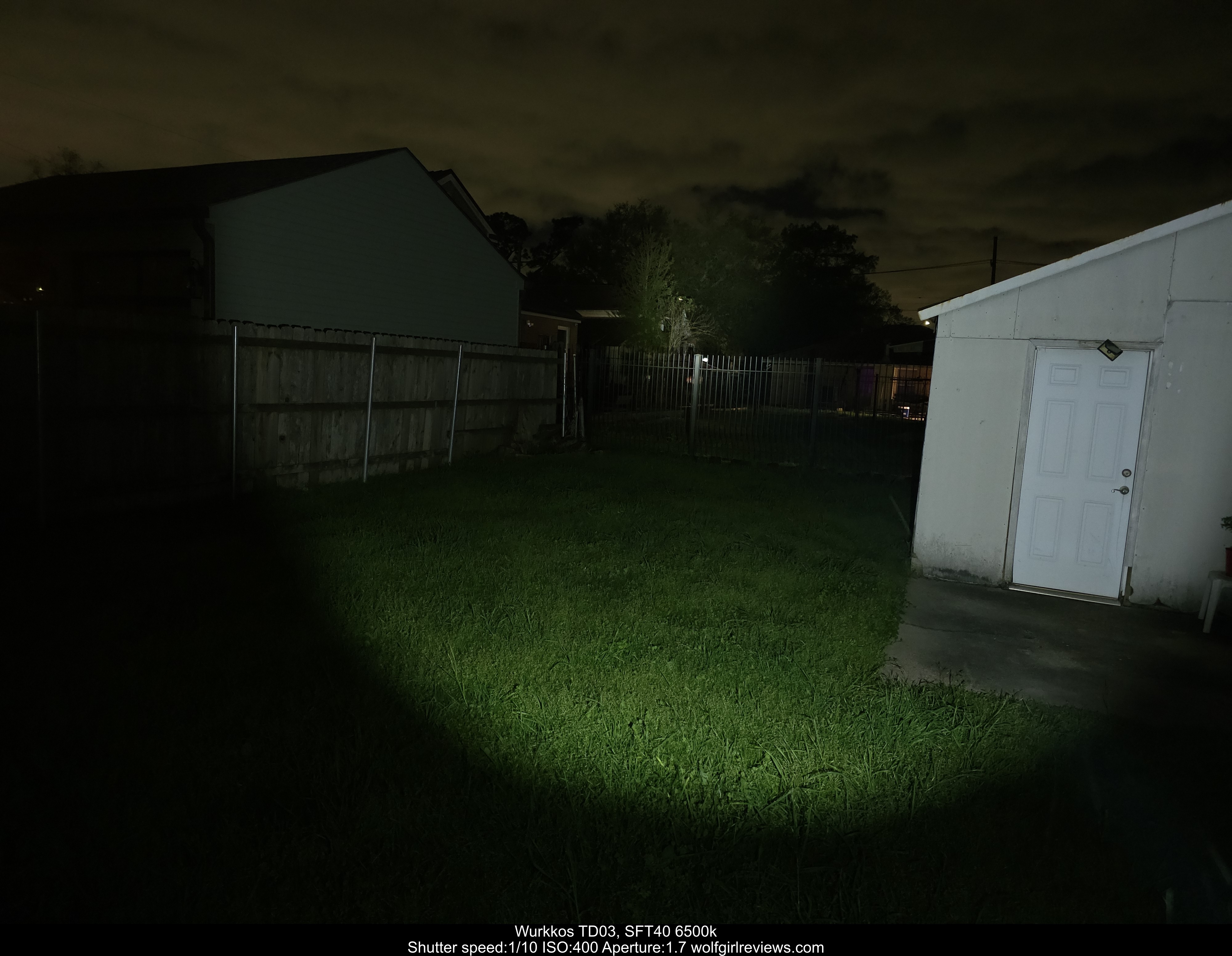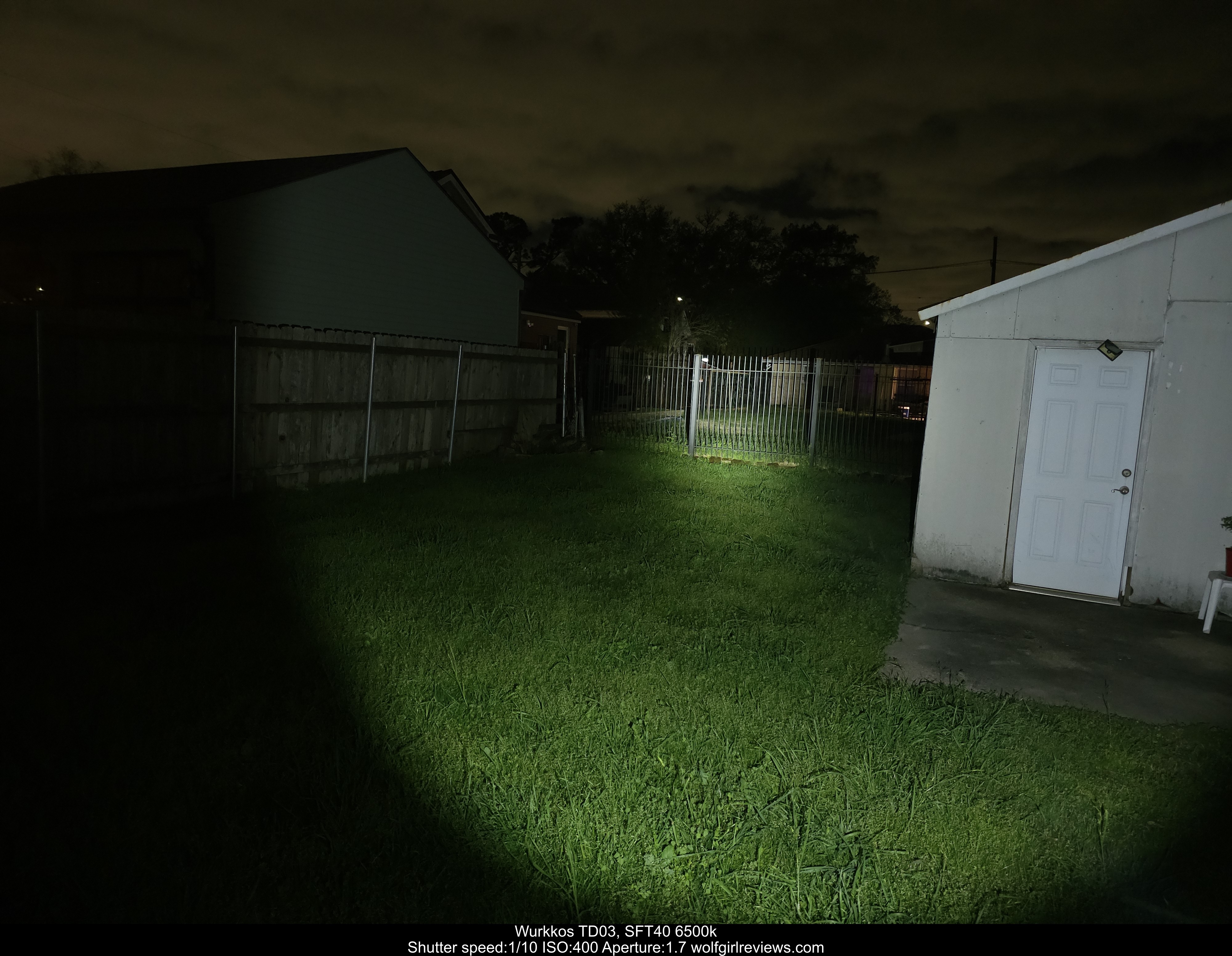"Beautiful optic. So, when's the SC29 Pro?"
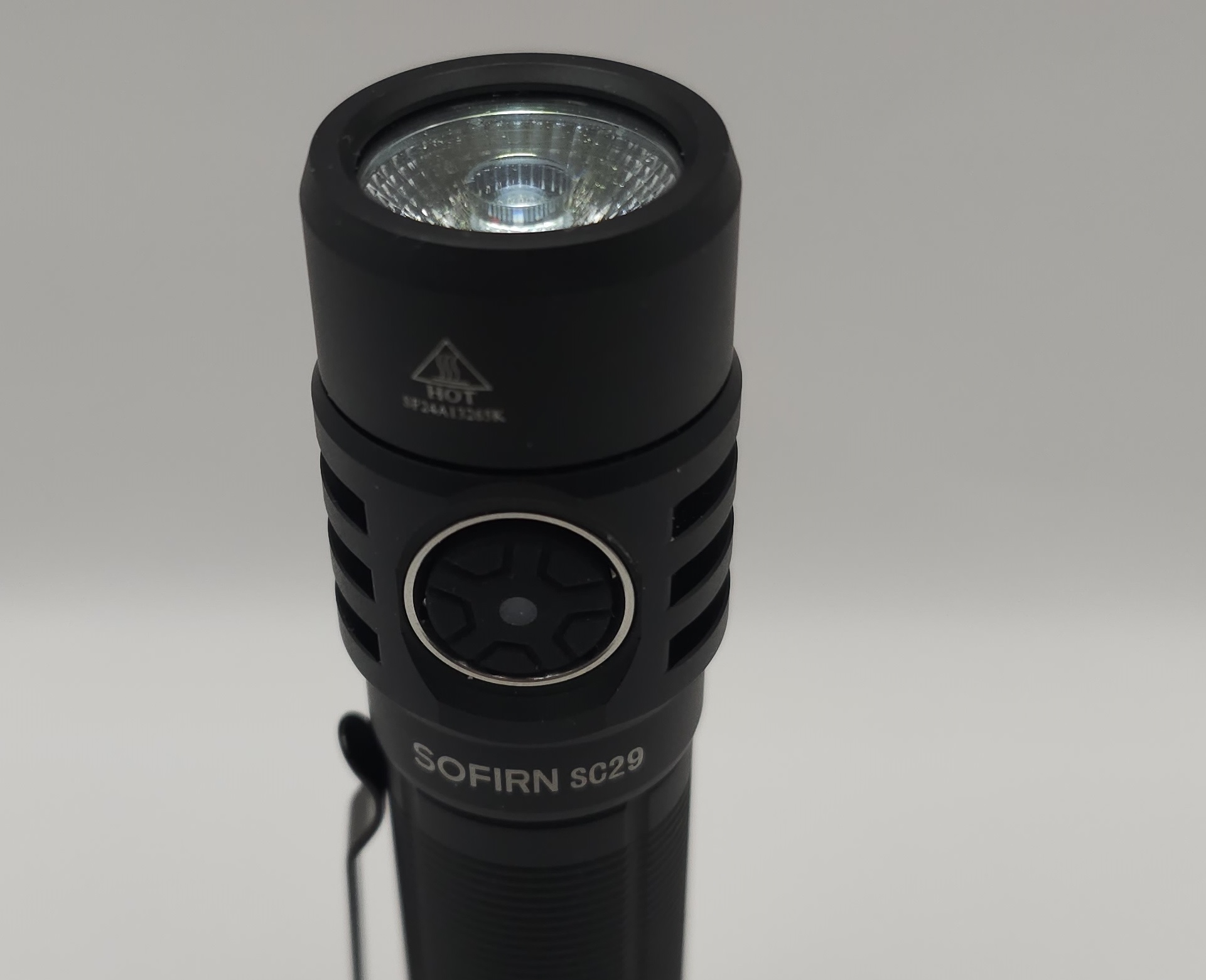 The Sofirn SC29 is an EDC sized 21700 light rated at 3000 lm, with an XHP50.2 behind a unique TIR optic.
The Sofirn SC29 is an EDC sized 21700 light rated at 3000 lm, with an XHP50.2 behind a unique TIR optic.
Introduction, Background, and Official Specs
To most enthusiasts, Sofirn need no introduction, having a long history of lights focused around value for money and catering to everyone from casual users to enthusiasts. In terms of Sofirn's market range, the SC29 seems targeted towards the middle, being a 21700 light with a somewhat high output and an interesting and unique TIR optic, although equally, this is not a "hotrod" and has "Simple UI" as a selling point, in my opinion overall placing it solidly in the middle of the market, where it generally falls into the "large EDC" category, and has a focus in its design on value and runtime.
Official specs:
| Parameter | Official Value | Measured |
|---|---|---|
| Output (turbo) | 3,000 lm | 2,980 lm |
| Runtime (turbo) | 4 hours | 6 hours 1 min |
| Intensity (turbo) | 11,433.3 cd (214 m) | 16,272 cd (255.1 m) |
| Output (high) | 1,000 lm | 1,043 lm |
| Runtime (high) | 5 hours | 6 hours 39 min |
| Intensity (high) | 4,591.7 cd (136 m) | 4,761 cd (138 m) |
| Output (medium) | 350 lm | 395 lm |
| Runtime (medium) | 6 hours | 6 hours 40 mins |
| Intensity (medium) | 1,695 cd (82 m) | 696 cd (52.8 m) |
| Output (low) | 30 lm | 43 lm |
| Runtime (low) | 50 hours | 58+ hours |
| Intensity (low) | 188.3 cd (27 m) | 117 cd (21.6 m) |
| Output (moon) | 1 lm | 1 lm |
| Runtime (moon) | 500 hours | |
| Intensity (moon) | 10.8 cd (7 m) | |
| IP rating | IP68 | |
| Impact resistance | 1 m (3.28 ft) | |
| Weight (without battery) | 2.7 oz*(76.5 g) | 97.9 (167.3 g with Sofirn 21700 battery) |
| Head diameter | 29 mm | 30.3 mm |
| Bezel diameter | 29.0 mm | |
| Length | 120.8mm | 120.9 mm |
| Body diameter | 25.9 mm |
I was sent this light for free by Sofirn in exchange for a review. I am not receiving any commission for sales, and am giving my honest opinion without holding back on any negative experiences or overstating any positive. I may use affiliate links to Amazon or similar sites for things such as measuring equipment I use, but do not otherwise have any related interest in anything I mention.
* This was the only weight specified on the product page. Given the discrepancy in weight I measured, this is enough not even be explainable as being without the clip, so is possibly an error in unit conversion or rounding, as a difference of close to 20g is notable.
First Impressions, Physical Design, and Build Quality
The SC29 uses Sofirn's standard packaging, a retail-level printed cardboard sleeve over a relatively nice quality box. Inside, the SC29 is inside a foam insert with the lanyard and two spare o-rings inside a bag loose on top, and a box in its own dedicated slot containing the manual and a USB A-C cable. The manual is in English, Chinese, French, German, Russian, and Spanish. The USB cable is of above average quality. A non-reversible clip is preinstalled, snapped into a groove near the tailcap. This is not a true deep carry clip, but still rises around a third of the way up the tailcap. The clip is of the type that snaps into a groove, and rotates freely with relatively little force, although after carrying with the clip I did notice some light scratching of the anodisation within the groove, so expect this to compound the more the clip is used.
On the head of the SC29 there are three relatively wide cutouts that are probably as much for aesthetics and weight savings as for thermal performance. On the front of the head, the switch is a design that Sofirn have used in several of their newer lights, and sits inside a shallow oval cutout on the head with a thin steel bezel sitting flush with the surface of the head. In Sofirn's marketing material, this switch is described as a "Unique Concave Switch" which is described as being designed to reduce the chance of accidental activation. In practice, I found the switch surface felt almost perfectly flat to me, and while I would not call it an easy switch to accidentally actuate, it is definitely average and not hard to use, and can be used with no problems with gloves on. Fortunately, the light does include a lockout mode. The middle of the switch is clear, with a red/green LED. "SOFIRN SC29" is printed underneath the switch at the bottom of the head, and on the bezel is the usual "HOT" marking along with a serial number. The opposite side of the head features a USB-C charging port, with a relatively large rectangular rubber flap, which sealed well into the cavity when not in use. Sofirn rate the SC29 as IP68, or for 1m depth. This is not a light I would deliberately take into water due to the charging port, and I did not get a chance to test it in the rain, but the seal of the flap makes me confident it would almost certainly survive at least a brief drop into water.
Inside the light is a Sofirn-branded 5000mAh flat top 27100 battery, and the familiar paper shipping insulator. Inside the head, there is a brass post for the positive contact, and a press-fit spring inside the body tube, with the current path being the top edge of the body tube contacting the edge of the driver. There is a magnet inside the tailcap, which is not particularly strong - it is enough to hold the SC29 onto a relatively thick metal surface, but not a thin one and is unlikely to cause it to unexpectedly snap to a metal surface with enough force to cause injury if done unexpectedly. The design of the tailcap indicates that the magnet could probably be removed, although this would require a high degree of compression of the spring to get it out of the way first, as the shelf that retains the tailspring extends relatively deep into the tailcap. The SC29 ships with an unprotected flat top battery, and the driver has a button style contact - unprotected button top 21700 batteries work fine, while a protected button-top with USB did work, but the tailcap did not tighten all the way, leaving the o-ring slightly exposed.
The surface finish was perfect, with no imperfections, and a slight matte finish. It does not feel like HA III, but the process that Sofirn are using does feel consistent and stood up well to carrying. On the battery tube, the knurling is a series of concentric lines, which provides adequate grip without feeling rough, and the tailcap has large flattened-off sections that resemble those on the Noctigon KR series or some Astrolux lights. There is a single lanyard hole in the tailcap, which goes through from the side to the top edge, so attaching the lanyard will slightly reduce the light's stability when tailstanding, although overall the size of the tailcap does mean it is still possible. Anti-roll protection is primarily provided by the installed clip, and if this is removed, the face of the switch is large and flat enough to stop a low energy roll.
The SC29 features a unique beaded TIR optic, which certainly looks attractive when the light is not in use, showing the yellow of the phosphor from a relatively wide angle, and providing good diffusion when the light is on, with a wide, smooth hotspot without any noticeable beam artefacts. The lens does not appear to be AR coated, and is set somewhat deeply into the aluminium bezel for protection.
Sofirn's warranty is described on their website and is covered via the seller for the first 30 days, then free replacement from Sofirn for the first 12 months, or 6 months for defective batteries.
Size Comparison
I took comparison photos of the SC29 as well as several other EDC sized lights.
- Sofirn SC29
- Sofirn SC31 Pro
- Emisar D1v2
- Emisar D4K
- Wurkkos FC13
- Wurkkos TD03
- Zebralight SC700Fd
- Skilhunt M300
- Sofirn SP10 Pro
- Convoy S12
- Lumintop FW1A Pro
User Interface
| State | Action | Effect |
|---|---|---|
| Off | 1C | On (mode memory) |
| Off | 1H | Moon |
| Off | 2C | Turbo |
| Off | 3C | Lockout |
| Off | 4+C | (Nothing) |
| On | 1C | Off |
| On | 2C | Turbo |
| On | 1H | Cycle brightness (stepped) |
| Turbo | 1C | Previous mode, see below |
| Turbo | 2C | Strobe |
| Moon | 1H | Exit moon to low |
| Moon | 2C | Turbo |
| Lockout | 1C | Blink twice |
| Lockout | 1H | Momentary moon |
| Lockout | 3C | Unlock (to on, mode memory) |
This is a relatively simple stepped-only UI, which follows some standard conventions, but is still somewhat bare in features. There is a lockout mode, but it is on 3C rather than the 4C that is more common. There is no battery check mode or configurability of any sort, and moonlight mode is only accessible from off, combined with the inability to adjust brightness downwards, plus forced mode memory always being on, means you always have to go through either high or off to go from medium to low. With only three 'normal' modes, this is at least less annoying than having to cycle through many high modes, but is still enough that an unexpected moment of high output could ruin night vision for the unprepared.
Turbo mode has some unique, and in my opinion undesirable behaviour - if you enter turbo directly with 2C from off, 1C will exit turbo and switch the light off, as is true with most e-switch lights, however, if you entered turbo with 2C when the light was already on, 1C will exit back to the prior level but not turn the light off. Normally, 2C is used to exit turbo mode without switching the light off, but in the UI, strobe mode is not directly accessible from off or the standard levels, but instead is from 2C while already in turbo. Personally, I find hidden strobes preferable in general, and turbo is a decent place to hide it, as if strobe is to be used in a self-defence scenario then going to turbo first before using strobe is a reasonable assumption, while accidentally entering 3C and getting strobe directly from off tends to lend itself to accidents easily in my opinion, but I do instead often find myself frustrated that I can not switch the light directly off from turbo.
A lockout mode is present, but on 3C instead of the more familiar 4C - overall, I am happy that lockout was included as some very basic e-switch UIs do not, but I would have preferred lockout mode on 4C like the majority of lights as this is that is in my and most other enthusiasts' muscle memory, although it could be argued that this light is aimed more towards nonenthusiasts overall where having a set of button shortcuts with no gaps is arguably an advantage (although equally, it means there is a leaning curve if graduating to more advanced UIs).
I'd have preferred to have seen a battery check mode on 3C, even if just a simple 4 or 5 "bar" mode such as Zebralight or Convoy's, and lockout on 4C. One positive here and criticism I have of the UIs on some of Sofirn's other non-Anduril lights is extremely short forced autolock timers, which is thankfully not the case here, as there is no autolock of any type. Actuation in a pocket is possible with the large switch, and the SC29 may get hot enough to be uncomfortable but is less likely to actually burn fabrics than some other higher powered lights, especially since, as discussed in performance then the stepdown from turbo is very rapid, but overall this is still a light I would recommend carrying while locked only. The switch's LED is solely used as a battery indicator when powering the light on (similarly to Acebeam's battery indicator, this is a simple two-colour LED where green means "anywhere from full to low" and red means "critically low", and can not be used as an indicator for location or to show battery status at any time other than when the SC29 is first switched on.
| What it gets right | What it gets wrong |
|---|---|
| Gets the basics right - 1C on/off, 1H to change brightness | No ramping UI, stepped only |
| Strobe mode is reasonably accessible without being easy to accidentally activate | No battery check mode or control over switch LED |
| Electronic lockout mode without forced automatic lockout | Some button shortcuts are counterintuitive |
| Mode spacing is decent for so few modes | No way to go backwards through modes other than via off and moon |
Using the Light
The SC29 is overall a floody light, with the TIR optic providing a very smooth, even, and wide hotspot with moderate spill. In terms of carryability, the SC29 is of average length for a 21700 light, with a moderately narrow head for a single emitter light, and average weight. The tension on the pocket clip feels about right, being possible to clip and unclip one-handed without excessive effort, but not loose enough tat it feels easily at risk of falling, and the longitudinal cutouts on the battery tube have low pocket-shredder factor. Although the number of modes is fewer than I would normally like to see, three (plus turbo and moon) is still sufficient for many use cases, and I do have to remind myself to be fair sometimes when "Simple UI" is a selling point, and while many enthusiasts would demand finer brightness adjustment, overall the spacing of modes feels reasonable. In terms of weight, the SC21 is enough that you won't forget you are carrying it, but without being excessive, and overall it fits comfortably in a pocket or bag. Ergonomically, the light fits well in my hand, and the switch is a comfortable place to rest a thumb. Even when used on turbo, the SC29 gets warm but not excessively hot, and will step down thermally long before it becomes uncomfortable to hold. When doing a test run from turbo, the SC29 reached a peak temperature of 45.6 degrees C (114 freedom eagles) at 58 seconds into the run before the temperature started to gradually drop, ending up at around 38-39 (102-104 F) when output had dropped to a stable level. I measured the temperature using a TC001.
For occasional light use, the 21700 battery is more than sufficient, although in the case of heavier use, the lack of a battery check mode is a weakness, as the only reliable method of determining the battery level is by observing the output on high or turbo. In addition, due to the driver design, output starts to drop off relatively quickly from repeated use on turbo for anything more than a short burst. The LED in the switch will start blinking red when the battery is very low, but at this point during my testing, the light had already entered LVP when the LED started blinking, but otherwise the only battery indication is the LED lighting briefly when the light is switched on, but this only really serves as an indication that the battery is not critically low, as I observed a green LED as low 3.5V, well into what I would consider a low battery situation overall. However, the SC29 is capable of running for a very long time on a low battery; the indicated runtime for low is 50 hours; I tested the runtime and was still recording 17lm at 58 hours when my datalogging setup ran out of disk space; at this point then the battery was still at 3.24V - the included user manual states that low voltage cut-off is at 2.7V so I would guess there was at least another 6-12 hours left at this point.
In terms of practical use, I found the SC29 more than capable of most tasks around the house, and when walking, it performs well for seeing where you are going at close range, although if doing something like walking a dog in an open area, you will find yourself relying on turbo a fair amount to get more distance, but when on turbo, the beam profile has enough balance to provide reasonable medium range performance. While the LED is 6500k and low CRI, which is enough to make some CRI and CCT purists run away screaming, overall the optic manages to compensate for any tint shift well, with only a small amount around a wide hotspot and some relatively good consistency between the hotspot and spill.
Driver and Emitters
Sofirn are generally not known for pushing the envelope on driver technology, and instead sticking to well-proven designs with good value for money, and the SC29 is no exception here - the driver appears to be a linear regulator type, although one with relatively high efficiency at the lower levels, in my testing exceeding runtime specs on low by a significant margin in mildly cold conditions. The driver seems well-implemented for what it is, with consistent output across levels, and no visible PWM at any level. Some efficiency-oriented enthusiasts would likely rather see a boost driver and an XHP70, but since price is clearly a consideration in the SC29's design, it is at least a reasonably well-implemented linear.
For the SC29, Sofirn only offer one emitter option, a Cree XHP50.2. On the box this is described as "5700-6500k" - 5700k and 6500k are two different bins so I am not sure if this means Sofirn are using both bins, or just a binning with wider steps than usual. My example tested between approximately 6000k from low to turbo, although dropping to around 5400k on moon. Since a TIR usually causes a CCT drop of ~2-300k, this would place the emitter closest to 6500k, although I would be interested to see what other tested examples come out as. The emitter is the 3V version, which is only available in low CRI, and these domed Cree emitters are well known for tint shift, but this is compensated for somewhat by the optic.
My guess is that the 5700k-6500k spec indicates that Sofirn is using a very wide bin of XHP50, so other examples of the SC29 might look different to mine in terms of CCT and tint.
Overall, the SC29 is one of the nicer subjective beam quality lights with the XHP50.2 that I have tested, as the optic does a good job of diffusing the beam enough that while there is still some tint shift present, it is mostly limited to a relatively small corona around the hotspot and not present to any significant degree in the spill, and there are no artefacts visible with the entire beam being consistent as the light is rotated in my hand. The LED itself has negative DUV at all levels,and while it is definitely still cool white overall, it is a pleasant tint and lacking any excessive green.
This emitter choice is likely still going to be less preferred by enthusiasts than something like the SFT40, but on balance I am happy that Sofirn opted for this one over the SST40. Overall, the tint shift can be ignored and even if white wall hunting, the beam is not unpleasant, and possibly the best beam I have seen from an XHP50.2 light, although overall it would have been nice to see a high CRI option as well, possibly SFT40 3000k would be a good option, as the high CRI XHP50 are not available in 3V configuration.
I measured the SC29's CCT and CRI with a Colormunki Photo and ArgyllCMS.
CRI and tint
Power and Charging
The SC29's USB-C port is built into the head, behind a relatively standard looking rectangular rubber flap of a type found on other Sofirn lights. This fits tightly into a relatively deep cutout, giving a reasonable seal against water and dust, and I would definitely consider the light at least safe from a brief dip into water, but would also not deliberately submerge it. The onboard charging circuit works with both USB A-C and C-C cables, and was able to successfully charge from both USB PD and QC2.0 adapters, although the charge rate was a little higher than I would charge a 21700 battery under ideal circumstances, with a starting current of 1.3A and a peak of 1.6A, this is still low enough not to cause a massive amount of unnecessary battery wear, and can be forced to charge at a lower rate by connecting to a port with a maximum output of 1A or 500mA.
The SC29 does not feature a powerbank mode, and nothing happened when connecting it to various USB devices.
Charging data was collected using rd-usb with an RDTech TC66C (info, Amazon (US).
The SC29's manual indicates that low voltage cutoff is at 2.7V, and in my testing I found this accurate, although difficult to test as the light will run at a low lumen output for an extremely long time before going low enough. When the light did cut off from low voltage, I was able to instantly switch the light back on and even enter turbo, although LVP would cut in again relatively quickly afterwards.
Overall, charging happened at a reasonable rate, although still a little higher than I would have ideally liked to see for any 21700, as 1.6A is fine for high and medium quality batteries but may cause some reduction in useful life, particularly if charged while hot, but the charging did not become even warm to the touch, and terminated at or below 4.20V each time I tested it. Both A-C and C-C charging worked.
Moddability
The SC29's bezel is not glued and was easy to remove, with the TIR optic friction fit into the bezel, the MCPCB was easily accessible for an emitter swap. Accessing the driver requires desoldering the leads to the MCPCB, and there is no retaining ring. The driver is 22mm in width. The tailspring and the magnet behind it both appear to be glued in place, but could be removed with some solvent and persistence.
Performance
All lumen measurements taken using a 4.5 inch Texas Ace lumen tube. Candela measurements were performed indoors at a distance of 4m, using a UNI-T UT383BT datalogging luxmeter.
Runtime tests were performed using the lumen tube's HS1010A luxmeter, which the tube is calibrated for, with data recorded via taking a video, exporting the individual frames using ffmpeg, and parsing the value on the luxmeter's display at the appropriate frame for each measurement. I logged the value every second for the first 90 seconds, then every 5 seconds up to 30 minutes, every 30 seconds up to 3 hours, then every minute past that point. The SC29 maintained a stable output when not throttling thermally, with no sharp drops for LVP when running down from a higher level. The switch LED started blinking red when the light dropped to around 10lm with the battery nearly depleted, but it was capable of running for an extended time in this state before finally cutting off completely from 1lm with the battery at ~2.75V.
Specs
Official output spec is 3,000 lm on turbo, and candela spec is 11,433.3 cd. As the performance of the SC29 is not exceptionally high, a 5% margin of error on all measurements is reasonable; in general Sofirn's performance figures tend to be realistic.
| Spec | Measured | |||||
| Level | Output (spec) |
Intensity (spec) |
Runtime (spec) |
Output (measured) |
Intensity (measured) |
Runtime (measured) |
| Turbo | 3,000 lm | 11,433.3 cd | 4 hours | 2,980 lm | 16,272 cd (255.1 m) | 6 hours 1 min |
| High | 1,000 lm | 4,591 cd | 5 hours | 1,043 lm | 4,761 cd (138 m) | 6 hours 39 min |
| Medium | 350 lm | 1,695 cd (82 m) | 6 hours | 395 lm | 696 cd (52.8 m) | 6 hours 40 mins |
| Low | 30 lm | 188.3 cd (27 m) | 50 hours | 43 lm | 117 cd (21.6 m) | 58+ hours |
| Moon | 1 lm | 10.8 cd (7 m) | 500 hours | 1 lm | ||
Output and Throw
| Mode | Peak output | Output after 30s | Output after 1 minute | Output after 90s | Output after 5 minutes | Output after 15 minutes |
|---|---|---|---|---|---|---|
| Turbo | 2,980 lm | 2,760 lm | 1,000 lm | 410 lm | 410 lm | 400 lm |
| High | 1,043 lm | 1,018 lm | 1,010 lm | 1,004 lm | 470 lm | 364 lm |
| Medium | 395 lm | 388 lm | 386 lm | 384 lm | 379 lm | 373 lm |
| Low | 43 lm | 43 lm | 43 lm | 43 lm | 43 lm | 43 lm |
| Moon | 1 lm | 1 lm | 1 lm | 1 lm | 1 lm | 1 lm |
| Mode | Peak candela | Candela after 30s | Candela after 1 minute | Candela after 5 minutes |
|---|---|---|---|---|
| Turbo | 16,272 cd (255.1 m) | 8,019 cd (179.1 m) | 2,178 cd (93.3 m) | 2,169 cd (93.1 m) |
| High | 4,761 cd (138 m) | 4,671 cd (136.7 m) | 4,626 cd (136 m) | 1,980 cd (89 m) |
| Medium | 696 cd (52.8 m) | 696 cd (52.8 m) | 692 cd (52.6 m) | 680 cd (52.2 m) |
| Low | 117 cd (21.6 m) | 117 cd (21.6 m) | 117 cd (21.6 m) | 99 cd (19.9 m) |
Overall, the SC29 has decent performance for a non-enthusiast-oriented light, likely helped by the choice of emitter. Despite the use of a linear driver, runtimes overall are reasonable, exceeding spec in my testing, although output on the lower levels was higher than spec, they are in my opinion still low enough that low will not significantly disrupt night vision, and while I prefer a moon mode that is accessible without having to first switch the light off, it is at least present and as such also serves as a shortcut back to low mode without having to go through high.
Runtime
| Mode | Runtime |
|---|---|
| Turbo | 6 hours 1 min to 0 lm |
| High | 6 hours 39 min to 6 lm |
| Medium | >58 hours to 17 lm |
Performance Overview
The SC29 meets its spec of 3000lm on turbo, although has relatively poor sustained output, with a sharp dropoff as the light starts to warm up. However, runtime at low levels is relatively good - I attempted to test the low runtime and my datalogging setup ran out of space after 58 hours, at which point the SC29 was still making 17lm and the battery was at 3.21V. Even from high, when the battery is low, overall it will provide several hours of usable light before powering off completely. Combined with the high capacity battery, this makes it a reasonable choice for a light that does not get particularly heavy use but can still be relied on in an emergency situation, although it is worth remembering that turbo has a very short runtime at high power so is better for a quick look around than any serious extended illumination at that level.
Beamshots
Lights used:
- Sofirn SC29 (XHP50.2 5700-6500k, measured at 2980 lm)
- Sofirn SC31 Pro (SST40 6500k, measured at 1950 lm)
- Emisar D1v2 (XHP70.3 HI 4000k 90CRI, measured at 2400lm)
- Wurkkos FC13 (XHP50.2 5000k, measured at 3450 lm)
- Wurkkos TD03 (SFT40 6500k, measured at 1450 lm)
- Zebralight SC700Fd (XHP70.3 5000k, measured at 2160 lm)
- Sofirn SP10 Pro (LH351D 5000k, measured at 800 lm)
- Skilhunt M300 (144ART 4500k, measured at 2100 lm)
- Lumintop FW1A Pro (XHP50.2 6500k, modded with lume1 driver, measured at 4300lm)
SC29
Comparison Beamshots
Competitors
Sofirn SC31 Pro - The SC31 Pro fills a similar niche to the SC29, being a single-emitter single-cell light that is not quite a tube light, but still has a relatively narrow head. Comparing the two, the SC31 Pro has a smooth reflector vs the SC29's TIR, a much better user interface, and a significantly inferior LED (SST40 6500k) and lower output as well as a slightly less subjectively nice beam, but a slightly throwier beam profile with a tighter hotspot, some reflector rings, and a cooler and greener tint. Ergonomically, I prefer the SC29 as a large light in the hand while the SC31 Pro is lighter, narrower, and marginally shorter. Overall, since neither of these lights is intended as a thrower, the only reason for SC31 Pro is Anduril, but it is significant enough an advantage to be worth mentioning.
Wurkkos FC13 - In some ways, Wurkkos' equivalent of the SC31 Pro, the FC13 is available with a choice of LEDs, and has overall similar physical dimensions to the SC29 despite only being an 18650 rather than a 21700 light, leading to shorter runtimes, but in return the FC13 is lighter and has a slightly less bulky head, a higher peak output with the same LED, likely due to a combination of Anduril's better thermal management and higher thermal mass in the head, an RGB switch, and a better pocket clip. Again, the user interface here is Anduril which has a significant advantage over the SC29 for enthusiasts, although the SC29 might make a better gift for someone who would be confused by the idea of a configuration menu on their light and just wants something closer to a simple on/off light. The FC13 uses an orange peel reflector, and is available with a choice of LEDs. The FC13 offers two CCTs of XHP50.2 instead of the one the SC29 does, with a 5000-5300k and a 6000-6500k bin. Sofirn are clearly using LEDs with less tight binning, so the CCT and tint of LEDs in the SC29 is likely to vary more and be more of a CCT and tint lottery. The SFT40 6500k is also offered, and likely preferred by many enthusiasts over the XHP50.2 due to generally having better tint; this is a lower output but throwier LED, with a spec of 2000lm vs the 3500 of the XHP50.2. One additional feature the FC13 has, although somewhat niche at these small battery sizes, but still potentially useful in an emergency is a USB power bank mode.
Wurkkos TS22 - This could in some ways be said to be the most direct competitor to the SC29, as it is a single emitter 21700 light with a very simple UI. Compared to the SC29, the TS22 has a higher maximum output (4500lm for the low CRI version, or 4000lm for the high CRI), a choice of emitters between either an XHP70.2 in either 5000k or 6500k, which is a domed emitter similar to the SST40 but with a higher output and efficiency, or the XHP70.3 HI 5000k with 90 CRI, compared to the 70 CRI of the other emitters; this emitter is also slightly throwier than the other options, although the orange peel reflector results in a balanced beam overall. A powerbank mode is also present here and absent on the SC29.
Emisar D1v2/D1K - The D1 is technically a thrower while the other lights mentioned here are flooders, but when configured with a floody LED, is still overall within a similar performance range. Hanklights need no introduction if you are an enthusiast, and in my opinion are a perfect balance of performance, features, and value for money. If you find the UI of the SC29/TS22 limiting and the emitter options of the FC13 not up to enthusiast tastes, this is the light for you. Excellent build quality and looks, and a slightly higher bias towards throw than other lights mentioned here, but with the less throwy LEDs available out of the 10+ options, still overall within a similar use case. Which emitters to get in a D1 is worthy of an article on its own, but my suggestion would be XHP70.3 for an overall comparable beam profile to the SC29 bu with somewhat lower output (limited by the performance of the boost driver, between 2000 and 2500lm depending on the exact LED choice) but with slightly more bias towards throw. Alternatively, if you are looking for the maximum output possible, a D1K with SFN60 6500k is capable of over 6000lm peak with a high discharge battery, or at least 5000lm in the D1v2 version with a high drain 18650. The (optional) tailcap magnet is extremely strong, much stronger than the SC13's, although Hank can also build one with a lower strength magnet by request.
Zebralight SC700Fd - Zebralight's focus is on durability, light weight, and efficiency, and the SC700Fd excels at all of these, with an XHP70.3 5000k. As this is a boost driver, this is the 12V version which is high CRI, although Zebralights are known for being a tint lottery, and lottery in the sense of "mostly losing". Turbo output spec is 2910 lm, but with a high CRI LED compared to the SC29's low CRI, this translates to a more powerful driver as well as a significantly higher efficiency. I would overall still class Zebralight's UI as "simple" but it still has a reasonable amount of hidden configurability, although one negative point is the lack of any kind of lockout mode other than undoing the tailcap slightly. Zebralight advertise their lights as having an extremely low passive drain that is lower than the self-discharge rate of a battery, so the SC700Fd is a good choice for a light that needs work at all costs, and may be stored for medium periods of time without use and not discharge its battery, although the lack of any kind of onboard charging means it may appeal less to nonenthusiasts. A key point against the SC700 are the bulkiness of the head - although it is extremely short and light for a 21700 battery light, the head has a very wide reflector. There is also no magnetic tailcap option if that is important.
Skilhunt M300 - A tradeoff between the Zebralight and more mainstream lights, the Skilhunt is also designed towards durability and light weight, having a single emitter in an orange peel reflector, a simple but well thought-out UI, and a proprietary magnetic charging system, but also takes standard nonproprietary batteries, making the charging system only optional to use. The M300 also has multiple emitter options, with a spec of 3000lm for the cool white XHP50.3 HI, 2700 lm for neutral white, or two high CRI options, either 2200lm for a 5000k XHP50.3 HI, or 1900lm for the Nichia 144ART. The M300 is a good allrounder, having built in charging and being cheaper than the SC700Fd with comparable performance, but still a higher priced option than the SC29. Skilhunt have gone for the best of both worlds with a magnetic tailcap that is also easy to remove if not wanted, and reinstall later if needed. This is a strong magnet, significantly more than the SC29's and not too far off the D1.
Convoy S2+/S21A - The classic budget light, the S2+ is a small 18650 tube light, and the S21A the 21700 version. These lights are available with a wide selection of LED options; my suggestions here would be the SFT40. Both lights again lack USB charging, but will provide nearly as much output when specced with SFT40, and have almost unbeatable value for money. The user interface is simple but not particularly well thought out, with a mode-group based configuration and many groups that have relatively few obvious use cases or that are just mirrors of other groups. Both use a reflector but can be swapped to a TIR, and there is a tailswitch reverse clicky UI where the other lights mentioned here all use e-switches; this also prevents including a magnetic tailcap.
Final Thoughts and Score
| Category | Score | Comments |
|---|---|---|
| Looks | 7/10 | The SC29 has one obvious feature that draws the eye, the unique and beautiful TIR. This optic catches light effectively at many angles and I was often finding myself just looking into it while writing this review. It even manages to give the XHP50.2 HI a reasonable beam profile, from an LED more commonly talked about positively for output than beam quality, although it does leave me wondering what could have been if the sC29 has been offered with additional LED options such as the SFT40. Other than the optic, the light is relatively visually plain, nothing outstanding in a positive or negative way about the overall physical design, but most attention will probably be drawn to the optic anyway. The USB charging port has a large rubber flap, but this is at least somewhat well hidden from a casual glance, while the switch is more visually distinct due to its silver bezel, although the feel of the two is similar so I found myself wishing it had some kind of option to use the switch LED as a locator for the dark. |
| Quality | 7/10 | The surface finish is a nice texture and look, and held up well to a few light drops from seated indoors with no obvious chipping. The clip design is not my favourite type, in particular it is on the wrong way round as I tend to favour head-up carry for lights with sideswitches, but it does not feel in danger of accidentally coming off the light. In general, Sofirn lights are well-designed and built and I did not run into any issues when using the light. The onboard charging was a little higher current than I would like to see, but was at least consistent, did not overcharge the battery, and always remained within a safe range. |
| User interface | 6/10 | It's a user interface with nothing immediately irritating that gets the basics right, although I do dislike the lack of a smooth ramp mode and the ability to cycle levels downwards without first either switching the light off or looping through high. I do appreciate how strobe is thoughtfully hidden so it is still accessible in an emergency situation, but not too accessible so someone would accidentally strobe themselves with it. I kept consistently forgetting lockout was on 3C instead of 4C, and it would not have been hard to have 4C also activate lockout if Sofirn were set on having it on 3C, although this tends to go against the more common convention of 4C. The lack of a battery check mode is a major annoyance, especially as Sofirn have done an Acebeam here in having a battery indicator that stays green until the light is well into "critically low battery" levels, then turns red... |
| Performance (absolute) | 6/10 | The SC29 meets spec, coming in at just under 3000lm on my tube, which, given a 5-10% margin of error at these levels, is comfortably within spec. Lower levels came in slightly above spec, and in general there are no problems here. |
| Performance (sustained) | 6/10 | This one was a little difficult to score. When used on high or turbo, the SC29 steps down very quickly, and without getting more than warm in the hand. However, it will run for an extremely long time on its lower levels; long enough that I was unable to fully measure the low mode. Overall, as an EDC for a nonenthusiast, an extended runtime on a low battery is arguably desirable, and 3000lm is likely enough for most casual use at the high end, although in practice this is only achievable for a very short time with a full battery, and the drop all the way down to 400lm after just over a minute is extreme enough to take some users by surprise. |
| Moddability | 6/10 | Nothing particularly special or difficult here. An emitter swap would be easy, while the tailcap looks like the magnet could be either removed or replaced by a stronger one without too much difficultly, although my intial attempts to remove the spring failed and led me to give up since I did not want to damage the tailspring before I had finished testing. |
| Practicality | 7/10 | The poor sustained output at high ramp is offset here by extremely long runtimes on low, which is arguably a good thing for a nonenthusiast who might carry a light more than they actually use it (although this is a problem with the lack of any useful battery indicator - there should be more than two levels of indication of state, or set the threshold to something high like 3.7V if it really has to be two). One thing to be careful of is that using turbo repeatedly will quickly deplete the battery, as the driver's efficiency suffers somewhat at the highest levels. USB-C charging is present and relatively fast, allowing the light to be kept charged easily. In terms of carry, the SC29 is relatively light, although not the lightest in its class, and has a decent pocket clip as long as you prefer head-down carry, although again nothing strongly special. People who prefer head-up carry are out of luck, although the dimensions are common enough that there are likely numerous other clips that fit. |
| Value | 6/10 | $46 full price does not compare favourably to the FC13, which offers better emitter choices, a much better UI, and more enthusiast-focused features at the same price point, although it is cheaper than the TS22 at $55 full price. Sofirn do have very regular sales, and the SC29 is potentially a good choice for a gift for someone who sees an enthusiast-oriented light and is interested in something with similar overall performance, but without the configurability and learning curve of Anduril. At full price, it starts to compare negatively with the TS22 for this role, with the TS22 having higher absolute and sustained performance, while the user interfaces are somewhat an even trade with each having both positive and negative points over the other. |
| Fun | 6/10 | The TIR optic is beautiful, but enthusiasts are likely to avoid it due to UI, which is most likely too simple for people who like configurable UIs like Anduril and Zebralight, and several unintuitive UI actuions for those used to other lights. Overall, this is not a light I feel I am likely to find myself picking up to play with, more a light that I would hand to a nonenthusiast who asks to borrow a light or one that I would keep in a random useful location in my home but unlikely to be spending much time in my purse. It is, however, potentially an excellent candidate for an emitter swap for modders interested in the TIR. |
| Overall | 7/10 | It's a relatively simple EDC light, with an LED that, while not the favourite of many enthusiasts, gets the job done well for average use and is likely a great upgrade as a gift for a non-enthusiast. It does drop down very hard from turbo in very little time, and uses a linear regulator where a buck driver would have allowed significantly higher efficiency, but sometimes it's easy to forget just how impressive a modern LED is if all someone is used to is AA lights, and the SC29 is well positioned for that market - the Wurkkos TS22 has better performance, but the SC29 has a nicer beam, although only in low CRI. |
In my opinion, the SC29 makes a reasonable choice as a gift for someone who is looking for a good light and not too concerned with CCT or CRI, but still appreciates the beam of a TIR rather than a reflector as found in several recent common "simple EDC" recommendations. This also perhaps slightly puts its performance into context, as unless you are using high or turbo all the time - again, easy for some us to forget that not everyone carries a minimum of 5000lm at all times ;) - then it is unlikely to leave you in the dark unexpectedly even despite the less efficient driver.
Enthusiasts may be interested in the SC29 primarily as a platform for modding, as the optic is excellent and unique as far as I am aware, but the UI and/or choice of LEDs is likely to be discouraging for some. Certainly, this is not a light I will keep carrying often, but it's one that will likely find a place somewhere around the house. Sofirn could easily add a huge amount of enthusiast appeal by making an SC29 Pro with Anduril and a choice of LEDs (SFT40 in 3000k or 5000k would almost certainly be popular) - in every way but the UI, I prefer the SC29 over the SC31 Pro, and overall I think the optic deserves to be better explored with different LEDs.
The SC29 is available from sofirnlight.com, Sofirn's official AE store, or on Amazon. At the time of release, there is an additional 25% off coupon available on sofirnlight.com for the SC29.
Thanks for reading again. Hopefully I will be getting some pace back into reviewing in the near future, I have a couple in my backlog but right now am mostly limited by time and other projects competing for my attention, but hopefully in a month or so I will be able to at least collect data faster which will improve my reviewing pace and let me get to a few lights I've been meaning to review for some time now. Hopefully it was worth the wait. As always, feedback is welcome - I am active on BLF or Reddit, both on /r/flashlight and other specific subreddits, and have started my own subreddit for review content at /r/WolfgirlReviews.
>> Home